
The Project Gutenberg EBook of The Life of an Insect, by Anonymous
This eBook is for the use of anyone anywhere at no cost and with
almost no restrictions whatsoever. You may copy it, give it away or
re-use it under the terms of the Project Gutenberg License included
with this eBook or online at www.gutenberg.org
Title: The Life of an Insect
being a history of the changes of insects from the egg to
the perfect being.
Author: Anonymous
Release Date: April 13, 2014 [EBook #45369]
Language: English
Character set encoding: ISO-8859-1
*** START OF THIS PROJECT GUTENBERG EBOOK THE LIFE OF AN INSECT ***
Produced by Chris Curnow, Tom Cosmas and the Online
Distributed Proofreading Team at http://www.pgdp.net (This
file was produced from images generously made available
by The Internet Archive)
THE
LIFE OF AN INSECT;
BEING
A HISTORY OF THE CHANGES OF INSECTS FROM THE
EGG TO THE PERFECT BEING.
PUBLISHED UNDER THE DIRECTION OF
THE COMMITTEE OF GENERAL LITERATURE AND EDUCATION,
APPOINTED BY THE SOCIETY FOR PROMOTING
CHRISTIAN KNOWLEDGE.
LONDON:
PRINTED FOR THE
SOCIETY FOR PROMOTING CHRISTIAN KNOWLEDGE;
SOLD AT THE DEPOSITORY,
GREAT QUEEN STREET, LINCOLN'S INN FIELDS,
AND 4, ROYAL EXCHANGE;
AND BY ALL BOOKSELLERS.
LONDON:
R. CLAY, PRINTER, BREAD STREET HILL.

PART I.—THE EGG.
PAGE
Chapter I.—The Nest.—The Microscope and Telescope—Terror caused by Insects—Death-watch—Life-boat of Eggs—The Water Beetle—Floating Ark of Eggs—The Gnat—her difficulties—her Egg-raft—The Sand-boring Wasp—Towers of rubbish—Captive Caterpillars—Wood-boring Bee—An Insect Nursery—Escape of the young—Tapestry Bee—A Nest lined with Poppy-flower Petals—Enchanted Leaf-tubes—The spell broken—The Insect Sorcerer—Nest of Down made by a Moth—The Lackey Moth—The Ichneumons—Their usefulness
Chapter II.—Structure and contents of the Egg.—Its Shape—Remarkable mistake about an Insect—The Lace-wing Fly—Eggs carved on their surface—Colours of Eggs—Changes of Colour—Eggs of the Garden Spider—Pretty Nests—Anatomy of the Egg—Contents of the Egg
Chapter III.—Life begins in the Egg.—Spring Time—Influence of Heat and Cold—Eggs resist great Cold—The time of Hatching—Escape of the new Creature—Connexion between Plants and Insects—Changes in the Egg—A Spider's Mother's love—Experiment with two Spiders—Anecdote of an Earwig—Enormous number of Eggs of different Insects
PART II.—THE LARVA.
Chapter I.—The Young Larva.—Affection of a Field-Bug—An Earwig Mother—Anecdote of a Spider—Ant-Nurses—Varieties of Larvæ—The Larva born—Forms of Larvæ—Larvæ of Butterflies—Structure of a Larva
Chapter II.—Habits of the Larva.—The Lion of the Aphides—its Courage—The Ant-Lion—The "Giant Grim" of Insects—Formation of its Trap—An Insect Excavator—The Den—A Stone in it—A captive Ant—Principle of Compensation—The Sand-Wasp's Den—A Warrior-Wasp—An Insect Duel—The Kakerlac and the Bandit Wasp—The Corpse carried home—A Wasp clad in the Wings and Limbs of Insects—The Tiger Beetle Larva—Dragon-Fly Larva—its curious Mask—a ferocious creature—Ravages of Cockchafer Larvæ—Lamp Oil got from Larvæ—"Old Father Long-legs"—The Gamma Moth and its Larva—Magical Origin of—The excessive numbers of the Larvæ—Destruction of Trees by Larvæ—Killed by rain—The Weevil—Insects on board Ship—Appetite of Larvæ—Silk-Worm Larva—Larvæ enormous Eaters—Growth of Larvæ
Chapter III.—Moulting of the Larva.—Escape of Larva from its old Skin—Arrangement of the Hairs—Danger attending the Moult—Colours of Larvæ—Influence of Sun-light—Curious appearance of the Coats of Larvæ—Larvæ like Twigs—Singularly coated Larva
Chapter IV.—Respiration of the Larva.—Experiment with Larvæ—Insects do not breathe by their Mouths—Breathing Mechanism of Larvæ—Spiracles—Aquatic Larvæ—Inhabitants of the Ditch and Pool—Rat-tailed Larvæ—Remarkable Organ—Chameleon-Fly Larva—Larva of the May-Fly—Their under-water Cells—Singular organs of Respiration—Complete Armour of Dragon-Ely Larva
Chapter V.—Means of Defence of the Larva.—Leaf-dwelling Larvæ—Larva clad in Rags—"Hickory-horned Devil"—Larva with a Squirt—Shaggy-coated Larvæ—Frozen Larvæ—Dwellings of Larvæ—Remarkable Australian Larva cases—Larvæ in Winter
Chapter VI.—Preparation for a Change.—Age of the Larva—its attempts at concealment—Cocoons of Larvæ—Silk-Worm Cocoon—Extraordinary precaution of a Larva—Case of Bark-skin—Anecdote of a Larva—Suspension of the Larva, horizontally and perpendicularly—Larva of Meat-Fly—Last action of the Larva
PART III.—THE PUPA.
Chapter I.—The Transformation.—Meaning of the word Pupa—Various names of Pupæ—Process of the change—Remarkable feat of a Pupa—Time occupied in the Change
Chapter II.—What is a Pupa?—Characters of a Pupa—Active and Inactive—Dissection of a Pupa—Contents of Pupa-case—Singular Pupa—Goedart's strange Representations of Pupæ—Pupæ from Surinam—Colours of Pupæ—Aurelia and Chrysalis—Ground Pearl
Chapter III.—Respiration of the Pupa.—Spiracles of Pupæ—Anecdote from De Geer—Air-Cell under Water—Difficulty of the task—Pupæ with an Air-tube
Chapter IV.—Varieties and Age of the Pupa.—Different kinds of Pupæ—Age of the Pupa—Pupæ hatched in a Hot-house—Butterflies in Winter—Pupæ hatched by a Hen—Glass Eggs—Influence of Warmth and Cold—Dreams of Immortality—Réaumur's mistake—Varnishing Pupæ—Preservation of Eggs—Falling of the "Manna"—Final changes of the Pupa
[vii] Caddis-worm—Singular escape—The Gnat—A
Chapter V.—The Great Change.—An Insect Prisoner—Escape of the Cossus—Escape of a Fly—A guide-line to the Captive—Cocoon of Emperor Moth—Escape backwards—Chemical solvent—Escape of Ants—Huber's Ant-hill—Assistant Ants—Aquatic Insects—The time of Peril—Blood-Worms—A curious spectacle—The Dragon-Fly—Phenomena of the Change—The Insect new-horn—Curious facts about Pupæ
PART IV.—THE IMAGO.
Chapter I.—The New-born Perfect Insect.—The Resurrection—Meaning of the word Imago—Curious aspect of New-born Insect—Conclusion of the Dragon-Fly's History—Structure of a Wing—how expanded—Deformed Wings—Exception in the Ephemeræ—Dance of the Ephemeræ—Insects without Wings—Showers and Stains of Blood—Aphis-Lion Fly—Insects in the Imago state do not increase in size
Chapter II.—The Structure and Organs of the Imago.—Anatomy and Physiology—Insects have not Bones—Leather-coated Jack—The Head and Thorax—The Eyes—simple and compound—Wonders of an Eye—Anatomy of the Eye—Immense number of Eyes—Remarkable Provision—Experiments on the Eyes of Bees—Beauty of the Eyes—The Antennæ—their Function, perhaps the Nose—Insects Weather-wise—Insects in Rain—Organs of Speech—Anecdote of Bees—Various Functions of Antennæ—The Mouth in Insects—Parts of the Mouth—Spiral Tube of the Butterfly—Taste and Smell in Insects—The Trunk—Wings—Membranous—Scale covered—Wing-Cases—Experiments on Flying—Painted Wings—The glory of the Butterfly—The Legs of Insects—Cleanliness of Insects—The Water Boatman—Kangaroo Beetle—The Abdomen—The Sting of the Bee—Insect with a Leg in its Tail
Chapter III.—Respiration of the Imago.—Experiments upon the Breathing of Insects—Chloroform—Coal-gas—their Effects—Contest between a Spider and a Blue-Bottle Fly—Air-Pipes of Insects—Multitude of Air-Tubes—Circulation of Blood in Insects—An Insect's Pulse
Chapter IV.—Food and Death of the Imago.—Vegetable Eaters—Carnivorous Insects—The Tigers to Insects—Fasts of Insects—The Last Duty—Insect Forethought—The Creator's Wisdom and Love—God does not despise Little Things
ILLUSTRATIONS.—DIRECTIONS TO BINDER.
| Egg-rafts of the Gnat | 1 |
| Ferocious Larvæ of Dragon-Fly | 79 |
| Insects escaping from the Pupa condition | 213 |
| Evening Flight of Ephemeræ | 307 |
THE
LIFE OF AN INSECT.
THE NEST
To look at a house-fly as it performs its figure-of-eight dances in the air of our rooms, or as it buzzes against the window-pane, vainly endeavouring to dash its tender body through the firm and clear glassy wall—to mark how soon it comes into existence, and how soon its little day of life is gone—one would say it is a foolish and trifling thing to write the history of an insect's life; but any one who would thus speak must be ignorant of that which he declares to be folly and trifling. He cannot know the miracles of skill that insects, [2] insignificant as they seem, are capable of performing; nor the astonishing lessons of wisdom which even man may learn from these minute and short-lived beings. So long as we are ignorant of any part of God's creation, we may very probably think light of it; but when we come to inquire into the things we have formerly despised, and will give a patient attention to what we before thought beneath our notice, the tone of our remarks will greatly alter. Now, we shall find in the meanest things formed by the Divine hand inexhaustible themes for wonder and praise, and innumerable proofs that the great Almighty power which built our round world, and countless worlds besides, which fixed them with a firm decree in an appointed course, has not been less displayed even in the formation of a tiny insect, which is this hour alive, and the next lost to being.
The telescope shows us what God has created in the innumerable millions of stars and suns which every clear night look down with gentle beams upon the earth; it shows us that the earth on which we dwell, compared to the worlds by which it is surrounded, is as a grain of sand to a mighty mountain. But the microscope, on the contrary, [3] shows us what is almost more wonderful even than this; for it shows us that though the High and Lofty One who inhabits eternity has created all these vast systems of suns and stars, yet he has not thought it beneath Him to chisel the egg of an insect or to adorn the coat of a tiny caterpillar. Well might we pause and ask as we look now through the wonder-revealing tube of the microscope and then through that of the telescope—Was it not a greater evidence of power and wisdom to create, clothe, organize, and endow with the powers of life, a little atom which we can detect only by means of a powerful microscope, than to form even a great and mighty world? For our part, then, we think an insect's history as much a display of the wisdom and infinite power of the Creator as the history of such an enormous body as is the sun, or any of the large planets belonging to our system. However humble be the object which God has seen fit to create, let not any one think it beneath him to examine. The poet Thomson has written some pretty lines which we shall venture to transcribe, which, with far greater beauty of language than we can pretend to, set before us the same train of thought:—
|
"Let no presuming impious railer tax Creative wisdom, as if aught was formed In vain, or not for admirable ends. Shall little haughty ignorance pronounce His works unwise, of which the smallest part Exceeds the narrow vision of her mind?" |
Animals, birds, reptiles, fish, and plants, have had their biographers, and ponderous books have been written to give us an introduction to their various families: so also have insects; although despised by many, they have been highly esteemed by a few; and if honours went by the size of books written about them, it might perhaps be shown that the insects can boast of great and closely-printed books taken up with nothing else but an account of them and their doings.
Perhaps there is another feeling about insects which ought to be mentioned beside the feeling of contempt; that is, the feeling of aversion. A great many people, ought we to write? a great many ladies and children, are ready to scream, and take to their heels if they see a poor "black beetle," racing in terror of his life for fear of them, and as both parties are equally frightened of one another it becomes very difficult to manage a reconciliation between them. At the sight of [5] spiders some people are ready to faint away, and to see a little caterpillar creeping along with his magnificent coat of parti-coloured hairs, and with that funny gait which it is quite ludicrous to behold as he binds himself into a loop and walks after a fashion like no other earthly being, is enough to make their hair stand on end and their flesh to creep!

Sometimes insects are the innocent causes of alarm even to nations. Thus there is a peculiar kind of moth, upon the back of which there is very distinctly marked the appearance of what is vulgarly called a "death's head," its name being the death's-head hawk moth, represented in the adjoining cut, which was once the cause of the [6] greatest terror to a number of persons. It was in Bretagne that a large flight of them suddenly made their appearance; at the same time a dangerous epidemic disease fell upon the inhabitants; the awful look of the poor insect, together with its strange supernatural noise, filled the ignorant people with alarm, and the disease was considered to be actually caused by the moths. Another insect, the church-yard beetle, which is of a jet black colour, is related by the great Linnæus as producing the most alarming feelings upon the minds of the superstitious and ignorant among the peasantry of Sweden.
The death-tick beetle has also a terrible reputation for frightening people. This little creature takes up its abode in decayed wood, and thus frequently makes the bed-post its dwelling-place, or ensconces itself in the wainscot of an old room. Now, when, as some entomologists tell us, it wants to give a signal to its mate, the insect begins hammering with all its might at the side of the wall, or knocks upon its little floor until the noise is heard, and the mate then begins to hammer, both producing for their size a tremendous noise, but in human ears not sounding louder than the tick [7] of a large watch. The poor invalid, as he lies in bed perhaps very nervous and unable to bear loud conversation, hears the noisy insects knocking one to the other, and immediately his mind is filled with fears of the most groundless kind, which the nurse, if she is one of the old school, is sure to confirm by telling him that this ticking is the death-watch.

All this is not only very weak and foolish, but when it reaches the degree to which we have here referred, it is also very wrong. As to the death's head hawk moth producing disease or foretelling death and famine, as it has been said to do, how weak and credulous must they be who draw such omens from a mark on an insect's head; and how dishonouring is it to the all-wise providence of God to imagine that he would suffer such a ridiculous emblem to have any such actual signification! The little beetle which produces the ticking sounds was caught by Dr. Derham one fine sunshiny day, tapping as loudly as it could on a piece of paper in a window; he examined the little creatures and kept them carefully, and he states that during [8] the whole of one summer they scarcely ever ceased tapping night and day. Birds have their calls to their companions, and animals have theirs, yet we do not draw from these the wild supposition that they foretell death or such like disasters. Why, then, should the love-tap of an insignificant beetle have received such an interpretation? It is hard indeed to tell.
Now all these feelings about insects, contempt, abhorrence, and terror, arise in one common cause, and that is ignorance. A very small acquaintance with the contents of the little work upon which we are now entering, would suffice to dispel them all. It may be, perhaps, difficult to overcome what is called a "natural aversion" to any object, especially to an unfortunate insect; but when it is overcome, and when we learn, for the first time, all the extraordinary actions, habits, and instincts, of this portion of the great creation, admiration will take the place of contempt, and even a humble sort of affection that of the terror and aversion produced by them before.
With the reader's permission, then, we will proceed to take him with us as we describe the various stages of the Life of an Insect, from the [9] egg up to the perfect being. It may be, however, just necessary to premise that in so doing we shall not give anything like the history of an individual insect, such, for example, as a fly or a bee; but shall describe in order some of the most interesting phenomena connected with insect-history and transformations generally. Whither, then, must we go to watch the awakening of life in the insect? We might ask the reader's company to
|
——"where the pool Stands mantled o'er with green, invisible Amid the floating verdure, millions stray." |
Here might we point to him that wondrous and exquisite structure, the life-boat of eggs, floating[A] securely on its silent surface, or anchored, perhaps, to the side of some pond-plant's slimy stem; and lingering here we might in a few days see the little eggs become burst and give exit to a number of minute creatures of great activity. Some of them would be seen twisting themselves about in a most extraordinary manner, and swimming here and there through the still waters. Or we might take him to the depths of the forest, and now, under the bark of some of the trees, now upon their branches, [10] now in little tents of leaves, we could point out many a colony of eggs only waiting for the life-giving influence of spring to burst into life and activity.
But it is better for us to proceed more systematically, and to notice shortly the interesting facts which the science of entomology reveals to us as to the egg-cradles, so to speak, of insects, by which is meant the various localities selected by them for the deposition of their eggs, some of them, as we have mentioned, in the water, some in the earth, some upon plants and trees, and some in mansions made by the insects themselves for the purpose of hatching their eggs.
Let us come, then, and watch the great water-beetle, at the time when the mother-insect is about to commit her future offspring to the care of the waters. She is to be found on fine days, when the sun is going down into a bed of gold, enjoying herself and delighting in the pleasant air of the evening, as she sits upon a plant close by the water's edge; or she may even have taken up her position on a floating leaf of the plant, the clear waters flowing gently beneath her. She has been in the water all day long, and is now just emerged. [11] On other evenings she will take wing, and speed her way whither no eye can follow; but now, she has another and the most important duty of her existence to perform, and her customary evening ramble is not permitted to interfere with its fulfilment. On watching her closely we find her busy at some self-imposed occupation; what is its nature? To discover that, she must be closely and patiently watched. At her tail are a couple of spinning organs, which move from right to left and up and down with great swiftness, all the while a glutinous fluid, which hardens into a thread, being discharged from each of them. With this apparatus the industrious insect is spinning a pouch not unlike the purses which were in fashion before the long ones that ladies knit came to be adopted. This purse is three quarters of an inch long; it consists outside of a tissue, like parchment, which is quite impervious to water, but is lined inside with the most beautiful, light, downy material possible, which is as white as snow. There is a sort of little horn to this pouch, which admits the air, but the opening to which is protected by a layer of cross threads, which excludes the wet. In three hours of patient toil [12] this beautiful cradle is completed. The water-beetle then safely secures it from being carried away by the waters on which it floats so buoyantly, by fastening it by cables to the neighbouring plants. Here safely moored it rests until the eggs are hatched, soon after which the little creatures within escape into the waters out of the ark, which has, during the period of their infancy, safely preserved them from every danger, both of water and wind.
The proceedings of the common gnat, our
summer tormentor, are no less interesting and
instructive. Her actions have been closely watched
by the great Réaumur, and are detailed by him with
very striking accuracy. They require, perhaps,
sharper scrutiny than most of our readers are in
the habit of bestowing upon the actions of insects,
but they well repay a patient and attentive observation,
and subjects for the examination may
easily be found at the side of any pool in summer.
The following is an outline of the difficulties the
insect has to contend with in depositing her eggs.
First, they must be hatched on the water; but,
2d, her eggs are heavier than water, and will
therefore sink if dropped into it one by one; and,
3d, the eggs are so small and of so peculiar a shape
[13]
that it would be difficult to make them stand upright
on a solid surface; far more so then, on the
water. A human ship-builder would be probably
sorely puzzled to find out how to overcome these
difficulties, and of such materials how to construct
a floating raft; nay, a raft which cannot by any
means be made to sink. The insect has, however,
been instructed by a Greater and Wiser than man,
and she solves the problem in a manner well calculated
to excite our admiration and praise. Fixing
herself by her four front legs upon a leaf or twig
floating on the surface of the water, she stretches
out behind her the two hind legs, and crosses them
over one another somewhat in this manner ![]() . In
the triangular space thus formed she purposes to
construct her boat of eggs. Now, all things being
ready, just where the crossed legs meet she places
her first egg, which is covered over with a thick
glue. By the side of this she places another, and
again another, so that the three are, by means of
the glue which covers them, united together, and
will, consequently, preserve the upright position,
as there is now a sufficiently broad base of support
for them to rest upon. To these she diligently
adds egg to egg until she has sufficiently formed
[14]
the shape of her boat; after which she uncrosses
her legs and places them quite straight, so as to
shape the sides of the boat. When a sufficient
number of eggs have been thus glued together,
the number varying from two to three hundred,
the gnat considers her task as ended, and wings
her way from the pool, abandoning her ingenious
structure to the mercy of wind and wave, although
not without the security of knowing that neither
wind nor wave could commit serious injury upon it.
. In
the triangular space thus formed she purposes to
construct her boat of eggs. Now, all things being
ready, just where the crossed legs meet she places
her first egg, which is covered over with a thick
glue. By the side of this she places another, and
again another, so that the three are, by means of
the glue which covers them, united together, and
will, consequently, preserve the upright position,
as there is now a sufficiently broad base of support
for them to rest upon. To these she diligently
adds egg to egg until she has sufficiently formed
[14]
the shape of her boat; after which she uncrosses
her legs and places them quite straight, so as to
shape the sides of the boat. When a sufficient
number of eggs have been thus glued together,
the number varying from two to three hundred,
the gnat considers her task as ended, and wings
her way from the pool, abandoning her ingenious
structure to the mercy of wind and wave, although
not without the security of knowing that neither
wind nor wave could commit serious injury upon it.
"In shape," write Messrs. Kirby and Spence, "this little boat pretty accurately resembles a London wherry, being sharper and higher, to use a nautical phrase, fore and aft; convex below and concave above; floating, moreover, constantly on the keel or convex part. But this," they add, "is not all; it is, besides, a life-boat, more buoyant than even Mr. Greathead's. The most violent agitation of the water cannot sink it; and what is more extraordinary, and a property still a desideratum in our life-boats, though hollow it never becomes filled with water, even though exposed to the torrents that often accompany a thunder-storm. To put this to the test I yesterday placed half a dozen of these boats upon the surface of a tumbler [15] half full of water. I then poured upon them a stream of that element from the mouth of a great bottle held a foot above them, yet, after this treatment, which was so rough as actually to project one out of the glass, I found them floating as before upon their bottoms, and not a drop of water within their cavity."
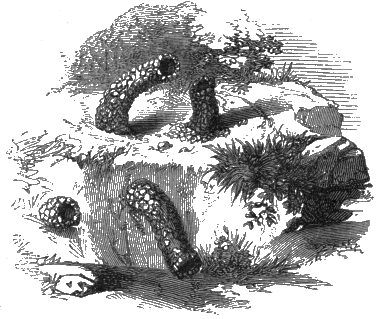
Some insects make the homes of their young in the earth. Of these, the insect called the sand-wasp forms, perhaps, one of the most interesting examples. This insect selects generally a hard sunny sand-bank for the excavation it is about to accomplish. Armed with a pair of powerful jaws, by means of which the insect can break off good-sized fragments of the rock she is about to mine, she sets to her arduous undertaking with a bold heart, and it is not long before a tolerable cavity is scooped out. Many of our readers have seen the manner in which human miners proceed when they are forming a hole in a lime or other rock, for the purpose of blasting, and must have noticed that they are in the habit of using a little water, in order to facilitate the boring operation. We are all, also, familiar with the tale of Hannibal chemically softening the Alpine rocks by means [16] of vinegar. The little insect in question has been instructed by the great Creator also to adopt a means of shortening her labour, for it has been observed that she moistens the rock by letting fall a drop or two of fluid upon it from her mouth. By this means her work goes on rapidly. The rubbish soon begins to accumulate. It will be scarcely conjectured what this patient labourer does with it. Were we to look narrowly at the sand-bank which such wasps frequent, we should find on its surface a number of curious little projections like horns, rising from [17] the surface. These are towers built by the sand-wasp of the pieces of rubbish which she scoops out of her mine. She cements them together, and, instead of throwing them away, she lays the masses in regular order until they have assumed the appearance here shown. It has been supposed she does this with a view to keep out enemies and to keep her progeny cool; just as in a tall house the cellar is its coolest apartment, so the height of the tower in question seems to be an additional protection against the rays of the scorching sun. After it has deposited its egg at the bottom of the excavation, the sand-wasp sets out on a foraging expedition, and hunts about until she finds certain green caterpillars. Seizing upon one of these she flies with it to her mine, and then returns for more prey. After collecting about a dozen of these helpless beings, fixing them so that they are hopeless captives inside her dark prison, she bids farewell to the egg, for the future well-being of which she has thus assiduously provided. She takes down her tower of stones, and, with the materials which composed it, fills up the entrance to the cell, thus shutting in both the prisoners and their future devourer in a common dungeon, [18] there to await the changes which time will inevitably bring about.
Let us speak now of eggs carefully deposited by other insects in galleries and excavations made into timber. The insects which thus act have been called by the fanciful title of carpenter-bees, in allusion to the drilling process by which they penetrate the wood. A highly interesting spectacle it is, in truth, to see one of these pigmy carpenters at her work, and, fortunately, some of the species are not very uncommon in our gardens. Spring is the season when she commences her labours. She reconnoitres about for a proper piece of timber for some time, and exhibits great discrimination in the selection of a suitable place for establishing herself and for the nurture of her progeny. Strange to say, she will not select living wood, such as the trunk of a tree, but generally prefers wood which has already begun to decay, as if fully aware that such wood was likely to give her much less trouble in boring than any other. She also selects a piece of wood placed in some sunny and genial position, with a view to the development and comfort of her progeny. This important point [19] being settled to her mind, she next sets about the work. Well may Réaumur exclaim, "Truly the labour she has undertaken demands strength, courage, and patience!"

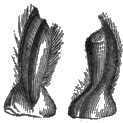
The violet carpenter-bee is, perhaps, the most interesting example we can select. She begins by cutting out with her strong jaws small portions of the timber, and soon forms a little hole, which looks downwards and inwards into the wood. She then alters the direction of her drilling, and now perforates the timber perpendicularly downwards, and in a parallel direction to the sides of the wood. Long and hard does she thus labour, until she has actually scooped out a tunnel in the timber a foot or so in length, and half an inch in diameter. Sometimes she will drill several of these beautiful galleries in the wood. The task, however arduous, never seems to weary her; impelled by a heaven-bestowed influence, she works strenuously and cheerfully for weeks, or even sometimes for months. Our [20] readers may be interested to know what she does with the saw-dust. If they can but get an opportunity of watching her they will soon see her mode of dealing with it. Standing by the side of the wood she is drilling, and keeping our eyes stedfastly fixed on the hole, we shall presently observe her head emerging from it, and immediately after she is seen to shovel out a little heap of the dust, which accumulates on the ground beneath into a pile. When her galleries are finished her labour is yet far from accomplished. She has now to deposit her eggs, and make provision for the prospective wants of her young ones. Now, her eggs must not be piled together, nor be scattered about in the same cavity. The larvæ which are to be produced by them must each live in separation from the others. How is this fresh difficulty to be overcome? The insect soon supplies us with the answer. She has not forgotten her heap of saw-dust. She first deposits an egg at the bottom of the tunnel, and then away she flies to the fields for a load of the fine yellow dust of flowers, called pollen, and also for honey. She mixes these up into a nice little mass of pollen-bread, or cake, which is intended for the food of the larva, when it [21] comes out of the egg, and then piles it up in the gallery just over the first egg. She then, at a height of about three quarters of an inch, plasters a layer or ring of saw-dust made by her into a sort of mortar, and adds to this another and another ring of the same material until the ceiling is quite complete, and the cell thus formed is shut off from the rest of the excavation by a circular plate of this substance, which effectually excludes all intercourse between the occupants of this wooden nursery. Having completed this cell she proceeds in the same way to lay an egg, and to provide a store of food, and, finally, to close in the rest of the gallery, until she has subdivided it into ten or twelve [22] separate apartments. The appearance of the circular ceilings formed on these ingenious principles is exhibited in the engraving annexed.
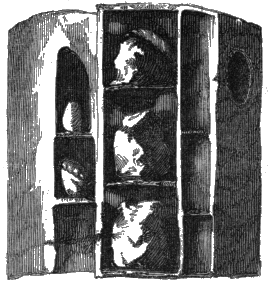
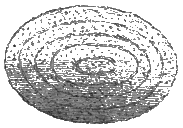

One of the most striking facts in connexion with the proceedings of this little creature has yet to be brought under our notice. It will be readily admitted that the first egg deposited at the bottom of the gallery will be the first, in point of time, that will be hatched, and, consequently, the first to require to make its escape from the wooden prison-house of its birth. How is it possible for this to take place, when above the poor prisoner's head are ten or twelve cells full of other occupants, and each shut in with a hard ceiling and floor? By referring to the figure, we obtain a clue to this enigma. It is here seen that there are holes which communicate with the tunnel within. The uppermost of these [23] holes was the one by means of which the tunnel was first formed, but the two lower ones have been expressly formed by the carpenter-bee to provide against the dilemma in which her young would otherwise have been placed. They form as it were posterns or back doors by which, when the insect is perfected, it is easily enabled to make its escape. Singular, indeed, it is, that the insects, previous to passing into their last transformation, arrange themselves with their heads downwards, so that every one of them generally emerges at the so-called back-door of the mansion.
There are many similar instances in natural history of the manifest wisdom and forethought of the Creator of all things, visible and invisible, but we may safely say there are not many which show it in so clear and striking a point of view as this. It is to be remembered this industrious insect in the arrangements in question does not act from past experience. She never saw her young brood, nor could learn of herself their wants and dispositions, yet her plans for their welfare are as admirably contrived as if she had brought up generation after generation under her own eye, and had learnt wisdom by the lapse of years. [24] Plainly, therefore, her actions are all directed by an impulse given her from God, and we may well exclaim with the wise king of old, it is God who "doth instruct her to discretion, and doth teach her." Altogether, what an example of patience and cheerfulness in her labours, and of admirable wisdom in their performance, is presented to us by this little sketch of the history of the carpenter-bee's nest!
Among the birds discovered in Australia, is one called the Bower-bird, from its fondness for making a bower, which it ornaments in a very pretty manner. Other instances of a somewhat similar kind could be mentioned, tending to show that some of the lower animals are as fond of decorating their dwellings as we are ourselves. There is, however, in the insect world, a little creature which has been called the tapestry-bee, which adorns the place where its progeny is to be born with a tapestry as novel as it is elegant. The great entomologist whom we have before quoted, thus describes his first discovery of this interesting fact:—"In one of my rambles, which had led me through several lanes, and in the course of which I had frequently stopped to examine the little tunnels pierced in [25] the earth by various insects, my companions began to engage in the same occupation with myself; one of them at length perceived, and pointed out to my notice, a tunnel which had some peculiarities of appearance not possessed by the others we had seen; its interior seemed to be painted with vermilion. A small twig was immediately gently pushed into it, and with a knife we carefully removed the earth which surrounded it, taking great care not to injure the walls of the tunnel. When we had uncovered it sufficiently, it was found that the little stick was buried in a tube made of the leaves of the field poppy.
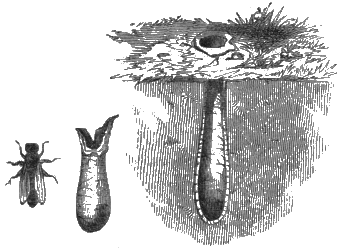
"I need scarcely say, that during the remainder [26] of our ramble we were exclusively occupied in searching for similar holes. It is a common observation, that when a fact, which has not hitherto been recognised among those presented to us in nature, is once caught sight of, we are almost sure to see it again and again, until we wonder how it could have been that it was never noticed before. We therefore now found other holes, leading to similar tubes, formed in the same manner of the flowers of the red poppy. Altogether, before returning home, we found seven or eight of them; and since that time, I have found them in all their different stages." These elegantly decorated apartments were subsequently found to belong to the tapestry-bee.
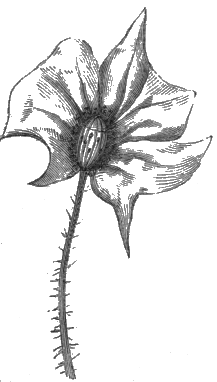
This bee, in forming the future abode of her young, begins by scooping out a burrow in some pathway, which she bores to the depth of two or three inches. She then smooths the walls of this cavity, and all being now ready for putting up the hangings, she betakes herself to the fields, and alights upon some fresh-expanded poppy flower, just displaying its crimson cheeks to the light of day. Here she quickly plies the scissors which she has been armed with for this purpose, and in a [27] very short time cuts out of the bright petal on which she rests, a smooth portion of a definite size. She then returns home, and, by means of the scissors and her legs, she cuts and smooths the piece until it lays quite flat upon the bottom of her cell. This done, she flies for more, and in a short time, could we peep in, we might find her mansion all over-spread with tapestry, more bright in colour, and more delicate in point of finish and texture, than human art can by possibility produce. The apartment being thus not only decorated, but rendered, both to the eye and senses, warm and comfortable, she then stores up in it a quantity of pollen and honey, until she has filled it to the height of half an inch, when she deposits the egg, for whose [28] wants and, as we might say, even luxuries, she has thus elegantly provided, folding some of the hangings carefully over it. The remainder of the cavity is filled with loose earth. We have taken it for granted, in this account, that the insect really takes a pleasure in the brilliant colours with which she ornaments her cell; but it is only right to say, in addition, that we have, of course, no positive proof that such is really the case. For aught we know, her motives may be very different; it is, however, an amusing way to consider these actions, be the explanation of them what it may.
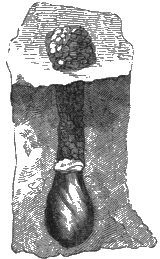
We fear, however, we dare not promise our readers the same success as that which attended M. Réaumur and his companions. It has been thought, that this interesting insect is not a native of our island, and it is certain it has not been commonly observed amongst us; but Mr. Rennie, in his work on Insect Architecture, says, that at a beautiful sea-bathing village in Ayrshire, he once [29] found in a footpath a great number of the perforations of the tapestry-bee. At all events, they deserve looking for.

Although we have, perhaps, lingered long enough over the insect cradle, we must spare room for one or two more remarks on this subject, and it were almost a shame, while speaking thereon, to omit a notice of one of the most elegant cradles of all—one made with rose-leaves! As Réaumur's account of the manner in which he first became acquainted with these egg depositories is very pleasantly written, we shall extract the substance of it from his work. It was one day in July, 1736, that a gentleman of rank, accompanied by his suite and his gardener, who was in a state of great alarm, waited upon an eminent naturalist in Paris. The gardener had left his master's country-seat, near Rouen, to proceed with all haste to the metropolis, in order to communicate to his master the terrible tidings, that his ground was bewitched! He had the courage, however, to pick up the spells, or charms, which the sorcerer had placed in the earth, and to carry them to his master, in full belief that they were sufficient to convince all the world of the reality of the enchantment. He had, indeed, [30] in the first instance, taken them to the parish priest, begging his counsel, and both came to the same conclusion—that, without doubt, the garden was now enchanted ground! When the gentleman saw the little things his gardener called charms,—which are here represented,—he was much perplexed, although his good sense led him to ridicule the idea of the bewitchment of his property by such means. He applied to his medical adviser for a solution of this problem; but, alas! he was no entomologist, and could not enlighten him; but he directed him to the naturalist of whom mention has been made, and whose name was M. Nollet. On being admitted to the presence of this gentleman, the terror-stricken gardener hastily put on the table the little rolls of leaves he considered to be spells, and which had been made, with some evil design, as he doubted not, by the malevolent hands of some [31] sorcerer. Fortunately, M. Nollet had in his museum some rolls of leaves formed with equal art by beetles; he produced them, and showed them to the affrighted man, assuring him, that, without doubt, they had been formed by insects, and that it was therefore highly probable that the rolls in question were the productions of some other insects of a different species. The gardener looked incredulous, being apparently unwilling to give up his alarm, until M. Nollet, greatly to his horror, took up one of those little leaf-rolls which had caused him so much uneasiness, and carefully unfolding it, drew from thence a fat little larva. The moment the gardener saw the little creature, his fears and troubled aspect vanished, and an air of cheerfulness spread over his face, such as one might imagine as the result of deliverance from some fearful peril. The only reward M. Nollet would receive from the poor man for thus dissipating his cares and fears was, that he should leave the leaf-rolls with him, and, collecting more of them, should send them to M. Réaumur's address, for him to examine. This little anecdote affords us a good illustration of the connexion of superstitious fears with ignorance on points of natural [32] history, and sets before us, in well-relieved contrast, the foolish terrors of the unlearned gardener with the collected bearing of the learned naturalist. Would that this anecdote stood alone in the records of natural history! We have already seen that it does not; and that the most groundless apprehensions have taken their rise in the most innocent and trifling of natural causes.
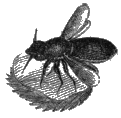
By and by, after a little careful investigation, the true artificer of these spells was discovered, and proved to be a lowly insect, which has been since called the rose-leaf-cutter bee. On closer examination, these rolls of leaves,—which are almost as long and as large as a tooth-pick case,—were found to be made up of six or seven cells, each separate from the rest, placed end to end, and covered with a common coating of leaves. The manner in which the roll is formed is as follows:—The insect sometimes makes a perforation in decayed wood, sometimes in the well-trodden earth of a footpath; this she drives to the depth of, perhaps, nine inches, and she then proceeds to hang this apartment with its green tapestry,—for it must be understood, it is not the leaves of the flower, but of the stem of the rose-tree,—or, [33] in other words, the green leaves, that she selects for this purpose. The insect alights upon what she considers to be a suitable leaf, and begins with her sharp jaws to cut out a piece of a crescent form from its edge. When she has cut, perhaps, half-way round, or rather more, she sets her wings in motion, so as to keep her balanced in the air, lest she should drag away the half-cut piece before it was properly divided from the leaf. When cut, she places it in a perpendicular position between her legs, and flies away with it to her cell. She then simply folds it into a proper form, and overlays the cell walls with this leafy covering, not using any cement to make it retain its form, but relying upon the natural elasticity of the leaf to keep it close pressed against the wall in the manner in which she places it. Repeating this process several times, she finally completes each cell with exquisite art and care, and taking the precaution of arranging all her joints and seams so that they shall not present themselves in the same place, but covering them over with pieces of leaf, so as to strengthen them, and in many other [34] respects exhibiting an amount of mechanical and mathematical skill never sufficiently to be admired, she now deposits the minute egg in it which is to become the toilsome, busy, patient, and clever being,—the full-grown insect of her own species. Mindful of its future wants, she then compounds a delicate mass of pink conserve, which she collects from thistles, and subsequently stops up each cell with thin pieces of leaf, as exactly round as if they had been cut out with a punch, or by means of some mathematical instrument.
Réaumur says he often, in the month of May, on looking at his rose-trees, detected these insects at their work; all he had to do was, to stand and patiently watch by the side of a tree, the leaves of which exhibited the singular marks made by this insect. Many times have the same appearances arrested our attention, and without doubt that of the reader. The spectacle of insect ingenuity which it affords well promises to repay a little exertion in endeavouring to find out the nest to which the pieces are conveyed, and some neighbouring post or footpath will probably discover it to us after a sharp scrutiny. Sometimes the insect makes a bad choice of a leaf; it may be, perhaps, [35] too tough for her; but she soon discovers her mistake, and leaves it, half cut, to seek a better on the same branch.
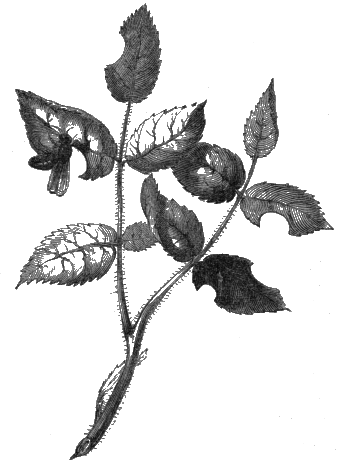
The nest formed by a species of moth for depositing her eggs in, is one equally interesting to [36] describe. From the resemblance of her actions to the well-known account of those of the eider-duck, whose maternal love strips her breast of down for the purpose of protecting her eggs, we might almost venture to call this moth the eider-moth, were it not that it is known under another and far less appropriate name—the gipsy-moth. Indeed, in the care of the insect the mother's love is, as we might say, even more powerful than in the bird; for, while the latter has the pride and pleasure of seeing her little ones grow up around her, the poor insect, after stripping herself of her own soft, warm down, thus testifying her love to her offspring even to death, presently expires. The insect in forming her nest first plucks off, by means of a singular instrument, like a pair of tweezers, with which she is provided, a little portion of down from her body; seated upon a tree, she attaches this to its trunk, and then deposits an egg in it, which immediately adheres to the down, and becomes coated with it. The remainder of her operations, until she has deposited the entire number of eggs, are but repetitions of the same actions. When the process is at an end, she begins to form a regular tile or covering to her nest, and this she effects with a degree [37] of skill not unworthy of the most consummate thatcher. She arranges the hairs of the down just as the thatcher does his stems of straw for the cottage roof, so that they all slope downwards, resembling much the smooth pile of a hat. By this arrangement of the down, it is next to [38] impossible that in the most drenching shower the eggs, warmly wrapped up within, should be wetted or otherwise injured, and the down itself, being a material which, as we all know, is a non-conductor, preserves the eggs from the influence of the most severe frosts. In shape, this nest of eggs resembles a skittle, or a truncated cone, the broad end downwards. The engraving represents this form, and also shows the insect at work constructing the nest.
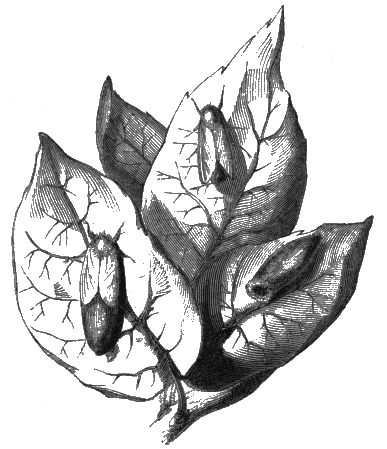
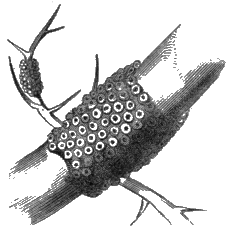
Let us now pass on, to mention, that many eggs are deposited without any special protection of the kind we have described, and without what would be with propriety termed a nest. A moth, called the lackey-moth, frequently ornaments the young twigs of trees in our gardens with exquisite bracelets of glistening white eggs, looking like beads. From two to three hundred of these eggs are glued on by the insect around the twig, by means of a tenacious waterproof cement, and are arranged [39] with an accuracy of the most marvellous character, in a close spiral line upon the twig. The cement employed by the insect in uniting her eggs, and in varnishing them over, is so hard as to serve the purpose of a covering, which admirably casts off the rain, and preserves the eggs free from injury by the elements all the winter long. Many eggs are simply glued on irregularly upon the stems and leaves of plants, their shells or outer coating, together with the protecting varnish, being sufficient to preserve them from the inclemencies of the weather; but some are piled together with the most striking regularity, in regular columns of eggs.
In addition to these, it is proper to state, that some insects lay their eggs in the body of the young of others. Of these, those which are most dreaded by the insect tribe are the little but terrible flies, called Ichneumons. They are so called because in their actions they agree with the popular account of those of the ichneumons of Egypt, which were venerated as the destroyers of the eggs of serpents and crocodiles. "Such," say Messrs. Kirby and Spence, "is the activity and address of the ichneumons, that scarcely any concealment, [40] except perhaps the waters, can secure their prey from them; and neither bulk, courage, nor ferocity, avail to terrify them from effecting their purpose. They attack the ruthless spider in his toils; they discover the retreat of the little bee, that for safety bores deep into timber; and though its enemy, the ichneumon, cannot enter its cell, by means of her long ovipositor (organ for depositing the egg), she reaches the helpless grub, which its parent vainly thought secured from every foe, and deposits in it an egg, which produces a larva that destroys it. In vain does the destructive cecidomia of the wheat conceal its larvæ within the glumes that so closely cover the grain; three species of these minute benefactors of our race, sent in mercy by Heaven, know how to introduce their eggs into them, thus preventing the mischief they would otherwise occasion, and saving mankind from the horrors of famine. In vain, also, the cynips, by its magic touch, produces the curious excrescences on various trees and plants, called gulls, for the nutriment and defence of its progeny. This parasite insect discovers its secret chamber, pierces its wall, however thick, and commits the destroying egg to its offspring." In [41] vain, also, might we add, does the sand-wasp excavate her deep cell for her young ones; for when once the ichneumon has discovered the retreat, the destruction of the young larvæ is inevitable. She pierces through the defences piled over the mouth of the cavity, with all the precision and patience of a higher creature, and rests not until she has thrust down her long ovipositor, and placed the egg in the body of the helpless prisoner below, when she flies away, confident that the days of her victim are numbered, and having thus doomed him to be eaten up alive! The common caterpillar, which, by its ravages in our cabbage rows, makes itself a little too familiar to us, has a fierce enemy in these flies; they dart upon it, pierce its body in many places, laying an egg in each wound; these in due time become hatched, and eat their way out of the body of the poor caterpillar, who soon dies, while the larvæ, after undergoing their proper transformations, become perfect insects themselves, fully equipped to proceed to the same work in some other individual of the caterpillar kind.
To man, this ordinance of the Creator, that some insects should lay their eggs in the bodies [42] of others, and so destroy them, is of inestimable benefit. It is quite impossible to imagine what would be the result, were weevils, caterpillars, and such like insects, to be permitted to multiply without a check. Produce of all kinds would soon be consumed, and the desolations of an universal famine would overwhelm man and beast. But God has been pleased to ordain it otherwise. In proportion to the increase of the destroyers is the increase of those that prey upon and destroy them. Thus, what has been well called the balance of creation is preserved, and by means of the insects in question, conjoined to other causes, is the command to the destroying powers enforced—"Hitherto shall ye come, but no farther."
STRUCTURE AND CONTENTS OF THE EGG.
In the past pages we have now considered shortly the various methods of depositing the eggs of insects, and have seen that the nursing place where the young being is produced, differs widely both in point of its position, and of the external circumstances which variously affect it. For some are the deep-bored galleries in timber; for some, the hard-wrought tunnel, scooped by an insect out of a rock; for some, the ingeniously-formed boat or raft, which is to carry its cargo of life buoyant on the dancing waters "all the days of its appointed time, waiting until its change come;" for some, the cell of earth lined with painted hangings, exquisite in make and colour; for some, the little leaf-case, curiously folded together; but for others, none of those works of insect art are provided; they, hid in a rain-proof covering of varnish, lie open to every eye, or scattered here and there on [44] all and every kind of flower and herbage, lie at the mercy of every wandering foot. While, lastly, others are buried with a cruel yet merciful art, in the bodies of myriads of unsuspecting members of the insect community, lying, like the seeds of evil in the heart of the infant, dormant awhile, but destined to grow with its growth and to strengthen with its strength.
The time has, therefore, now come that we should speak a little more particularly upon the nature and character of the eggs of insects. The shape of an insect's egg, although frequently something of an oval in its outline, is very various; in fact, were the egg of some peculiar species placed in the field of a microscope, probably not one general observer out of a hundred could in the least imagine what the object at which he was looking really was. Sometimes they are oval and exactly resemble the form of the egg of the bird; but in other instances they are of the most irregular and fantastic appearance. Some look like pill-boxes tied over and down their sides with string; others look like tiny flasks, with many raised ribs upon their surface; others have lids and springs. The gnat's egg resembles a [45] chemist's phial, or one of the new bottles for holding aërated waters; and those of the dung-fly have two little pieces sticking out at the top on each side to prevent them sinking too deep into the matter upon which they are deposited.
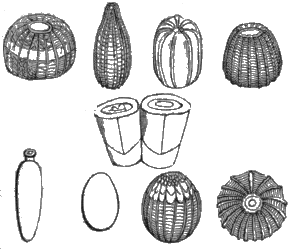
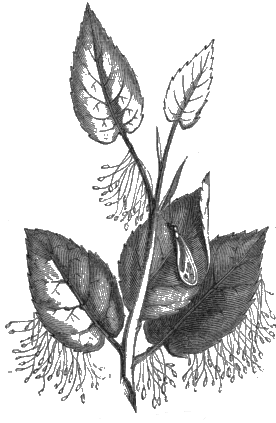
The eggs of some insects strikingly resemble the little shells like turbans with which we are most of us familiar. A very singular variety of egg which has often caused much perplexity to naturalists is the egg of the lace-winged fly. Réaumer says, "I had observed them several years without actually knowing what they were. Others as well as myself had noticed that on the leaves and twigs of many trees were a number of minute [46] stalks placed together, scarcely as thick as a hair, their colour was nearly white, and they were about an inch in length; there were sometimes ten or twelve placed in a bunch; the end of each stalk bore a small head of an egg-like or oblong figure. They appeared to me to be fungi, the little head precisely resembling the appearance of moulds as seen under the microscope; but they were larger in size." They were, in fact, the eggs of the fly in question. When the larva escapes from them they have much the appearance of little vases; and the same author assures us that they were once described and engraved by a naturalist as some curious minute flower growing [47] on the leaves of the elder, for which he was unable to account. The representation of them in the cut will enable the reader to form his own opinion as to the difficulty of ascertaining whether they were flowers or the nests of an insect.
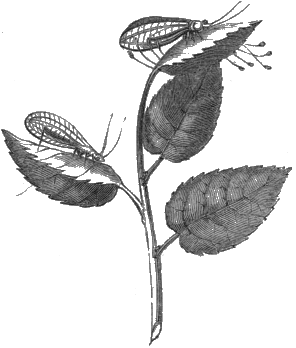
The manner in which these eggs are thus regularly placed by the insect is interesting. Placing herself upon the leaf in the attitude represented, she fastens a thread to the leaf, draws it out in the same way as a spider does her lines, and when it has got sufficiently firm the wise insect then puts forth the egg, glueing it to the extremity of the stalk; this done, she quits it and begins to form another, repeating the same actions until the proper number is laid. Poised on the summit [48] of these slender pillars the eggs are secure from every invader but man himself, and in time there comes from them the larva which is to become the beautiful insect, the "lace-winged fly," in all the elegance of its form.
From what has been already stated, the surface of the eggs of insects, it will be perceived, is by no means in all cases smooth and polished as in the case of birds. Far otherwise. To look at some of them by the help of a magnifying glass we should imagine that they were covered with very fine lace net, others appear as if some clever engraver had been chasing some intricate design upon their surface. The eggs of a species of butterfly are studded over with an infinite number of little knots or tubercles; and those of another are capped at the top with sculptured work disposed in the form of a circular tiling or roof to the egg. Some also closely resemble embossed buttons.
He who has thus adorned these minute objects with beauty of form and carving, has likewise bestowed upon them the most beautiful and variegated colours—colours such as no human art can imitate. But from the small size of the [49] eggs it is difficult to appreciate this beauty in them except when they occur in a mass. The most common tints are white, yellow, and green, but the richer and rarer hues are also to be found among them. Thus, the eggs of a moth are of a beautiful blue colour, banded in the most delicate manner by three zones or rings of brown, the contrast being very pleasing. Another moth, which loves to deposit its eggs in the bark of the willow, produces them tinged with a purple more delicate than ever Tyrian lady wore as the finest produce of the dyer's art. In the deep crevices of the bark of the elm, and only, therefore, to be found by sharp scrutiny, another moth lays eggs of a lovely pink. Messrs. Kirby and Spence write, "We remember once being much surprised at seeing the water at one end of a canal in our garden as red as blood; upon examining it further we found it discoloured by an infinite number of minute red eggs." Sometimes eggs are spotted, and thus resemble the eggs of many birds; and, strange to say, sometimes they change colour in a very remarkable manner; so that, as far as colour is concerned, an observer could scarcely believe that the egg was the same he beheld, perhaps, a few days previously. The [50] eggs of the chameleon fly, as we are told by the gentlemen last quoted, are at first pure white; then change to green, and finally turn to a deep olive-green. Others are at first mouse-coloured, then reddish, and, lastly, black. The eggs of a kind of moth we have seen first of the colour of sulphur, then becoming green, after that rose-colour, and lastly, black. In the instances of the common gnat and silk-worm, similar changes of colour take place. The eggs of the gnat are first white, then green, and finally gray; and those of the silk-worm are in the first instance of a pale yellow, and ultimately take on a violet tint.
Having thus noticed these points in connexion with the Life of an Insect, we are led to that most important of all periods, the dawn of life in the egg, or, in common terms, the period of hatching. But before proceeding to the subject, may we not pause and wonder as we behold the varied manifestations of the Creator's wisdom in the actions of the minute, and, as we often call them, insignificant creatures of whom we have spoken? Should David say, when he beheld the sun, moon, and stars, as the work of a Divine hand, "Lord, what is man, that thou considerest [51] him, or the son of man, that thou regardest him!" And shall not we, as we contemplate the few particulars here set down of the wonders of insect-life, exclaim, with even greater astonishment, "What are these, that thou considerest them?" Let no one then say, that entomology, or any other natural science whose field of study lies chiefly among the minute portions of creation, are profitless sciences, when they can reveal to us such a display of the power, wisdom, and love of God, as is exhibited even in this small portion of the Life of an Insect.
Let us then take up one of these eggs, so minute, but containing within it the rudiments of a being which is in time to assume a form of considerable magnitude, by comparison, and to be adorned with colours richer than art can boast of, and let us examine it on the field of a tolerably powerful microscope. We need not look far for a specimen. In the dark corner of the ceiling in a neglected room, after removing the mass of dust-filled webs that have accumulated there for months, we may find without difficulty a spider's nest of eggs. A more pleasant place to search for insects' eggs is, perhaps, the garden; and if in the crevices of the bark of the trees, or attached to twigs [52] or branches, none can be found, we can almost certainly promise success if the reader will carefully and patiently search the angles of the garden walls, particularly if he has noticed in the preceding autumn many of the beautiful webs of the garden-spider. There, in some sheltered recess, where the pattering rain-drops may be heard, but never venture in, and where few eyes would detect them, may be found little round yellow balls, of the size of a small cherry, made of the most beautiful golden-coloured silk, and attached by a slender stalk to the wall, or perhaps, to a twig. Sometimes they exhibit the more elegant and curious appearance shown in the figure on the next page, resembling an inverted wine-glass or pear.
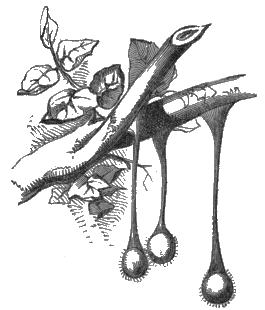
On taking our prize in-doors, by the aid of a very sharp penknife we may succeed in cutting it smoothly open, and in turning out some of the delicate [53] eggs which lie warmly covered up at the bottom. Taking one of them up on the point of the knife, and laying it on the microscope-field, we shall be able to see something of the anatomy of an insect's egg.
First, we may notice what seems to be the shell; that is, the outer covering of the egg. This is very different to the hard, calcareous eggshell of birds. It is stated not to contain any lime in its composition as the shells of birds do; for when the eggs of insects are put into very weak sulphuric acid and water, which would act on the lime if it were present in their composition, they are not affected by it. Although, therefore some eggs of insects are very hard: so hard indeed as to resist severe pressure with the nail, they do not owe their hardness, as do the eggs of birds, to any lime in their chemical composition. The outer coat or shell is apparently simply membraneous, frequently varying greatly in thickness, being sometimes as dense and horny as we have mentioned, and at others, so delicate as to burst with the gentlest touch.

Could we now do, what it is so easy to do with the egg of a fowl,—carefully take off a little portion of this outer shell, we should be able to inspect its contents more accurately. But in the case of most who read this book, this extremely delicate task will prove after many trials probably a hopeless failure. Let us state, therefore, what some expert and talented observers have found within the insect's egg. It appears, then, that although there is both a "yolk" and a "white" in the tiny egg before us, that they are not quite so distinct as in the bird. Yet, they are sufficiently separate from one another to make their differences complete. Probably the reader has noticed in the hen's egg a little round spot in the middle of the "yolk" or yellow portion; from this the future bird is produced. Although from their extreme minuteness it is difficult to detect anything of this kind in the eggs of insects, some observers state they have seen a similar little spot in them also. Thus, M. Herold says, that in the eggs of the very insect whose nest we have robbed, the garden spider, "this little spot can be seen as a minute white point immediately under the shell, and in the middle of its circumference." This was seen by holding it up to the light, and the spot was [55] more carefully examined by gently pressing the contents of a spider's egg upon a watch-glass. Mr. Rennie says, that "the point where the caterpillar originates, answering to the scar in the eggs of birds, we can readily distinguish even by the naked eye in the larger species of eggs, as it lies always immediately under the shell." But it may be doubted whether, without the assistance of some one versed in entomology, many who make the same attempt, will succeed. So much depends in looking at any object upon whether we know what to look for or not, so that things which are as clearly seen as possible by the eyes of the initiated, are not seen at all by any others. To perceive some things in natural history, and many in science, the senses of sight, hearing, and touch, require to be well educated, and they then become apparent enough.
And is this all that we can mention about the structure of an egg? This indeed is all. Can it be possible? Is there no striking and broad difference to mark the nature of the future insect? Is the egg of a spider the same in the number and nature of its parts as that of a butterfly, or the egg of a gnat as that of a beetle? Surely, as we should imagine, there must be some important [56] differences between these, otherwise why such immense differences in the perfect insect? Could any one imagine that a grasshopper and a house-fly, so strangely unlike each other in their perfect forms, originated in eggs to either of which the same description of an insect's egg would accurately answer, and leave nothing out? However great our amazement, the fact is unquestionable. The egg of every insect at first consists of an outer covering, a white, a yolk, and the little spot we have alluded to. We might have thought that in creating so many different species of insects, which differ so surprisingly in form as the insect tribes do, the great Creator would have formed their eggs essentially different too. But, except in the matter of shape, all are originally alike; and the wisest philosopher is unable to inform us of any essential difference in the eggs of insects at first. The eye of God, who knows the end from the beginning, sees some difference inappreciable to the eye of man. He said to this kind, "Be thou thus," and to that, "Be thou different;" but until the time comes when the young insect is much more advanced, it is not possible for us to recognise those marks of variety which His hand has laid upon them from the beginning.
LIFE BEGINS IN THE EGG.
The eggs of birds are, in most instances, hatched by the warmth of the mother, who sits for a certain time covering them with her wings and downy breast. But the exception to the rule in insects is that the mother has anything to do with rearing her young brood; the cases in which this takes place will be noticed in our next chapter. Generally speaking, the eggs of insects are hatched by the increasing temperature of the air in spring. The following sketch, extracted from Mr. Darwin's interesting Journal of the Voyage of the Beagle, sets before us, in a very pleasing manner, the awakening influence of this season to all nature:—"When we first arrived at Bahia Blanca, September 7th, 1832, we thought nature had granted scarcely a living creature to this dry and sandy country. By digging, however, in the ground, [58] several insects, large spiders, and lizards, were found, in a half-torpid state. On the 15th a few animals began to appear, and, by the 18th, (three days from the equinox,) everything announced the commencement of spring; the plains were ornamented by the flowers of a pink wood-sorrel, wild peas, œnotheræ, and geraniums; and the birds began to lay their eggs. Numerous beetles were crawling about, while the saurian tribe, the constant inhabitants of a sandy soil, darted in every direction."
As to the torpid animal and buried seed, so to the carefully laid up egg, the returning warmth of the air is the signal for the commencement of life. The winter-clouds roll reluctantly back, as the genial days of spring advance, and the changes which are to have their accomplishment in the production of a living being out of the minute object before us, are set in movement as the days grow bright and pleasant. That the hatching of the egg, in most cases, is due chiefly to the stimulating influence of heat, is now well ascertained. The school-boy who has ever amused himself with silk-worms can well assure us of this fact, for he is in the habit of hatching the insect's eggs by [59] carefully wrapping them in paper, and keeping them in his waistcoat-pocket, where they have all the comfort and warmth of his body to bring them forward. In countries where the silk-worm is reared, women carry them in their bosom, and by this means cause the young larva to come forth from the egg in much less time than it would naturally occupy. By removing a twig of a plant upon which in the preceding autumn an insect may have been found to have deposited its eggs, into a warm room, an opportunity will be had of putting this operation practically to the test. In a short time it will be found that the eggs are all hatched, and that a number of minute larvæ are crawling actively about, while their brethren in the snow-covered fields are yet safely asleep in the shell.
On the other hand, eggs which would otherwise be hatched the same year are arrested by the advancing cold of the winter season, and are now compelled to wait until the ensuing spring, before their time of hatching arrives. Evidently, therefore, to the commencement of the life of an insect the condition of the external temperature is an all-important consideration. Before proceeding immediately [60] to consider the nature of the changes, it may be mentioned as an interesting fact, that although the eggs of insects are very quickly sensible of a slight increase of heat, and in consequence of its application to them very soon begin to live, yet they will endure the most severe degrees of cold almost without injury. As an illustration of this point we may transcribe a few sentences from a paper by the great Spallanzani upon this subject:—
"The year 1709, when the thermometer fell to 1° Fahrenheit," or thirty-one degrees below freezing point, "is celebrated for its rigour and its fatal effects on plants and animals. 'Who can believe,' exclaims Boerhaave, 'that the severity of this winter did not destroy the eggs of insects, especially those exposed to its influence in the open fields, on the naked earth, or on the branches of trees? Yet, when the spring had tempered the air, these eggs produced as they usually did after the mildest winters.'" He adds further on, "I have exposed eggs to a more rigorous trial than the winter of 1709—those of several insects, and among others the silk-worm, moth, and elm-butterfly, were enclosed in a glass vessel, and buried [61] five hours in a mixture of ice and rock-salt, the thermometer falling 6° below zero. In the middle of the following spring, however, caterpillars came from all the eggs, and at the same time as from those which had suffered no cold. In the following year, I submitted them to an experiment still more hazardous. A mixture of ice and rock-salt, with the burning spirit of nitre, reduced the thermometer 22° below zero, that is, 23° lower than the cold of 1709, or 52° lower than the point at which water freezes. They were not injured, as I had evident proof—by their being hatched."
When it is known that many seeds will not endure these degrees of cold without injury, and those even of some tolerably hardy plants, it is the more surprising to find such apparently delicate and readily damaged objects as the eggs of these members of the insect tribe thus resisting an intensity of cold to which, in a state of nature, they are scarcely ever exposed. It is impossible to assign any rational explanation of these singular facts. It is undoubtedly owing to this power of resisting the generally deadly influence of extreme cold that we find insects reappear in spring, even [62] in countries where the winter is much prolonged, and is of extreme severity. Thus, in Lapland we should have probably thought that the rigour of the climate would have been fatal to all insects in winter, in any condition, whether in the egg, or in other forms; but, as the poor inhabitants know to their cost, it is far different. The mosquitoes swarm in that country in numbers so prodigious that they have been compared to a fall of snow, or to the dust of the earth. The wretched natives cannot take a mouthful of food, or lie down to sleep in their cabins, unless they are fumigated to a degree almost dangerous to life. They fill the mouth and nostrils, and, minute though they are, render existence almost a burden by their blood-thirsty propensities. Not even thick plasters of the most offensive compounds,—tar, oil, and grease, are sufficient to shield the Laplander's skin from their attacks. The great John Hunter considered that this power of resisting cold was, in some unexplained manner, connected with the existence of a living principle in the egg, which had the effect of withstanding a degree of cold that would otherwise have been fatal to it; but, after all, this is only an apology for an explanation. When we [63] are unable to clear up the difficulties of a natural history question like this, although we cannot explain, we are not prohibited from admiring, and can clearly perceive, that in thus endowing the eggs of insects with a self-preservative power, God has manifested his wisdom and forethought; for had it been otherwise, the lapse of a few seasons would have depopulated the insect world, leaving us, it is true, without a gnat or a mosquito to annoy us, but also without a silk-worm, or a bee, to supply us with the precious products of insect industry.
The frosts have disappeared, the air brightens, the sun loses its pale aspect, and glows with a more golden face. The days lengthen, the breeze has lost its penetrating chilliness, gentle showers descend and water the earth, and there is a general voice heard all over creation,—"Spring has come!" The eggs of a thousand insect species have already perceived its presence, and the newly-awakened beings within hasten to welcome it by bursting from the shell, their long occupied, but now for ever forsaken dwelling-place. Sometimes the young larva bursts through the thin walls of the shell by main force, or eats its way through by means [64] of its jaws, which is occasionally a task of many hours' duration. "In many instances, however," write Messrs. Kirby and Spence, "the larva is spared this trouble, one end of the egg being furnished with a little lid, or trap-door, which it has but to force up, and it can then emerge at pleasure. Such lids are to be found in the eggs of several butterflies and moths. The eggs of a species of bug, besides a convex lid, are furnished with a very curious machine, as it would seem, for throwing it off. This machine is dark brown, of a horny substance, and of the shape of a crossbow; the bow-part being attached to the lid, or pushing against it, and the handle, by means of a membrane, to the upper end of the side of the egg."
But if, in our account of the various attendants on the opening of spring, we had mentioned every circumstance that takes place at that time, alas! for any poor insects, or, at least, for a large number of them, who should be hatched at that time. The warm air and gentle shower, and brighter sky, would ill satisfy them in the absence of all food, and they would be born, by a cruel destiny, only to starve and die. We well know this is not the case; but there are, probably, few [65] persons who have ever thought much upon the admirable arrangement by which the occurrence of such a calamity to many of the insect tribes is avoided. We need scarcely remind the reader that in the opening sentence of the last paragraph there is one most important omission in the sketch of the phenomena of returning spring; that is, that there is no mention of what takes place in plants,—of the putting forth of their young and tender leaves. Now, as a majority of insects in the larva state are vegetable-feeders, we can easily understand that the unfortunate little beings if hatched before the appearance of leaves would, without doubt, quickly perish for lack of proper food. Yet the returning warmth of the air is all that is requisite to call the insect into existence, and if by the time it is ready to burst from the shell there is not food all prepared for it, it must die. The difficulty has been beautifully provided for; and perhaps, few other instances of the wisdom of the Creator in forming the insect world are so full of instructive thought as this. It has been ordained, then, that soon as winter is over, the plant is first to obey the voice of spring, and to awake; and the bursting buds on its lower boughs are already full [66] charged with sap long before the young insect being that is to be fed therewith has left the shelter of the egg.
One of the talented authors of the Introduction to Entomology relates a pleasing anecdote in reference to this simple, yet admirable arrangement, and mutual adjustment of these two events,—the awakening of life in the plant and in the insect. "On the 20th of February, 1816, observing the twigs of the birches in the Hull Botanic Garden to be thickly set, especially about the buds, with minute oval black eggs of some insect with which I was unacquainted, I brought home a small branch, and set it in my study, in which is a fire daily, to watch their exclusion. On the 28th of March I observed that a numerous brood of aphides had been hatched from them, and that two or three of the lower buds had expanded into leaves, upon the sap of which they were greedily feasting. This was full a month before either a leaf of the birch appeared, or the egg of an aphis was disclosed in the open air." Thus showing that the coming to life of the branch and of the insects resting on it, was beautifully arranged to take place each at the proper time.
It is very singular to add, that as some trees acquire their leaves earlier or later than others, the eggs of insects which are deposited on them, never are hatched before the leaves appear, even while some of their companion eggs of a different species, and placed, therefore, on different trees, may have long since sent their young into the world. Thus, we learn that not only has God been pleased to arrange generally the hatching of the eggs of insects, and the putting forth of the leaves of trees, so that the latter shall precede the former, but it has also been ordered that the eggs deposited on each particular plant shall be hatched just when the time of that plant's putting forth its leaves shall arrive, at whatever period that may be. This may be more readily comprehended by an example: thus, there is no difference, so far as we can perceive, between the eggs of the little insects just mentioned as feasting on the leaves of the birch, and those whose food is the leaf of the ash; yet the birch will be in leaf nearly a month before the ash-tree, and the eggs deposited on it will therefore be hatched a month before those placed upon the ash, although both trees are in the same position with regard to [68] warmth, and may even, perhaps, be within a yard or two of one another. What a beautiful and mysterious link is this, between events so disproportionately important as the clothing of a great tree with its leafy garments and the coming to life of a little throng of beings, whose dwelling-place is a small twig, and whose world a green leaf! Yet it was not too insignificant a matter for Him to arrange whose dwelling-place is eternity, and who takes up the islands as a very little thing. Does God take thought for these, and will He not much more care for and arrange well every event in the lives of his faithful children? Surely, yes.
Speaking generally, the time taken up in hatching the eggs of insects is very variable. It is a general rule that the eggs which are laid in the autumn must abide the return of spring before they will be hatched. But when eggs are deposited in the summer, they are often hatched in a very short time. The eggs of the painted-lady butterfly are hatched in about eight days, those of the lady-bird in a little less, from five to six days; the eggs of another species of butterfly occupy a month, those of spiders three weeks, those of bees only three days, and those of the meat-fly shorter [69] than any—only a few hours; it has even been stated that in very warm weather the eggs of the meat-fly will be hatched in about two hours! In most of these cases much depends upon the weather; but even this does not operate beyond certain limits, for it has been said that in the month of June, even if silk-worm's eggs were placed in an ice-house, they would be hatched in spite of the cold, but this observation deserves to be repeated.
It would be impossible to make the exact nature of the changes which take place in the egg from first to last easily understood in a work of this kind. They have occupied the laborious investigation of talented observers with the highest powers of the microscope, and although much is now known on the subject, it is of a nature too abstruse to be dwelt upon in our unpretending volume. As we may well imagine, the changes are wonderful indeed which from a little drop of fluid matter, contained perhaps in a shell not larger than a pin's head, end in the development of the living and active larva, who makes his speedy escape out of his shell-cradle. But they must be studied in the scientific treatises which are written upon this subject, and they are so [70] interesting as amply to repay the task of investigation. It may be added, however, as a curious fact, that contrary to the general rule in the egg of birds, some of the eggs of insects actually grow larger before they are hatched, and frequently the shape alters also.
In our account of the nests made by insects for their eggs, the examples quoted, although they furnished us with many proofs of a mother's care and forethought on the part of the insect, yet there was no instance given of anything like the solicitude displayed by the hen over her eggs. Are there then no anxious mothers concerned in the well-being of their eggs among insects also? In the next chapter some instances of a mother's care over the young larvæ will be given; and before we conclude the present, mention may be made of some interesting observations upon this subject made by the eminent naturalist M. Bonnet. The insect upon which his observations were made was the spider, so commonly found on turning up a log of wood in the fields, or a clod of earth. She carries her eggs about with her in a little round white pouch of silk attached to her body. Well has it been said, "Never miser clung to his [71] treasure with more tenacious solicitude than this spider to her bag. Though apparently a considerable incumbrance, she carries it with her everywhere." M. Bonnet found that he could not beat away the affectionate creature from her treasure, and on forcibly removing it from her she instantly lost her ferocious aspect and became tame. In this emergency she stops to look around her, and begins to walk at a slow pace, and searches diligently on every side for her lost eggs, nor will she fly if threatened by the bystander. If, however, out of compassion, the bag is restored to her, she darts forward, catches it up with all the intensity of a mother's love, and runs away with it as fast as possible to some secret place where she may again have the opportunity of attaching it to her body. In order to put this insect's affection for her eggs to a test, M. Bonnet threw a spider with her bag into the den of a ferocious insect, called an ant-lion, who lurks at the bottom, like the Giant in the "Pilgrim's Progress," waiting for poor insect-travellers to drop into the pit which it forms, and then, rushing out, devours them. "The spider endeavoured to escape, and was eagerly remounting the side of the pit, when I [72] again tumbled her to the bottom, and the ant-lion, more nimble than the first time, seized the bag of eggs with his jaws, and attempted to drag it under the sand. The spider, on the other hand, made the most strenuous efforts to keep her hold, and struggled hard to defeat the aim of the concealed depredator; but the gum which fastened her bag not being calculated to withstand such violence, at length gave way, and the ant-lion was about to carry off the prize in triumph. The spider, however, instantly regained it with her jaws, and redoubled her efforts to snatch the bag from the enemy; but her efforts were vain, for the ant-lion being the stronger, succeeded in dragging it under the sand. The unfortunate mother, now robbed of her eggs, might at least have saved her own life, as she could easily have escaped out of the pitfall; but wonderful to tell, she chose rather to be buried alive along with her eggs. As the sand concealed from my view what was passing below, I laid hold of the spider, leaving the bag in the power of the ant-lion. But the affectionate mother, deprived of her bag, would not quit the spot where she had lost it, though I repeatedly pushed her with a twig. Life [73] itself seemed to have become a burden to her since all her hopes and pleasures were gone for ever."
As this spider may be easily found in the localities we have mentioned, it may interest some of our readers to make trial of the mother's care for her eggs; but, let us hope, only in a gentle spirit. Never let us be guilty of the cruelty above narrated, and leave the disconsolate mother, after her hard struggle for her treasure, without restoring it back to her. Even in an insect, a mother's love, so faithful, self-devoted, and constant, is a sacred thing; and while, as an illustration of the care it has pleased the Creator to implant in it for its offspring, it may be lawful to put it to the trial, it is wrong and cruel to do more. Never let us, for our own amusement, give even to an insect that depth of anguish and despair so beautifully expressed in the words of Jacob, as translated in the margin of our Bibles: "And I, as I am bereaved of my children,—I am bereaved."
"In order to prove," says the author of Insect Architecture, "whether a spider of this species could distinguish her own egg-bag from that of a [74] stranger, we interchanged the bags of two individuals which we had put under inverted wine-glasses; but both manifested great uneasiness, and would not touch the strange bags. We then introduced one of the mothers into the glass containing her own eggs and the other spider; but even then she did not take to them, which we attributed to the presence of the other, as all spiders nourish mutual enmity. Upon removing the stranger, however, she showed the same indifference to her eggs as before, and we concluded that, after having lost sight of them for a short time, she was no longer able to recognise them."
The common earwig, a name at which some, who little know the beautiful traits in her character, are apt to shudder, still more closely resembles the affection of a higher animal than does the spider just mentioned. The following most interesting notice of her proceedings was published by a writer[B] in the Penny Magazine some time since. He says: "About the end of March I found an earwig brooding over her eggs in a small cell scooped out in a garden border; and in order to observe her proceedings, I removed the eggs into [75] my study, placing them upon fresh earth under a bell glass. The careful mother soon scooped out a fresh cell, and collected the scattered eggs with great care to the little nest, placing herself over them—not so much, as it afterwards appeared, to keep them warm, as to prevent the too rapid evaporation of their moisture. When the earth began to dry up, she dug the cell gradually deeper, till at length she got almost out of view; and whenever the interior became too dry, she withdrew the eggs from the cell altogether, and placed them round the rim of the glass, where some of the evaporated moisture had condensed. Upon observing this, I dropped some water into the abandoned cell, and the mother soon afterwards replaced her eggs there. When the water which had been dropped had nearly evaporated, I moistened the outside of the earth opposite the bottom of the cell, and the mother, perceiving this, actually dug a gallery right through to the spot where she found the best supply of moisture. Having neglected to moisten the earth for some days, it again became dry, and there was none even round the rim of the glass as before. Under these circumstances, the mother earwig found a little remaining moisture [76] quite under the clod of earth, upon the board of the mantel-piece, and thither she forthwith carried her eggs. The subsequent proceedings were not less interesting; for though I carefully moistened the earth every day, she regularly changed the situation of the eggs morning and evening, placing them in the original cell at night, and on the board under the clod during the day, as if she understood the evaporation to be so great when the sun was up, that her eggs might be left dry before night. I regret to add, that during my absence the glass had been removed and the mother escaped, having carried away all her eggs but one or two, which soon shrivelled up."
Our diligent little exemplars, the ants, are equally careful about their eggs. So soon as they are produced, the ants catch them up and convey them to a separate chamber, moistening them with their tongues, and incessantly turning them backwards and forwards. They are the objects of constant solicitude until they are hatched; they are carried hither and thither according as the temperature of the nest varies. On a sunny morning they are brought out and laid to bask in the warm air; but if the sky [77] becomes overcast, and heavy clouds threaten rain, the careful nurses whip up the eggs and hasten with them down to the deepest recesses of the nest. They even appear to imitate the brooding of the hen, and sit upon the eggs to impart to them some of the warmth of their own bodies.
Before concluding this chapter, and entering upon the more striking manifestation of life in the form of the insect which will next come under our observation, it will be useful just to allude to the comparative number of eggs which some insects produce, which we shall place in the form of a table:—
| The Noon-day Fly | 2 |
| The Flea | 12 |
| May Flies | 100 |
| Silk-worm Moth | 500 |
| Other Moths | 1000 to 1600 |
| Wasps | 40,000 |
| Bees | 50,000 |
The most enormous number of all is produced by the queen of the white warrior ants. She deposits sixty eggs every minute, which is at the rate of 31,557,600 eggs in the course of a year, if we allow that she goes on laying at the same rate constantly, which is, perhaps, scarcely correct.
Were all the eggs produced by insects to be hatched and to bring forth living progeny, we may well ask what would become of mankind? Unquestionably in a short time their numbers would multiply so excessively as to sweep every green thing off the face of the earth, and man and beast would experience all the horrors of famine. But they are the sport of a thousand accidents, which destroy them and keep down the threatened excess of population in this world of busy creatures. And when the young larva has been put forth, this check upon their tendency to over multiplication is still more prominently displayed, as we may presently have occasion to remark.
THE YOUNG LARVA.
The generality of insects, as has been before mentioned, are destined never to behold the birth of their progeny, nor to experience either the pleasures or the cares of parents surrounded by their families. Their anxieties cease when they have carefully stored up their eggs, and their existence is generally soon afterwards at an end. The insect world, therefore, presents us with but few opportunities of witnessing the display of a parental affection on the part of its members; but, as was mentioned in the conclusion of the last chapter, a few examples of the kind do exist, [80] and, perhaps, the very fact of their being few in number contributes to make them the more interesting to us. We have seen a noble instance of self-devotion on the part of a poor spider in defence of her eggs. Let us now turn to some examples of the love of an insect mother for her young larva. If the reader will carefully search the twigs and leaves of the birch-tree in the month of July he may possibly succeed in finding the little insect, the field-bug, of which mention is about being made, and witness for himself the strange spectacle described in the following account from the great work on insects by De Geer. In order that it may be recognised, we have here adjoined a representation of the insect. Its colour is a greenish gray on the back, dotted all over with very minute black spots; the under portion of the insect is greenish yellow, with black spots. It lives upon the sap of the birch-tree.
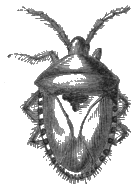
"The mother," says De Geer, "was accompanied by a troop of little ones, sometimes as many as forty in number. She remained constantly [81] with them, generally on a twig or leaf. I noticed that the little ones and their mother did not always remain in the same place, and that as soon as the mother began to move to another position, all the little ones began to run after her, and stopped whenever the mother halted. She used to take them, as it were, for a walk from twig to twig, or from one leaf to another, parading up and down the branches of the tree, and she conducted them wherever she pleased, just as a hen does her chickens. It frequently afforded me great pleasure to observe their movements. One day I cut a young branch of the birch-tree inhabited by such an insect family, and I immediately saw the mother, apparently in great anxiety, begin to flap her wings violently, but without attempting to fly away, as though she would frighten away her enemy. At another time she would have immediately made her escape, thus plainly showing that she remained only in order to defend her young brood."
As if to furnish an instance of precisely the opposite import, the cruel and murderous father of this interesting little family is one of the greatest enemies the poor mother has to contend against. [82] This hard-hearted parent does not hesitate whenever he falls in with one of his children to seize him and eat him up! If the mother spies him at this horrible feast she immediately attacks him in the manner described; and does her utmost to deter him from his cannibal propensities, by placing herself in an attitude of determined resistance before him. Was ever mother's love more plainly manifested than this love? No other instance of an affection so strange and strong is to be found in the tribe to which she belongs.
The care of the earwig not only extends to her eggs, but also to her young larvæ. "In the beginning of June," writes the author last quoted, "I found under a stone a female earwig, surrounded by a number of little creatures which I discovered to be her tiny family. She did not attempt to leave them, and they frequently ran and crouched under her, just as chickens under the wing of a hen. I took them up and placed them under a sand-glass, under which I had put a little fresh earth. They did not bore into the earth; and it was most curious to see them running for shelter under the mother, and pushing about between her feet, while she remained perfectly [83] quiet. I fed them with pieces of ripe apple, which the mother seized and ate with great avidity, detaching morsels of it by means of her teeth, and swallowing them. The young ones also ate a little of it, but with less avidity."
When the eggs of the spider mentioned in the last chapter as so devotedly attached to its treasure as to prefer death to parting with them, are hatched, they make their way out of the bag by an opening in it, being assisted by the mother in this difficult task. De Geer indeed states that this is the reason why the mother clings so tenaciously to the bag of eggs, as if she knew that her assistance in extricating her young from it was necessary. But this is not altogether correct, as they are able to make their way out by themselves in due time. When the young larvæ have come forth from the shell they run towards the mother, and climb upon her body; some get on her head, some on her back, and some on her limbs. In this manner she carries them about, and is said to feed them until they become strong enough to shift for themselves. "I have more than once been gratified," (writes one of the authors of the Introduction to Entomology,) "by a sight of this interesting spectacle; [84] and when I nearly touched the mother, thus covered by hundreds of progeny, it was most amusing to see them all leap from her back, and run away in all directions."
For another instance of affection almost maternal for the young and helpless larvæ, let us take a peep into an ant's nest. So soon as ever the young larvæ emerge from the eggs they require the unremitting attention of the best and most careful nurses in order to rear them. They must be kept clean, fed, and taken for an airing as regularly as the day returns. By means of their tongues, which are incessantly used in licking them, their coats are kept of the most snowy white. They are fed three or four times a day by their nurses, who take care to masticate the food for them, and thus prepare it for their tender mouths. But the most strange part is their regularly being taken out for the benefit of the air and warmth. Some of the ants at the top of the nest watch for the first beams of the welcome sun, and, as soon as they pour upon the nest, they hasten down below in a great bustle to wake up the nurses, and bid them take the young ones out of their chambers and bring them up to the light, which these indefatigable ants [85] quickly set about to do. After basking there all day long the nurses take care not to expose the delicate constitutions of the larvæ to the chill evening air; and soon as the sun begins to sink towards the horizon they carefully take them up and carry them to the warm deep cell below. For fear, perhaps, of their taking cold, they never allow them to be taken out in raw, damp, or frosty weather. It must not be forgotten, however, that these ants are not the parents of the larvæ; they are only the nurses.
But it becomes us now to pursue the more immediate subject of these remarks, and ask the reader's attention to a few particulars about the larva. It is a great pity, for the sake of a clear perception of the facts of insect history, that there is a sad confusion of names in use among the majority of persons in speaking of the different forms and changes of insects. Who would imagine that caterpillar, grub, maggot, and larva, signified one and the same stage of the life of an insect? This abuse of terms cannot but render the knowledge of any science less easily retained than it would otherwise be, for the question is continually arising in the mind—If these all mean the same, [86] why is not one term enough to express them? Let us then renounce those of uncertain meaning, and when we wish to give a name to the insect just emerged from its eggshell, let us call it by its proper name, the Larva.[C]
The larva, then, is the first form assumed by the insect on quitting its shell. No more a little inactive object lies before us, as in the egg and its slumbering tenant, but a sharp fellow, full of life, and soon walking off the field of the microscope, should we happen to be looking at it in that way, or from our book or table, should it be there placed by us for observation. By what hidden and mysterious power this has been effected who can tell? It was not heat alone that could animate the contents of the shell, nor could all a mother's care do more than preserve it from injury. It is very possible that chemistry had some share in it, and when the tiny being first awoke in the shell the [87] oxygen of the air undoubtedly was necessary to its health, and the fulfilment of its early functions, but no more. Not chemistry, nor electricity, nor heat, nor any other known force could effect this wonderful change of apparently inanimate fluid into a lively, active, and well-organized being; much less could either of these give it its definite form, causing one larva to differ from another in its characters. No, we cannot tell how it has taken place, nor what has wrought the change; but we know the author of it—even Him who from the beginning created all things, and established those principles which, though hidden from our eyes, work out the marvels of the created world. It is enough for us to know and to remember this. Should we attempt more, we should probably fall under the Scripture reproof, "Professing themselves to be wise, they became fools."
Speaking generally, insects in the larva form appear as fleshy worms, having long and round bodies, marked with rings, and provided with a head and a certain number of legs, mostly six. How different in this condition, from the ballroom gaiety of the butterfly, or the elegant robes [88] of the lace-wing flies. To look at a number of larvæ, all crawling over one another, and bearing perhaps not the most loving behaviour to each other as they scramble about, who would dream that, in a little while, those slowly moving bodies will be whirled through the air faster than our feet can pursue, or even than the eye can follow? Who also, but one well versed in the knowledge of insects, could venture to say what insect could be formed by this or that larva, now so little resembling winged insects at all?
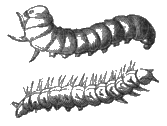
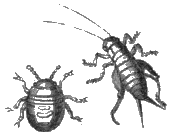
In studying the forms and appearances of various larvæ, we shall find that some of them bear a tolerably close resemblance to the future insect; while others, on the contrary, do not resemble their future condition at all; and had we to decide [89] to what tribe of insects they belonged, merely judging by their shape and character, we should be sorely perplexed to do so, and if we did, we should often in all probability be very far wrong. We need not go far for an illustration, first, of a larva like the perfect insect, and next, for one totally unlike it. Taking a candle and exploring into some snug hole near the kitchen fire-place, we shall not be long, probably, before we extricate a number of the larvæ of the cricket. Those of the bug also are very like the perfect insect; so also are young spiders, cockroaches and grasshoppers. These all resemble more or less perfectly the insect in its complete form.
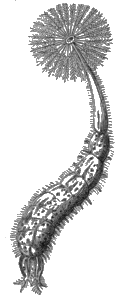
Even amongst the larvæ not resembling the perfect insect, a little attention will enable us to perceive a sort of general resemblance between those of different genera and species, which we may call the Larva family likeness. This consists in the form of the body, in a number of instances; but in all in the ring-like marks or segments of the body, as they are called, which are thirteen in number. If the reader will take the trouble to count the rings in the larvæ of different insects, he will generally find that they are thirteen in number. [90] The general resemblance of larvæ to one another may also be noticed. The larva is, in every instance, destitute of wings. In many cases, larvæ are provided with feet, in many others they have none. And in some instances, they have no distinct head, as in the larva of the blow fly.
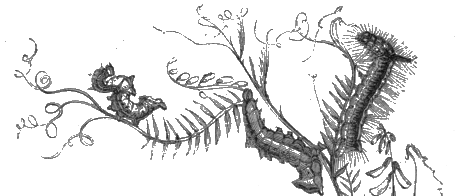
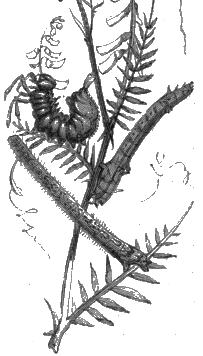
By far the larger number of larvæ belong to this class; that is, they do not resemble the perfect insect. Do not resemble! could any one believe that these strange, and some of them awful looking larvæ ever [91] became butterflies? yet they all belong to that tribe of insects.
In order to give a clear conception of the structure of a larva, we may briefly mention the names of its various parts. First then, there is a head of various shapes, sometimes of the shape of a heart, sometimes round or triangular. Attached to the head are the two antennæ; or, as they are commonly called, feelers, most probably an incorrect expression, as it appears that insects may possibly hear as well as feel by their means. At the side of the head are the eyes, which are formed much more simply than those of the perfect insect. Next is the mouth, provided with its upper and lower pair of jaws. Then there is the body and its legs; and lastly, there is in many larvæ, living in the water, a tail, which, strange to say, is provided with a delicate tube, through which the larva breathes. A beautiful instance of such an appendage to the body of the larva, is represented in the adjoining cut; [92] the various parts of the larva are also represented in the accompanying figure.
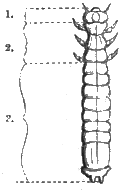
We may now enter upon a few particulars connected with the general history of insects in the larva form.
HABITS OF THE LARVA.
Generally, for a little while after the larva has emerged from the shell, it is in a very weak and languid condition. The effort of extricating itself from its little prison-house, seems to leave it almost without strength; and for a period which varies in different insects, it lies helpless and almost motionless at the mercy of any wandering adversary, and might be demolished without resistance. But this hour of weakness, except in a few cases, is not prolonged. In the course of an hour or two, or even much less in some instances, the larva revives, takes heart, and begins by eating whatever food may happen to lie in its way; and now the larva becomes a terror to the world of insects, or even, indirectly, to man and to nations. Instead of simply eating, in order to live, like most other beings, it only lives [94] to eat; it has no other duty to perform at present but to eat as fast and as much as it possibly can in a certain time; and it must be confessed, the larva, generally speaking, leaves little to be desired on the score of a sharp appetite. Unlike other creatures who allow themselves a certain period between their meals, the larva sets to its feast and does not leave the table until it has devoured all its contents,—upon which it immediately begins again elsewhere. No gourmand in the world, whether among human beings or brutes, can compare with the insect in this form for the amount of food consumed. Morning, noon, and night, is to it only a continued round of feasting; and, as may well be imagined, the larva grows very rapidly accordingly. Some larvæ consume animal, others vegetable food; or, in the language of science, some are carnivorous, some are graminivorous or herbivorous, and some will eat anything almost that comes before them—these would be called, and very appropriately so, omnivorous.
Let us speak of carnivorous larvæ first. The larvæ which have carnivorous propensities render themselves often truly terrible to the insect world around them. The most mighty warrior that ever [95] lived in his whole career never slew half so many of his own species as the larva of a beautiful fly does of aphides in a few hours. Well does Réaumur call them the "lions of the aphides," and thus does he describe their method of proceeding:—
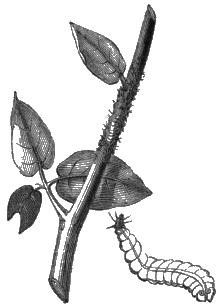 Lion of the Aphides.
Lion of the Aphides.
"There is no beast of prey in nature who hunts so entirely at his ease as does this larva. Resting upon a twig or a leaf, he is surrounded on every side by the insects on which he feeds; often, indeed, they touch his sides, and he is able to catch hundreds of them without changing his position. Not only do the poor little aphides not fly from him, but they may be often seen creeping over the body of their enemy. It is only after the larva has eaten up the greater number of his prey around him, that he has any need to remove to a spot as thickly inhabited by them as that in which he has been making his cruel ravages. In order to observe the manner in which he attacks them, the best plan is to take him, put him between two leaves, and shut him up in a box for ten or twelve hours to sharpen his appetite. After this fast he must be placed on some spot where the aphides are found in abundance. Immediately he begins exploring around for prey, which he does [96] simply by the sense of touch, as he does not appear to be able to see. At length an unhappy insect comes within his reach. Brandishing a trident with which he is armed, he immediately transfixes the insect, just as we take up a morsel of food upon a fork!" The little creature is then sucked into a sort of cavity like the neck of a bottle, where it is retained by a couple of pins until its juices are emptied by the destroyer, when he casts it away, now nothing more of it being left but a dry, shrivelled, empty skin. The aphis-lion, however, loses no time, and presently seizes another, which he pierces and sucks dry as quickly as the last.[D] When very hungry he will devour one a minute. Réaumur says, "I have seen him eat twenty of these insects one after [97] another in twenty minutes; nor did this satisfy him: for in the course of two hours he devoured more than a hundred insects with which I supplied him!" These larvæ do repose a little, but never for long, for they are seldom without some prey in hand. "I have seen," adds the last author, "twigs of the elder seven or eight inches in length entirely covered with these insects, (the aphides,) and in four days' time there remained not one alive."
This larva is a rare specimen of courage, as well as of destructive powers; for when it is quite young it often seizes upon an insect twice as big as itself. It is very amusing to see the unequal contest between the little but courageous foe, and his great, bulky, and stupid adversary. Immediately the larva thrusts its trident into the body of the enemy, who, stupid as he is, does not like the sensation of the wound in his side, and makes off as fast as he can. The lion-hearted larva follows him up and wrestles with him, and at length actually boards him, to use a sailor's term, clambering up his sides, and, in triumph, piercing him through and slaying him. What is perhaps most singular of all, the larvæ of some species of these [98] flies not only slay their victims, but actually clothe themselves, after the manner of Hercules on his victory over the Nemæan lion, with the skins of their prey!
It is almost to be regretted that the insect world has not had the privilege of having its combats sung by the poets. Who can forget the animated scenes, painted in such life-like colours by Homer and Virgil, of the conflicts, hand to hand, of the heroes of their verse? But the history of insects supplies us with more singular and more interesting deeds of fight than have ever yet been fabled by poets, or commemorated in song. In the instance we are about to quote, the larva of the ant-lion is the crafty Giant Grim, who lives by entrapping, as we have before said, poor wayfaring travellers. Like those giants of old, of whom we read in books a little more wonderful than true, this subtle and powerful enemy lies deeply ensconced in his subterraneous cavern, patiently abiding the time when his unsuspecting prey shall fall into his power. His trap is depicted on the opposite page.
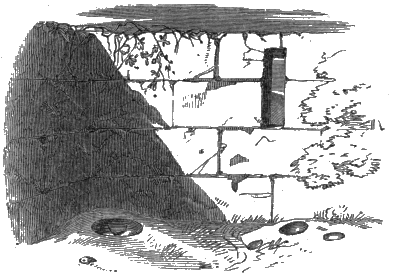 An Ant-lion in its Trap.
An Ant-lion in its Trap.
This insect is naturally a very helpless being, it can only walk at a slow pace, and strange to add, it can only walk backwards, and not forwards! [99] Yet its food is the juice of insect bodies. How, then, is it to seize upon them circumstanced so unfavourably as it is, having neither swiftness nor ability to direct its motions sufficiently actively to fit it for such a task? It succeeds by an artifice of the most refined character. Nothing daunted by what we might call its natural disadvantages, the insect sets bravely to work to construct a trap for its prey; and the manner in which this is performed may well strike us with wonder, and raise our admiration up to Him who has so marvellously endowed this humble being with wisdom and skill. It first takes care to choose out a proper site for [100] the work it is about, and in this always selects a soil composed of fine, loose, and dry sand, well aware that, as we shall presently see, no other would be fit for its purpose. Generally it chooses such a soil under the shelter of an old wall, where the rain cannot easily penetrate and ruin its work. In so doing it shows its wisdom; for thither, when the heat of the sun is great, or when the rain-drops fall heavily, crowds of insects come for shelter, and fall into its cruel embrace.
 Circular Ditch of the Ant-lion.
Circular Ditch of the Ant-lion.
The site being chosen, the next important step is to mark out the bounds of its habitation, and with this view the insect begins digging a circular ditch, walking backwards until it has completed the circle. This defines the outer limits of its trap, and is a sort of guide line to it in its future operations. Then it sets about the more proper task of excavating its trap. Would that our readers could see this insect at work! Of all the wonderful [101] sights presented to us in the insect world there is none to equal it in interest, none so calculated to enlist our sympathies on the part of the patient, skilful, and unwearied little labourers of this kingdom of nature. Guided by the line it has marked out, the workman steps into the circle, and sets to work with a hearty good will, and with a degree of diligence and excavating skill that would put our railroad "navigators" to the blush. Shower after shower of sand is seen flying up and beyond the boundary described, with the most unintermitting diligence, until the insect has completed the circle again; arrived there, it turns round and excavates back again until it arrives at the same point. But it may perhaps be asked, where are its tools, and by what means does it succeed in casting up these loads of earth? We fear that at best any written description will hardly do justice to our ingenious labourer; its method, however, is as follows:—It uses the head as the spade, or rather shovel, and in the strangest manner it fills the shovel with one of its feet with a load of sand, and then by a quick movement of the head tosses it out of the cavity. By working in alternate directions it manages so as never to [102] over-fatigue one leg, for on its return the leg previously in use is at rest, while the one on the opposite side is now called into duty. The insect thus works on until its trap is completely excavated, the task occupying a variable time; sometimes being finished in half an hour, sometimes even in less, but occasionally occupying several hours, the little labourer being obliged to rest a certain time. Réaumur, who has given a fascinating account of these insects, writes, "I have had at times hundreds of ant-lions in a large box, and I have often been amused with filling up their traps. Some of them would immediately begin to form another; but the greater number in the warm long days of summer deferred executing the work until the sun began to go down. They seldom worked in the heat of the day; but in cold or cloudy weather they would excavate at any hour."
We well know what perplexity a chain of rocky hills causes to a railroad engineer, and what vast outlays of money, labour, and time are necessary in order to overcome the obstacle thus presented to the path of the engine and its train. But it may be safely said that we can furnish a parallel instance [103] of difficulty and of patient, all-surmounting exertion from the history of the insect before us. M. Bonnet was curious to know what it would do if a stone or some such obstacle were met with in the process of its excavations, and one day had the gratification of observing the behaviour of the insect under these trying circumstances. Not being able to cast it out with its head, the insect determined to carry it out, if possible, on its back. With this view it contrived by various manœuvres to place the stone upon its back and to balance it there. This was the least difficult part of the undertaking. The insect had to climb up an inclined plane upon soil, chosen with other views purposely by itself, as shifting and unsteady as possible, and not only so, but to preserve the balance of the stone with which it was encumbered. Undaunted by these difficulties it made the attempt, but the first step brought down a shower of sand, and tumbled the little rock to the bottom. Again and again did the heroic insect attempt the same feat, and with the same ill success, and we might have thought we beheld a realization of the fable of Sisyphus and the rolling-stone, in the vain endeavours of the insect to get rid of its encumbrance. Five or six [104] times did the insect repeat its endeavours, and at last, after one or two narrow escapes, the stone was fairly lodged on the outside of the trap, and the insect returned to its subterraneous recess at the bottom of the cell in triumph.
The traps vary in size in proportion to the age of the insects which construct them. The young insects only form very small ones; but as even from the moment of their birth they are destined to toil for their food, they do not wait in idleness and hunger because they cannot make large efforts, but are content to make little traps not more than a few parts of an inch in diameter. Thus they set us the needful example of not despising to do small things because our strength is not yet equal to the performance of as much as we could desire. The diameter of the trap formed by a full-grown insect is about three inches; the depth about two.
When its labours are over, it has been well remarked, the insect now only requires patience—but it must have a good deal of it! It generally buries itself, all but its jaws, in the sand at the bottom, and here awaits its victims. If it requires much patience, surely it also needs to have much power [105] of endurance of hunger, for it may wait for days sometimes without catching any prey. Frequently, when this is the case, it marches out of its trap, and tries its fortune in some more favourable spot. But see! an ant who has been out foraging for the young ants at home is hastening back laden with sweet treasures, when suddenly she finds her path arrested by what appears to her to be a deep but smooth precipice. To plunge down and rise on the opposite side is a shorter cut, in her estimation, than to go round; or perhaps she is led by curiosity to wish to explore this singular cavity, and she plants her feet on its treacherous edge, causing a few grains of sand to roll down and give notice to the wary giant below that a victim is at hand. A step back, and her life would be saved; but no, she leaves the bank, trusts herself to the unfaithful soil of the sides of the precipice, and instantly rolls down in a cloud of dust to the bottom. Terror has now laid hold of her, and with all speed she strives to clamber up the unsteady sides. For a moment escape appears possible, but the Argus-eyed monster below starts up into activity, and piling upon his head a huge load of sand, he shoots it after the escaping ant, and once more brings her [106] down covered with dust into his embrace. The terrible jaws are instantly closed upon the unhappy insect, and in a few minutes her existence is at an end, the savage enemy shaking her violently, or dashing her quivering frame against the earth.
Singular to add, the ant-lion loves not dead prey, and will indignantly cast it out of its trap. Says Réaumur, "They appear so much to delight in the glory of a victory, that they disdain to touch an insect who is not, to say the least, in a condition to contend with them!" It certainly is not that the food when offered to it dead is not fresh enough that it is thus treated; for if only killed an instant before the insect still refuses to touch it. Réaumur is disposed to believe that, like our sportsmen, these interesting but cruel insects destroy prey more for the pleasure of exhibiting their superior skill, than to appease their hunger. But it is rather uncharitable even to the ant-lion, to say so much as this. When the insect has sucked all the juices out of its victim's body, it casts it out of its trap, and the earth around, strewed with dead bodies, is thus the silent witness to the destroying powers of the giant within.
This singular insect, whose exploits have detained us so long, remains in its larva form two years, growing daily in size until it has completed its existence as a larva, and must then enter upon another condition of life. It is to be regretted that it is not to be found in England, or at least it has not been for some time discovered in our island; but it is common in France and other parts of the continent, and would well repay the trouble of being brought over. As the insect is very patient of hunger, it might easily be conveyed in a little wooden box, half filled with fine sand, and its proceedings could be readily watched by placing it under a bell-glass, or in a little glass case, introducing a few ants or spiders for its food from time to time.
The insect exhibits to us a wonderful instance of what we may call, after the example of Dr. Paley, the principle of compensation in nature. It can neither run nor fly with the speed necessary to overtake its prey who are swifter of foot than itself. But God never created it to starve, and has endowed it with a rare combination of faculties by which it is enabled to live in the midst of plenty if not even of luxuriance. [108] So it is in a thousand other cases in nature. So it is indeed in Providence likewise. If He sends us trials, "He also makes a way to escape that we may be able to bear them." If our day is to be dark and cloudy, and to call for the exercise of much faith and patience, there is still the same provision made; "as thy day so shall thy strength be." If our lot in life is one of hardship He can, and if it is sought of him aright He will, and He does bear us up, revive our drooping strength, and enable us to go on our way rejoicing.
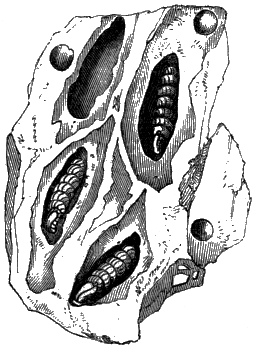 Cells of Sand-Wasp.
Cells of Sand-Wasp.
Let us go on to speak now of some other carnivorous larva. If in the month of July we can find out a spot where we can detect the traces of the labours of the sand-wasp, of whom mention has been made at page 15, and cutting out a little mass of the sand-rock containing several of their burrows, then take the trouble to open gently one of the cells formed by these insects, we shall see a carnivorous larva in as happy a condition as a fox in a hen-roost, or a mouse in the midst of a cheese! The best way to obtain access to this securely imbedded and luxurious larva, is to moisten the mass of sand with a little water, and then slice it gently down with an old knife until we come to [109] the cells. They are here represented. At the bottom of each we shall see the larvæ which have sprung from the eggs deposited in the manner before described, after the arduous and affectionate labours of the parent. Then above each is a heap of caterpillars, arranged with beautiful neatness, and larvæ and caterpillars are both fast locked in their prison house by the firm stopping with which the parent wasp has closed the mouth of the cells. These caterpillars are all alive, and are rolled into a ring-like form, but are so chained down that they cannot move in the least degree. The poor prisoners, like the sheep in the slaughter-yard, are only waiting their turn to be killed and devoured. The larva soon after it is hatched finds himself in the midst of a well-stored larder, and has nothing [110] to do but eat, which he does not long delay doing. He devours at his ease, and revels in the dainty fresh food which the care of his parent had laid up. When he has eaten all his prisoners up, and grown to his full size, he lays down to sleep, to awake again in another and a far different form.
 Larva of Wood-boring Wasps.
Larva of Wood-boring Wasps.
Sometimes the reader may have the opportunity, it may be, of finding out the nest of the wood-boring wasp, and he may in June or July, perhaps, succeed in discovering another instance of a larva in a happy state of plenty. The larva is sure to be found at the bottom, and above it will be piled a heap of insects for its food. What is remarkable about this store of food is, that the insects thus made prisoners are not dead, for they would, if so, soon become corrupted, and unfit for the diet of the larva; they are in a sort of half stupified condition, [111] in all probability very like that induced by the late plan of breathing ether and other vapours to render persons insensible to pain, while surgically operated on. Since this plan has been introduced, we read in some of the newspapers—we may question with what truth—that the butchers in Albany (America,) give ether to the oxen before killing them, so as to make them insensible to the pain of the death-blow! But the wasps in question have for ages been in the habit of effecting the same end by stinging their captives, the poison not sufficing to kill them, nor yet permitting them to be actively alive.
The insects thus stored up for the larva cost the parent many a conflict in their capture. And here we may interest the reader by describing the exploits of a warrior wasp, abundant in the Isle of France. It is curious that in the Isle of France the common bee is not to be found as a native of the woods, while, in the Isle of Bourbon, it is very common, and furnishes an abundance of wax and honey. This is explained by supposing that the warriors of whom we are about to speak destroy the bees, and have thus prevented their multiplying in the island in question. Truly, like the [112] banditti of whom we read in books, these wasps are splendidly attired, although not in the spoils of those they have robbed. Their head, chest, and body is of a resplendent lustre; now green, or, seen in another position, blue, and glistening with all the lustre of an exquisite varnish; their antennæ are black, their eyes of a brownish yellow, and their legs partly bronze-coloured, and partly of a beautiful violet. They are strong and swift of wing, and are possessed of a terrible lance, the thrusts of which even man cannot endure without far more pain and inflammation than attends an ordinary sting.
The foe with whom these magnificently-dressed warriors have to contend, is a kind of insect allied to the cockroach, which, in our kitchens, has acquired the incorrect title of "black beetle." This insect is detested by the inhabitants of the island, for its ravages upon almost everything of value or delicacy, and is not less hated by the sailor for its destructiveness on ship-board. It is called Kakerlac, and is much larger than the cockroaches, which are the plague and terror of our cooks. Imagine that one of these great and odious insects is marching along the highway. [113] The warrior wasp has also been making his expeditions for prey abroad, when suddenly his eager eye catches sight of the kakerlac hastening to some new scene of depredation. The warrior instantly alights, and the kakerlac stops, thinking perhaps to intimidate its adversary by its size and ferocious aspect. Both insects glare at one another;—
——"each other from afar They view, and rushing on, begin the war. They launch their spears; then hand to hand they meet, The trembling soil resounds beneath their feet; Their bucklers clash, thick blows descend from high, And flashes of fire from their hard helmets fly. Courage conspires with chance, and both engage With equal fortune yet, and mutual rage." |
Virgil's description, though scarcely accurate in all points, gives us a lively image of this insect combat. The kakerlac, however, is the Turnus, and the warrior wasp the Æneas of the fight. The wasp is the first to attack, and darts upon the other, seizing it by the muzzle with its strong jaws, then bending its body so as to bring its tail under the abdomen of the kakerlac, the lance with its charge of poison is deep-plunged into the body of the unhappy foe, imbuing a deadly venom into its system. Having made this thrust, the [114] warrior looses the foe, and soars in triumph a little way into the air, satisfied of a successful issue.
The wretched kakerlac, after a few brief convulsions, lies paralysed on the ground unable to stir a step from the spot where it encountered its terrible adversary. Fully aware of this, the victorious wasp, after taking a few turns, as if to proclaim the downfall of the Giant Kakerlac to the surrounding neighbourhood, returns to the scene where the conflict was fought. The kakerlac, unable to resist the victor, and being naturally, though a great devourer, a very faint-hearted creature, lies immovable while the wasp seizes the prostrate foe by the head, and in a sort of triumphal march drags it along the road to its nest. But though the kakerlac was not a difficult enemy to overcome, the weight and size of its body are a sore burden to the victor wasp. The way to the nest is long, tedious, and rugged. After a hard pull over all sorts of obstacles the wasp becomes completely breathless, and is obliged to let go, and for a rest it generally rises into the air, probably with a view of reconnoitring future difficulties, and of ascertaining the best [115] route to pursue. Thus, after alternately dragging along the body of its victim and rising up to spy out the path, at length the conqueror succeeds in bringing the carcase home.
Here, however, arises another difficulty. To attempt to get the body of the huge kakerlac in, is just as if one were to attempt to get an elephant through a small street-door. What is to be done? The wasp enters the hole backwards, and, seizing the head of the kakerlac, endeavours with all its might to drag it in, but all in vain. Many times it repeats these efforts with the same want of success; and now it appears that its labours in bringing hither the corpse, and its dangers in the battle, were all for nought, for the great body cannot be put in the place the wasp had designed for it. As if exasperated with the difficulties, out comes the wasp in fury, and falling upon the body of the kakerlac, hews off the large wing-cases, together with several of the limbs, and goes back into the hole again to repeat the attempt to get it in. Success at length crowns its efforts; by little and little the body becomes lost to sight, and finally disappears altogether from view, being carried down to the very bottom [116] of the nest. Here the larva, as soon as hatched, feeds upon it, thrives, and grows, and falls asleep, awaiting the time when itself shall awake to follow in the steps of the glittering and formidable warrior who, with the boldness of an amazon and affection of the tenderest of mothers, supplied it with nourishment during its hours of infancy.
This may be thought a scene of sad carnage, but the following will, perhaps, appear even more so. What should we say, if deep in the forests of some wild uncultivated country was found a den, the bottom of which was strewed with skulls, with bones, and mangled limbs? What fearful scenes should we not suspect to have taken place in this dark and horrid place; and as we shuddered in looking round upon its walls, as the once witnesses of terrible deeds, we might even fancy we heard the cry of the poor traveller, whose last agonies were seen by no eye but that of the monster who had waylaid and murdered him? Such a den may be found in the forest, made horrible by the cut-off heads, limbs, and wings of insects—it is the habitation of the carnivorous larva of a wasp. Nay more, as is seen in the engraving, the insect monster actually works up the cut-off wings and limbs into [117] a sort of covering for itself, and finally buries itself in a shroud partly made of the spoils of former victims.
 The Larva of a Wasp in its
coat of wings and limbs.
The Larva of a Wasp in its
coat of wings and limbs.
Perhaps the carnivorous larva of the tiger-beetle, or cicindela, is as ferocious a being as any in this state. In this respect, indeed, it resembles the perfect insect, whose title sufficiently indicates its swiftness, cunning, and blood-thirsty nature. "These larvæ," writes Mr. Westwood, "burrow cylindric retreats in the earth, to the depth of a foot or more, employing their legs and jaws in loosening the particles of sand and earth, which they carry to the surface upon their broad, saucer-like head, ascending by the assistance of the two hooks upon the back, somewhat after the fashion of a sweep going up a chimney! Having completed this burrow, they station themselves, by means of their legs and back hooks, at its mouth, their large flattened head and great segment filling the hole." Here they remain all day long, and many an insect might pass close by, little dreaming of the terrible foe who lay under that trap-door. Presently comes a spider scrambling over the ground in haste to mount up a branch [118] on which to hang one of its web lines; the treacherous trap-door is in its direct path. Its feet rest on it; instantly the trap drops, and the poor insect falls into the dark den, and is caught in the powerful jaws of the artful larva. Truly, there is something even to man a little intimidating in the sight of such a monster as is represented here; how much more to the unfortunate insect who happens to be caught in its embrace, and having only time to just catch a glimpse of its fearful captor, is dragged down in a cloud of dust to be devoured in darkness at the bottom of the den. Yet this also, like other cruel creatures, is in reality a very timid larva, and instantly on the approach of danger, drops to the bottom of the cell, where, if we have courage to pursue it, we shall find it much in the attitude in which it is here represented. The singular pair of hooks on its back are used as the flukes of an anchor to sustain the insect in the position it assumes at the mouth of the cell.

Mention has already been made in the previous chapter of the insects called Ichneumons, which deposit their eggs in the bodies of the larvæ of [119] other insects. These, when hatched, are also to be reckoned among the larvæ which prey upon flesh, since they devour the bodies of the larvæ in which they have been deposited. They are thus most useful to mankind in destroying the devourers of his vegetable food.
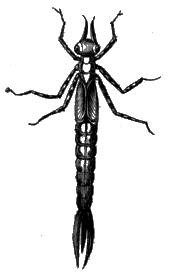 Larva of the Dragon-fly.
Larva of the Dragon-fly.
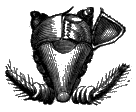
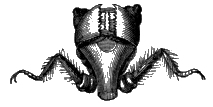
We may now see an instance yet more strange of a carnivorous larva. We must wend our way to the riverside in the months of May or June. There, after a diligent search at the bottom, in some moderately shallow portion of the stream shall we find a larva, the study of which might well occupy us for many pages. Yet it is the larva of an insect well known to every angler and brook-side wanderer—the dragon-fly. This larva is provided with one of the most remarkable contrivances for seizing its prey and conveying it to its mouth, of any being in the zoological kingdom. By the assistance of the engraving, we may perhaps be able to render this apparatus, which is somewhat [120] complicated, intelligible to the reader. Looking at the larva's head, we are reminded somewhat of that of a horse who has got blinders over his eyes, and a nose-bag over his nose, and partly up his cheeks. Now suppose the two blinders thrown back on each side, then conceive that the lower part of the face which we have supposed covered with a nose-bag were to be uncovered, we should then see the following curious contrivance. The lower lip of this larva is lengthened downwards into a sort of arm, if we may so speak; at what we may call the elbow, is a joint connecting the upper and lower portions of it, and the place of the hand is occupied by two cross plates, with a claw at the end of each. Suppose an unhappy insect, or even a tadpole, swims carelessly by the larva, immediately the two sides of the mask, or blinders, as we have called them, fly open; the arm is uncovered, the forearm let down, and by [121] means of the plates, which we have compared to the hand, the victim is caught, and bending the arm back, is presented to the mouth of the larva. There is much similarity in this organ with the wonderful apparatus of the elephant called its trunk; but of the two, the trunk of this insect is the most beautiful piece of animal mechanism. When the prey has been devoured, the arm folds up, covers the mouth and part of the face of the insect, and the blinders, or two side pieces of the mask, fall in, and lock together in a toothed manner, as the engraving in the last page shows.
 The apparatus in the act of seizing.
The apparatus in the act of seizing.
Thus provided, the larva is a formidable creature to the inhabitants of the pond or brook; few, indeed, more so. It preys with incessant activity on all aquatic insects that happen to come in its way, and sometimes, as we have said, even upon tadpoles. They do not even spare one another, and woe to the unhappy relative of the family who happens to wander near the abode of another of the [122] same family, anxious to begin his feasting for the day! So ferocious are they, that they even attack small fish, and make little work of swallowing them up. Not only are these creatures fierce, but they also possess all the cunning of a tiger or a cat. To watch them seize their prey is an interesting occupation, and as the larvæ are common enough, and may be easily recognised by comparing them with the accompanying cut, we may venture to recommend the amusement of observing their proceedings to the reader. A little way off lies an unsuspecting insect delighting in the warm sunshine, and securely floating upon the waters on the corner of a leaf. Such an idea as danger at hand is probably the very last from its conceptions, and pluming its bright and glossy wings, it beguiles away the sunny hour unmolested by a passing enemy, or a breath of air. The larva has marked it already for its own.[E] See it rouse itself up, and noiselessly make ready to pounce upon the unsuspecting lounger. It creeps stealthily along, concealing itself from view as far as possible, and not even the tell-tale glassy surface of the water feels its movements. Measuring its distance well, the [123] larva prepares to seize its prey; in a moment, swifter than the eye can follow, the victim is caught by the apparatus we have described, and in another instant, is in all the agonies of a violent death in the mouth of the larva. So exceedingly cautious are these larvæ in their movements, and so expert and active in darting upon their prey, that it scarcely ever escapes their power.
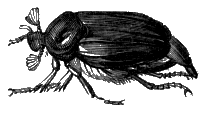

Having mentioned these particulars about carnivorous larvæ, let us consider some circumstances connected with those larvæ that are vegetable feeders—graminivorous or herbivorous. Of these, we could scarcely select a more destructive one than the larva of an insect well known to every school-boy from the times of Greece and Rome down to our own—the common cockchafer, (Melolontha vulgaris.) Our schoolboys, however, are less merciful than those of Greece, for they only tied a string round the leg of the unhappy cockchafer, [124] while these thrust a pin through its tail. Yet, its terrible ravages considered, the insect little deserves to be pitied; but, we are not therefore to be understood as by any means sanctioning the cruel and inhuman sport alluded to. These larvæ are hatched in a sort of little cavern dug by the parent insect's care under the ground in our meadows, or corn-fields. Here they begin their ravages by devouring the roots of the grasses which surround them on all sides. In this manner they very quickly destroy the plants, which wither and die in a manner quite mysterious to the agriculturist, if he does not happen to think of these insects. The turf soon becomes so completely undermined by these excavators, that it may be rolled off as smooth as if a knife had been used underneath to cut off all its connexions with the ground. In a few weeks, meadows which shone in all the fresh and luxuriant green raiment of Spring, change colour, and before Summer has yet come, and before the stalks of the grass are yet grown up, one would think Autumn had passed over the face of the field, from its dry and dead aspect. About seventy years ago, we are told these larvæ did so much injury to a poor farmer's [125] fields near Norwich, that the court of that city, out of compassion, presented him with twenty-five pounds. Some idea of their numbers on this farmer's property may be formed from the fact that the farmer and his servant declared, with very long faces, we may be sure, that they had gathered eighty bushels of them. Sometimes they even attack the roots of young trees, and in this manner do an incalculable amount of mischief to plantations. They were at one time so abundant in France, and did such immense mischief, that the Government, in order to get rid of them, offered a handsome reward for the best method of destroying them. A number of experiments were made, and it really seemed as if nothing would kill these larvæ, in the way of poison at least, for several poisons which are rapidly fatal to man and animals failed to produce the least effect on them. It was found, however, at last, that a solution of alkalies, such as potash and soda, were certain poisons to them, and should land be much infested with them, it would be worth the trial to water it with such solutions, especially as they tend rather to enrich the soil than otherwise. A French manufacturer, determining to turn the visitation [126] of these insects to good account, has succeeded in distilling an excellent lamp-oil from their bodies, and offers tenpence a bushel for them. From seventeen bushels he extracted twenty-eight quarts of good oil! In Hungary, a kind of grease is obtained from them which is useful for carriage wheels. The ingenuity of man may thus even procure good out of a very formidable evil, although the mischief done by the cockchafer larva undoubtedly far exceeds the benefit it confers upon its captors in the amount of oil extracted from it.
An insect almost equally familiar to all persons is the long-legged gnat, of whom the famous children's rhyme runs:—
|
"'Old father long-legs' would not say his prayers; Take him by the left leg and throw him down stairs." |
Many of our farmers would be glad, no doubt, if taking him by the left leg would keep him out of their meadows, for there this insect commits fearful ravages in the larva form. In some parts of England it has as completely destroyed the pasture-grass as if it had been consumed by fire. In the spring of 1813, hundreds of acres of pasture in the rich district of Sunk Island in Holderness [127] were entirely destroyed by it, being rendered as completely brown as if they had suffered a three months' drought, and no other vegetation but that of a few thistles was left on land, which, at more favoured periods, was more than commonly luxuriant. On a square foot of the turf being dug up from the affected spot, the enormous number of two hundred and ten larvæ was counted in it. Fortunately, the next year showed a very different result, for then it was difficult on careful search to find one! In some districts of France it is also very destructive, the grass of large tracts being so completely destroyed by it, that enough food for the maintenance of the cattle is not to be obtained. These larvæ, like the last-named, appear to destroy by eating away the roots of the grass. From these and the foregoing facts, entomology teaches us to regard these two insects, upon which we commonly look with compassion, as occasionally becoming the formidable, though indirect, enemies of man. The scientific name for "Father Long-legs" is Tipula oleracea. The French call them oddly enough milliners, or tailors, (couturiéres, tailleurs,) a name of which it is harder to guess the origin than the common one of [128] father-long-legs, which is sufficiently expressive of one of the features of the insect in the perfect state: perhaps the French tailors are distinguished for being very long and thin!
 The Gamma Moth and Larva.
The Gamma Moth and Larva.
We may yet linger awhile in the fields for another illustration of the devouring propensities of vegetable-feeding larvæ. The pretty moth represented in the accompanying engraving, together with its larva, was once the cause of more alarm in France than we can readily conceive. It is often to be seen in our meadows plunging its minute drinking apparatus into the depths of the wild flowers, and flitting to and fro at no great height from the ground all the day long, and even after sun-down. It is called generally the Gamma moth, or Plusia gamma, in consequence of the little mark in its wings, which resembles the Greek letter [Greek: g]. Its larva is striped with green, [129] and when multiplied excessively, as was the case in France in the year 1735, produces scenes of desolation which, as the results of apparently an insignificant insect's doings, can scarcely be credited. In the months of June and July in that year they became so numerous, that the gardeners and peasantry in the districts plagued by them declared that they must have been created by enchantment. In some places Réaumur was assured that an old soldier had been seen to throw the spell. In other places an ugly old woman, who was as wicked as she was frightful, had caused all the mischief. Their prodigious numbers appeared to the ignorant and superstitious peasantry an indubitable proof that they were created by sorcery. And though we cannot, of course, sympathise with their thoughts on this subject, we can well imagine and feel for their astonishment and dismay as they beheld the wide desolation of every green thing produced by the innumerable millions of these larvæ, which covered forest, field and garden with their bodies. Many persons began to fear they were really poisonous creatures, and refused in consequence to partake of salads or other vegetable food of a similar kind. This was [130] probably an equal error with the last; and it is very droll to find the talented Réaumur pleading with great earnestness that the caterpillars were not unwholesome as food. He even declares his opinion, that if these creatures were to become excessively numerous in France, the inhabitants might be compelled to treat them as the wretched inhabitants of Africa do the locusts, and when they have eaten up every green thing, fall upon and eat them. With as much learning and eloquence as if he was treating one of his most favourite topics in entomology, M. Réaumur recommends these larvæ for human food, adding, that a very little time would enable us to conquer our disgust at such aliment, and that we should even welcome to our tables a dish of the larvæ in question as an agreeable luxury! It is to be hoped, if ever such a custom be originated, it will be confined to the place of its birth—the country of this great, but, in this respect, whimsical naturalist.
To account for their excessive multiplication, we have no need to have recourse to enchantment for a solution of the difficulty. Each of the gamma moths produces about four hundred [131] eggs; now, if there were only twenty larvæ in a certain locality which lived through the winter, and became perfect insects in May following, the eggs deposited by these would, supposing all to be hatched, produce, according to a calculation made by Réaumur, in the course of a single year, eight hundred thousand larvæ. Well may we exclaim, then, with this learned author, "Should we not rather wonder at the wisdom and forethought which has ordered matters so that these insects increase to annoy us so rarely?" The wonder is, in truth, not that they should multiply so excessively at particular periods, so much as that it should be so seldom that they are multiplied even to the extent of which they are naturally capable. Thus, if we suppose that all the eggs of the moths of this species were to be hatched, it is more than probable that a large portion of our vegetation would be consumed by them. How is this guarded against? In various ways. The eggs are not all capable of being hatched, or if so, are not allowed to escape injury by various accidents, and the larvæ themselves are a prey to countless enemies among the birds, while they also frequently perish owing to the [132] severity of winter. From these considerations we may readily perceive how completely the well-being of a great nation, with the lives of a large portion of its inhabitants, are dependent upon the preserving, protecting, and restraining influence of the providence of God. With the return of every year, we may say, the question is asked by this tribe of insects alone, "Shall we go forth to destroy and devour at once, or shall we refrain?" With every year the silent reply is experienced by man in the unmolested condition of his fields, gardens, and vineyards. "Oh!" we may ejaculate with the Psalmist, "Oh that men would consider these things! then should they understand the loving-kindness of the Lord."
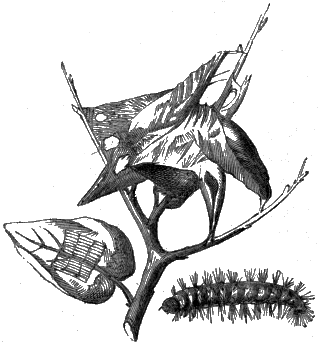 Destructive Larva and its Nest.
Destructive Larva and its Nest.
Another and more remarkable instance of the destruction caused by vegetable-eating larvæ may be quoted from the fertile pages of the same illustrious naturalist, M. Réaumur, particularly because it is the narration of one who was an eye-witness to the facts of which he speaks. "In two journeys," he writes, "which I made from Paris to Poitou, at the commencement of the month of September in 1730, and also in 1731, I noticed that from Paris all the way to Tours [133] every oak, great and small, had been attacked by larvæ; the highest branches appeared to be principally selected by them. Great isolated oak trees, as well as those which formed dense forests, were alike attacked in this manner, their summits being absolutely withered and dry. Had we not known how greatly the larvæ may multiply, and what fearful ravages they are capable of committing, one might have conceived that some hot and blasting wind had reduced the leaves to this condition. In certain districts, the hedges along the [134] road-side had not a single leaf that was not withered up." The engraving represents one of these mischievous larvæ; it also shows the winter-nest into which they creep, and a leaf which a regiment of them have already attacked.
Securely protected from the severity of the winter of 1731, in their warm nests, these larvæ quitted them again early in April of 1732, to set forth upon another mission of destruction. They had now multiplied to a degree calculated to excite the most serious public alarm. It began to be feared that the leaves of the trees would not be sufficient for the support of the devouring millions; and that if, during that year, the larvæ multiplied in the same proportion as in the preceding year, a famine more terrible than any recorded in history as produced by insect destroyers would be the result. These fears were in some measure groundless, as, in all probability, so soon as the larvæ had devoured all the leaves, they would rather have perished of hunger than have attacked the grass and other plants. But the matter was sufficiently serious as it was. The French parliament took the alarm, and determined to resist the threatened invasion of these small but formidable enemies. An [135] edict was therefore issued, calling upon all persons to assist in removing the larvæ from the trees, while they were as yet not reinforced by the addition of countless millions more. In orchards, gardens, and pleasure-grounds this became a far from difficult duty, because it was easy to ascend the trees and to remove the larvæ and their nests. But in dense forests, where the tall trees waved high in the air, and where every branch and every twig was loaded with larvæ, it was plainly impossible. Although, as we know, acts of parliament are able to effect a great deal, these insects set their powers at defiance, and little good was really accomplished. Having thus, as it were, manifested to the nation how powerless were their efforts to remove the plague, it pleased God to interfere by his providence, and a succession of cold rains for three days in May effectually stopped the progress of the destroyers, by utterly annihilating them.
Réaumur's remarks well deserve extracting; he says:—"I had been hoping much from the effect of these showers, and attentively watched what would be the result. I saw day by day that among the little bands of larvæ which were aggregated together in order to cover the twigs of the [136] trees with silk, or to despoil them of their leaves, there were many whose bodies became flabby, elongated, and devoid of roundness. These quickly perished. Every day the mortality became more serious among them. In a short time the larvæ, which had previously swarmed upon the trees, became so few, that before ten or twelve days had passed by I could not find a single one, although I looked carefully for them." It is remarkable enough, and sets forth strikingly the short-sightedness and ingratitude of man, that these very showers, which produced what no combined efforts of human power could or did effect, were bitterly complained of as inappropriate to the season, at the time when they were falling! These larvæ were hatched from eggs deposited by a common species of moth.
Although England has been often mercifully spared while continental countries have largely suffered by such visitations as we have last described, we have not always come off unscathed. The larvæ of a moth nearly allied to, if not the same as the last-mentioned, produced an alarm in 1782 in our country, perhaps even more extensive than the previous one in France. All sorts of [137] strange and silly rumours were spread abroad; some believing that the larvæ were the harbingers of coming disease and death. Poor people were hired to cut off the webs of these larvæ at the rate of one shilling a bushel, and they were then burned under the inspection of the churchwardens and overseers. In the parish of Clapham, we are told by an author who wrote upon the history of this insect, eighty bushels were collected in one day! Prayers were offered up in some churches to deliver the country from the apprehended approaching calamity.
We need not, however, dwell longer upon the vegetable-consuming larvæ out of doors. Unfortunately we are acquainted with instances equally formidable within our barns, store-houses, and larders. In vain does man lay up the increase of his fields with care in granaries of the best construction, and using all possible precautions against the introduction of insect enemies. The weevil, called scientifically the Calandra granaria, finds entrance, and in a short time makes its presence felt in the vast destruction it produces. So soon as they are discovered, they are collected with all expedition by the owners of the stores and consigned [138] to the flames for their misdeeds. Sometimes they are collected thus by bushels, from which it may readily be conceived what has been the amount of damage they have done.
There is a little moth whose larva is equally mischievous in appropriating to its own use the food and property of man; its name is the Tinea hordei. This fly, we are told, deposits perhaps twenty or thirty eggs in a single grain; but as one grain only is to be the portion of one larva, so soon as they are hatched they disperse by mutual consent in a very amicable manner, and each selects its future home, so that in a short time the whole family is comfortably lodged in twenty or thirty distinct grains of corn. There, surrounded by food, they live and thrive, eating up all the precious parts of the grain, until nothing remains but the husk. They then fall asleep and enter upon the further stages of insect development. No one could possibly tell by the external appearance of the corn, that the least mischief had taken place within, the fulness and general aspect of the grain being the same; but on carefully examining it, a very minute hole may be found in some spot or other;—it was here the enemy got [139] in. We need scarcely add, that for any purpose grain which has been thus attacked is rendered perfectly useless.
Any one who has ever been on a long sea-voyage will find it easy to supply us with another example of a vegetable-food devouring larva. The hard substances commonly called captain's biscuits are the objects of attack, together with flour, peas, and similar articles of food, and the attacking insect is the larva of the meal-worm, the entomological title of which is Tenebrio molitor. In vain does the ship's cook, with all his art, prepare a soup composed of the richest ingredients, and calculated, as one would think, to gratify the taste of the greatest epicure. The larvæ have been beforehand with him; they have attacked and become mixed with the flour or the peas; and when the soup which has cost him so much pains is brought to table, not even the keen appetite of seafaring people can reconcile them to it, for it is full of the dead bodies of these larvæ. So likewise is the biscuit, and in disgust the guests are compelled to confine their attention principally to such articles of food as are unpalatable to their insect enemies.
We have but little experience, in our favoured land, of the more extensive domestic destructions wrought by larvæ. But in hot countries they become formidable, by reason of their numbers. In India,[F] particularly during the rainy season, the interior of the houses swarms with them; some climb the walls, some ascend the table, some feast on the viands, and altogether, by their numbers and appearance, they produce a degree of disgust and loathing at food, which cannot be overcome for a long time by fresh residents. We may mention, before concluding this part of our subject, that of those that do annoy us domestically, some have appetites for very strange kinds of food, some love wine, some vinegar, some butter and cheese; some revel in a pot of preserves, some attack our meat, and one is mentioned by Réaumur as delighting in chocolate!
If surprise be expressed that we have dwelt so long upon the eating propensities of larvæ, let it be remembered that it was formerly said at p. 94, [141] that the principal duty of the larva, so long as it lived, was to eat. It is born often only to eat as much as possible, and to grow as large as possible within a given time; and in obedience to this principle, we find larvæ with the sharpest of sharp appetites embark in their career of existence, eating from their birth, all the way along to their final change. It is therefore, obviously, a very important part of the larva's history of which we have been speaking for some pages past. Considering the fact to have been now brought into sufficient prominence, we shall proceed to notice the rate at which larvæ grow, and the actual quantities of food some of them devour. Let us speak of the last first.
 Silk-worm Moth and her Eggs.
Silk-worm Moth and her Eggs.
Silk, as the youngest of our readers knows, is the production of a little larva commonly called the silk-worm. Now, some years ago, the calculation was made that in the United Kingdom alone was [142] consumed, every year, not less than five million pounds of raw silk. By means of very accurate experiments, it has been ascertained that, in order to procure one pound of raw silk, we must have twelve pounds of the cocoons spun by these larvæ. In order to produce twelve pounds of cocoons, one hundred and ninety-two pounds of mulberry-leaves must be eaten up; or, which is the same thing, for every pound of raw silk, we have to supply to the worms one hundred and ninety-two pounds of leaves. We can now leave the calculation in the reader's hands; but we may mention the sum total: it is, that for every year's consumption of raw silk by our country, there is a certain consumption of ninety-six millions of pounds of mulberry-leaves; and as one hundred pounds of leaves are calculated as the produce of one tree, it follows that nine millions six hundred thousand mulberry trees must grow, in order to supply food to the silk-worms necessary to furnish Great Britain with silk for one year. Let us add, that this five million pounds of raw silk is the production of the inconceivably great number of eighteen thousand million silk-worms. The Count Dandolo, who has written an excellent treatise on this subject, in [143] Italian, made a number of experiments upon the actual quantity of leaves devoured by the larvæ hatched from an ounce weight of eggs; and he found that the quantity of leaves consumed by them up to the completion of their development as larvæ, amounted to upwards of sixteen hundred and nine pounds! In a month from being first hatched, each larva consumes above an ounce of leaves. As at first each larva only weighs the hundredth part of a grain, it follows that it devours, in thirty days, about sixty thousand times its original weight of leaves. If we suppose a puppy dog, just born, to weigh a quarter of a pound, and to eat in the same proportion for one month, it would have consumed, at the month's end, fifteen thousand pounds of food. Could the puppy eat meat from the first, which, as all are aware, he cannot, he would, at this rate, devour in one month, from the time of his birth, one hundred and fifty sheep, supposing each to weigh one hundred pounds; or about five sheep for his daily food! These calculations will show how voracious the larvæ of the silk-worm are; and they are, probably, far from being among the most voracious of the larvæ, only we are better acquainted with [144] their rate of devouring than with that of other insects in this state.
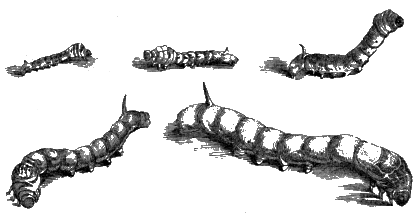 Growth of Silk-worm Larvæ.
Growth of Silk-worm Larvæ.
All this eating cannot, of course, be unattended with a great increase in the size of the larva. In some insects growth is prodigiously rapid. A naturalist, who closely investigated this subject in the common blow-fly, which is so apt to deposit its eggs upon meat in hot weather, found that in the space of four-and-twenty hours, the larvæ hatched from these eggs had increased to from one hundred and forty to two hundred times their original weight. The larva of the great goat moth, we are told by another, grows, altogether, to about seventy-two thousand times its weight; but it takes three years so to do. In thus growing, [145] the larva becomes very fat and plump; and should it unhappily cross the path of any bird, it would probably be nipped up as a dainty morsel for the little ones in the distant nest. In birds, beasts, and fishes, the rate of growth is much slower, and the amount of increase much less. Fortunate is it for us that it is so; for what would become of mankind if animals of the size of dogs could grow in a month to the size of elephants, or young elephants to the size of little hills? yet these comparisons are not exaggerated, remembering the increase and growth of the silk-worm and of larvæ generally.
MOULTING OF THE LARVA.
We are now to enter upon a very interesting part of the history of a larva: this is called moulting, and consists in the larva casting off its old skin, and appearing clothed in a new garment, often more brilliant than before. The change is well and clearly described in the following passage from the Introduction to Entomology, of Messrs. Kirby and Spence:—"A day or two previously to each change of skin, the larva ceases eating altogether; it becomes languid and feeble; its beautiful colours fade; and it seeks a retreat in which it can undergo this important and sometimes dangerous and even fatal operation in security. Here, either fixing itself by its legs to the surface on which it rests, or, as is the case with many caterpillars, by its pro-legs, to a slight web [147] spun for this purpose, it turns and twists its body in various directions, and alternately swells and contracts its different segments. The object of these motions and contortions seems to be, to separate the exterior skin, now become dry and rigid, from the new one just below it. After continuing these operations for some hours, resting at intervals, without motion, as if exhausted by their violence, the critical moment arrives: the skin splits in the back, in consequence of the still more violent swelling of the second and third segments. The opening thus made is speedily increased by a succession of swellings and contractions of the remaining segments; even the head itself often divides into three triangular pieces, and the enclosed larva by degrees withdraws itself wholly from its old skin." The engraving is intended to show the larva just escaping out of its old skin.

Sometimes the larva comes out of its skin at the side; sometimes it has been seen to bite off portions of the skin. The most common way is that above described. The skin, when cast in this manner, resembles a sort of universal coat, which [148] has fitted into every crack and joint of the insect's body; and just as a lady's glove, if we could suppose it tinted of a flesh-colour, and marked for the various markings on the hand, might be mistaken, if cast down after inflating it with air, for a hand cut off, so, only far more closely, does the cast skin represent, in the minutest particular, the larva which has emerged from it. It is a perfect mould of all its parts, even to the very antennæ, eyes, jaws, &c. "Thus," say the authors last quoted, "if you saved the skins cast by the larva of the insect called Callimorpha, or Arctia Caja, you would appear to have ten different specimens of caterpillars, furnished with every external necessary part, and differing only in size and in the colour, perhaps, of the hairs, and all representing the same individual."
In order to show how completely this is the case, some singular experiments have been made by various observers, in the following manner:—Just before the larva was about to cast off its skin, they have, by means of a sharp instrument, cut off one or two of its feet. The larva was then allowed to moult, and was carefully examined, and it was invariably found that the feet cut off when [149] in its old skin were also wanting when it appeared in its new robes; thus plainly proving that the feet were really sheathed in the old skin completely. It was just as if we had gloves on our hands and were to put one finger or more between a pair of sharp and powerful shears, we should, of course, find that when we took off the glove we should be short of one or two fingers!
But the hairs are not thus sheathed. The old skin, if the larva was a hairy one, such as many of those with which we are familiar under the more popular title "caterpillars," is cast off with the hairs attached to it—a circumstance which makes the cast skin look still more like the real larva. How, then, it may be asked, does the larva acquire new hairs to take the place of the old ones? Were we to take a larva just before its moulting, and by a sharp and delicate instrument, to slit open and raise its old skin, we should soon perceive how this has been contrived. We should there perceive sundry little tufts of very delicate hairs, lying down smoothly on the surface of the larva's body, and arranged in certain directions, with great regularity. When the old skin is cast, in the course of a little time these hairs stand [150] upright, and assume precisely the same appearance as those on the former skin.
The keeper of silk-worms can tell us well, and perhaps with many a sigh, that the period of moulting is one of great peril to his tender charge. The larvæ are sick and feeble for some time after each period of moulting; and large numbers die at this time, apparently unable to bear the exhaustion attending the loss of their old skin. Larvæ generally are much debilitated by each moult that takes place; for a variable period, sometimes for some hours, sometimes for a whole day, they will refuse food, and lie without motion. All their parts are very soft and tender, and require hardening by exposure to the air. After a certain period, however, these effects pass off; the larva recovers its original strength, its body becomes firm, its colour brightens, and appears more brilliant than ever; and, above all, like convalescents among ourselves, its appetite is twice as keen as before, which, when we call to mind what has been already said about the voracity of larvæ, it will be confessed, appears scarcely possible.
These changes of skin take place a definite number of times in the larvæ of each species. The [151] breeders of silk-worms tell us that that precious, if not priceless, little larva, sheds its skin four times; other larvæ moult oftener than these: some five times, some seven times, some eight times, and some nine, or even ten times; others, again, only moult thrice. The ordinary number of moults appears to be about three or four. Some, however, never moult at all in the larva state. The larva of the common bee, and that of the flesh-fly, and some others, are among this number.
Whatever may be the general opinion upon the want of beauty and comeliness in insects, and particularly during the larva stage of their history, it is very certain that it is quite erroneous. We may possibly fail, unaided by the pencil and colours of the artist, in conveying even an approach to an adequate conception of the rich and glowing raiment with which it has pleased God to clothe these minute and humble beings. But a very little actual observation of a few even of the commoner larvæ or caterpillars of the butterfly and moth species, will convince the reader that few other created things have been so exquisitely adorned with magnificence of colour and apparel [152] as the larvæ of these insects. Here will be found hues so rich and deep as to—
|
"Make the rose's blush of beauty pale, And dim the rich geranium's scarlet blaze." |
Here is a larva of a moth before us whose head is a delicate orange colour, whose belly and feet a pale pure green, whose sides are of primrose tint, variegated with slashes of green, and along the back there runs a beautiful band of white, the intensity of which is most agreeably relieved by a vein of lovely pink, which divides it in the middle. There is another clothed in purple, green, and white; another, the larva of the butterfly called the "Camberwell Beauty," is of a brilliant black, dotted with spots glowing like carbuncles along its back; another has a coat which seems as if set with precious stones, blazing with an intensity of colour which cannot be conveyed by description. In a word, larvæ, on the whole, can boast as varied a display of beautiful hues as can almost the whole array of flowers in our gardens. In consequence of the, unfortunately, too general feeling of loathing, to which allusion has already been made, but few persons are in reality acquainted with [153] their beauties. Their diminutive size also renders them less attractive than they might otherwise prove, since we are generally most pleased with the beauty of an object when its size makes it so manifest to our eyes, as to render it impossible it should escape our attention.
It is a very remarkable fact, and corresponds, to a certain extent, with the influence of the same agent upon plants[G]—that light seems to be in some measure necessary in order to develop the colours of the larva. Thus it has been noticed, that those larvæ which are, by their habits, much in darkness, dwelling, perhaps, in caves of the earth, or immured in the heart of a piece of timber, or inhabiting a cell scooped out of the solid rock, are, most frequently, of a uniform whitish colour. Some experiments have shown that when these whitish larvæ have been brought out of darkness and exposed to the sunlight, their colour has turned to brown. Very probably this effect is due to precisely the same kind of change as takes place when a fair-skinned European travels into a southern clime, his face and hands becoming so brown, tanned, and dark, as to form a ludicrous contrast [154] to the whiteness of his chest or arms, which are not exposed to the influence of the solar ray.
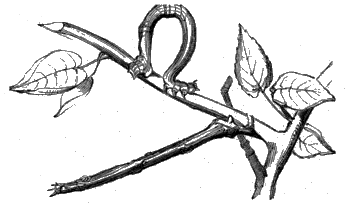 Larvæ resembling Twigs.
Larvæ resembling Twigs.
There is still something more to be said about the coats of the larva. To look at some of them, it would be difficult for a person unacquainted with entomology, to guess at the real nature of the object before him. Some look like dry twigs. Some look far more like little Cactuses than insects. Some are clothed with hairs, arranged in the most curious and eccentric manner. Some have hairs so long as to give them all the appearance of very minute shock-dogs. In some, the hairs are arranged like stars; in others, like the quills of the "fretful porcupine." The backs of other larva look just as if they were studded over with little camel-hair [155] pencils. Madame Merian has described the larva of an insect found in Surinam as having the various divisions of its body ornamented with three blue tubercles, like turquoise beads, from each of which proceeds a long, delicate, feathery plume of a black colour. Another, described by the same lady, is splendidly adorned on each side with fifty red tubercles, shining like coral, from each of which proceed five or six long hairs. Some, again, are covered as thickly as possible with sharp processes, like thorns, sufficiently strong and sharp to pierce the skin of any one who incautiously ventures to take them up. The body of a small caterpillar brought from Brazil, is described by Kirby and Spence as possessing a body so thickly planted with spines, like the branches of a tree, as absolutely to wear the appearance of a forest or thicket in miniature! It has been stated, indeed, by some travellers, that the larva of some insects has the power of darting out, when alarmed by the approach of anything, such as the human hand, from as many knobs or protuberances in its back, eight bunches of little stings, with which it inflicts a very painful and venomous wound.
 Singularly coated Larva.
Singularly coated Larva.
The larvæ of some insects again seem as if they were clothed from head to foot in the most delicate and snowy white cotton wool. These may sometimes be seen on our apple-trees; but one of the most singular is figured in the cut, from an engraving given in Baron de Geer's work. The larva is covered completely with a coat of cottony flakes of the most dazzling white, and these are arranged, as will be perceived, with great regularity. The larva has, in this white and warm raiment, somewhat of the aspect of a coachman buried in the old-fashioned great coats with the many capes.
Having dwelt so long upon the food and clothing of the insect in the larva form, it is right we should now devote a little space to consider how they breathe. Some one perhaps will say, Breathe?—do larvæ breathe? Most certainly; and respiration, or the function of breathing, is not more necessary to us than it is to these creatures. For this purpose, however, we must begin a fresh chapter.
RESPIRATION OF THE LARVA.
We well know, from the various melancholy accidents which have taken place, that unless human beings have a constant supply of pure fresh air they must perish. Many years ago, a number of unfortunate persons were shut up in a narrow cell, called the Black Hole, at Calcutta, where they could scarcely find room to stand, much less obtain air to breathe. In one night the greater part of them died. More recently, as some poor Irish were being conveyed in a steamer in stormy weather, the captain, out of prudence and mistaken kindness, ordered the hatches to be all battened down, so that fresh air was prevented from getting in. A shocking spectacle was beheld soon afterwards:—in the close, suffocating cabin lay a number of dead bodies, of men, women, and children, all destroyed by the want of air. Now, precisely the same fatal results [158] take place if we treat larvæ in the same manner; from which we learn that undoubtedly breathing is not only one of their functions, but a most necessary and important one.
This may be easily proved. If the reader will procure about a dozen caterpillars of any common kind, and put them into a dry phial, corking them closely up, and if he leaves them in their prison of glass a sufficient time, all will die, even though he may have supplied them, on putting them in, with an abundance of food. Clearly, therefore, they do not die of starvation, and we should be naturally disposed to say they must have died of suffocation; that is, they died because the function of breathing could not take place, as there was not the necessary change of the air contained in the phial. But suppose that other caterpillars were procured and put into another phial, with a sufficiency of green food, the mouth being covered over with a piece of muslin, or fine lace, what would then be the result? Simply that they would live and thrive for as long a period as they received their proper quantity and quality of food, and would pass through all their stages of existence as comfortably as if in the open air. The reason would be because the open fibres [159] of the muslin, or lace, do not interfere in the least with the requisite change of air for respiration.
Again, if after corking up the bottle for a short time, we were to shake out all the caterpillars from it, and then put into it a little water, in which quick-lime has been slaked—sold by chemists under the name of lime-water,—we should find it become quite white and milk-like. This would be, because, as the physiological chemist well knows, the function of breathing causes carbonic acid gas to be poured out of the body, no matter whether it is the body of an insect or an elephant; and this gas has the property of turning lime-water of the colour mentioned. Hence we have a second and convincing proof that larvæ breathe—we need scarcely remind the reader that caterpillars are larvæ—and more than this, that the function of breathing in them resembles, so far as the discharge of this peculiar gas is concerned, the same function, whether carried on in the human body or in that of the most mighty and majestic of the beasts of the field.
The great chemist, Scheele, has experimented, somewhat in the manner we have recommended, upon the breathing of larvæ. He found that when [160] caterpillars and maggots, to use the customary terms for these varieties of larvæ, were confined in vessels containing only about eleven cubic inches of atmospheric air, and so stopped as to preclude the ingress of any fresh air whatever, although furnished with an abundant supply of food, they soon died. When he put them into a still smaller vessel, they died the sooner. In fact, precisely in proportion to the purity, or to the amount of the air contained in the space in which he confined them, were their lives prolonged or shortened. He found on examining the air that it contained, as above stated, carbonic acid gas.
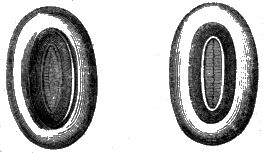 A Spiracle open. The same shut.
A Spiracle open. The same shut.
We may, therefore, consider the question as settled—that larvæ do breathe. Strange it may appear to some, but neither in the larva nor in any other form of its existence do insects breathe by the mouth. How, then, it may be asked? We shall now describe their breathing apparatus very briefly. Along each side of the body runs a delicate tube for the conveyance of air, called a trachea, or when both are spoken of, the tracheæ; these channels run underneath the muscles and skin, and open to the air by little branch tubes, the mouths of which are called spiracles. Besides [161] these branch tubes which open to the air, the large tubes send off a great number of smaller ones, which extend to all parts of the body, penetrating even to the legs and wings. In some insects, the spiracles, or breathing holes, are defended by a pair of flaps, which swing to and fro, so as to let in the air, and close upon it after each inspiration. By this simple means the breathing of insects is carried on; the air enters the tubes, passes along them, and is then conveyed to every part of the body; after which, having fulfilled its duties, it escapes again. In man, and the higher animals, there is a separate place for the air in the body, which we call the lungs, and here the blood is conveyed to the air, in order to be purified. But, as we have just seen, in insects it is very different, for in them the air is conveyed by innumerable minute pipes to every portion of the frame. Such is the breathing mechanism common in larvæ which live in the air.
It will be readily imagined that those larvæ which dwell in the water must be furnished somewhat differently, in order to enable them to breathe. And here, as we shall now find, there are some very curious arrangements, in order to effect this object. They may be considered under two divisions. First, contrivances for breathing air while the larva is immersed in the water; and, second, apparatus for extracting the dissolved oxygen gas necessary for breathing from the water.
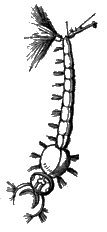 Breathing apparatus of
an aquatic Larva.
Breathing apparatus of
an aquatic Larva.
Let us select a few of the most singular instances under the first of these divisions. "No better example," write the entertaining authors of the Introduction to Entomology, "can be selected than the gnat. You must have occasionally observed in tubs of rain-water, numerous little wriggling worm-like animals, which frequently ascend to the surface, there remain awhile, and then bending their head under the body, rapidly sink again to the bottom. These are the larvæ of some species of the genus just named; and if you take one out of the water and examine it, you will perceive that it is furnished, near the end of the body, with a singular organ, which varies in length [163] according to the species, and forms an angle with the last segment but one. The mouth of this organ is funnel-shaped, and terminates in five points like a star; and by this it is usually suspended at the surface of the water, and preserves its communication with the atmosphere. In its interior is a tube which is connected with the tracheæ, and terminates in several openings, visible under a microscope at the mouth of the organ. The points or rays of this mouth are used to close it when the animal is disposed to sink in the water, and thus cut off its communication with the atmosphere. When the animal is immersed, a globule of air remains attached to the end of the tube, so that it is in fact of less specific gravity than water, and it is not without some effort that it descends to the bottom; but when it wishes to rise again, it has only to unclose the tube, and it rises without an effort to the surface, and remains suspended for any length of time. The extremity of the larva is clothed with bunches of hairs, which are furnished with some repellent [164] material which prevents their becoming wet. It is this repellent quality that probably causes a dimple or depression of the surface, which, if you look narrowly, you will discover round the mouth of the tube."
In summer time, the reader can scarcely fail of the gratification of watching these most curious creatures, for they abound in ditches, pools, and the stagnant waters of artificial fountains. They form a very curious object under the microscope, and particularly in the gas microscope, or solar microscope, where the image of the larvæ is thrown, as in the case of the magic-lantern, upon a white sheet, or wall. Their curious writhings to and fro, the energy they display in lashing about their tails, so as to throw the few drops of water in which they are imprisoned into mimic whirlpools, their occasional dartings down to the bottom, and subsequent gentle rise up to the surface, together with the terror into which countless minor occupants of the same watery prison with themselves are thrown, when one of these comparative giants plunges into the midst of them, form a spectacle as unique as it is interesting and diverting. A sharp eye, and a phial and cork, are the [165] alone requisites for finding out these singular beings on most fine days in summer. But a little while ago the writer was amused to find, on a sunny day in June, the water of a small fountain playing before his study window, thickly populated with these active larvæ, and it became an amusement which seldom wearied, to watch their fantastic evolutions, and to trace their changes from the larva through the ulterior stage up to the perfect insect. To this, however, we shall probably have occasion to revert before the conclusion of this work.
Another instance of a curious contrivance for assisting the breathing of a larva, whose body is wholly immersed in water, may also be found near home. Most probably the majority of our readers have seen, or at any rate are well acquainted with the apparatus by which the diver descends and works under water. Lest some should not, we may mention that it consists of a water-tight dress, which covers the diver from head to foot, while his head is enclosed in a helmet, or hood, furnished with a pipe or hose, which is long enough to reach to the surface of the water, and is there generally connected with [166] an air-pump, which forces down fresh air, and so enables the man to breathe almost as comfortably as if he were walking on land, instead of at the bottom of the sea. Let it be conceived now that there were no air-pump at the top of the hose, but simply a buoy of cork to keep it floating, and that the diver had the power of shortening or lengthening the hose at his pleasure, we should then have a tolerably fair representation of the contrivance with which Infinite Wisdom has supplied the humble creatures of whom we are about to speak.
By carefully examining the water running from manure heaps, or water which has become putrid, and is much loaded with mud and ooze, the reader will pretty generally be successful in discovering a number of the larvæ of a two-winged fly of the shape represented in the cut. When discovered, the singularity of their structure will amply repay him for the trifling unpleasantness attending the search after them. After washing them in a little fair water, and putting them into a tall ale-glass, or German beer-glass, which must be three parts filled with water, they will be in the best condition for our examination. When [167] Réaumur first beheld them, he gave them the name of Vers à queue de rat; that is, larvæ with a rat's tail; and when the reader looks at them, as shown in the representation annexed, he will be inclined to think with us, that a more appropriate title could not have been found.
 Rat-tailed Larvæ.
Rat-tailed Larvæ.
On watching them they will be seen to wriggle about until they are comfortably settled, darting from place to place, as if uneasy in their new position and in the pure element. By-and-by, however, they become reconciled to their lot, and lie perfectly quiet at the bottom of the glass in the position represented. From the tail of each will now be seen to rise a beautifully delicate and minute tube, which comes up to the surface of the water, and here, whatever be the movements of the larva below, it remains floating and free. Just as the diver may, while his companions above are pouring down torrents of fresh air, move about, and perform various duties under, [168] water, so the larva may move from one position to another, and assume almost any variety of attitude; but its little air-pipe still retains its perpendicular direction, and does not quit the surface of the fluid.
A singular experiment may now be tried with them. Let a little water be poured into the glass by means of a funnel, the end of which dips under the water so as not to give them unnecessary disturbance, and by this means the level of the water in the glass becomes insensibly raised half an inch or so. In a few seconds it will be found that these little tails have all lengthened themselves, and are again at the surface of the water, even at its higher level. More water may be poured in until perhaps the level is raised three or four inches, and still the same thing takes place, the larvæ still prolong their curious tails, until it seems as if they would stretch to an indefinite length, for they are already eight or ten times longer than the body! But, as we might jestingly say—the longest tail comes to an end at last; for, on continuing to pour more water in, the larvæ stretch their tails to the utmost, and then, finding the level of the water still above their reach, they become uneasy, and [169] all quit the bottom of the glass and attach themselves to its sides.
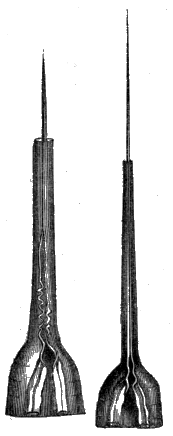 The Tail magnified.
The Tail magnified.
Let us now examine more minutely this very singular apparatus. By a good lens we may readily do this, as the organ is very transparent, permitting its internal structure to be beautifully seen. Placing the creature in a convenient position for our examination, and in a good light, it will be presently seen that the tail is composed in reality of two tubes, of which one slides up and down within the other, just like the tubes of a telescope (see cut). By this means the larva is provided with an instrument capable of being made to reach to a great length, and yet also possessing the capability of being packed up again in a very small compass. The proper breathing tube is the small inner one; at its extremity is a [170] pair of spiracles, or breathing pores, and surrounding these are placed five minute bristles, which are supposed to act somewhat as a buoy, and to retain the tail in its position. Where the tail joins on to the body of the larva, two tubes thrown into folds are placed, which are connected with the breathing tubes of the tail, at one end, and with the breathing pipes which run along the body of the larva at the other. When the tail is pushed out to its farthest, these zig-zag tubes are stretched quite straight; when it is drawn in again, they are thrown into folds. Both these appearances are shown in the plate. It has been supposed that the larva causes the tube to be pushed out by forcing air into it, and thus causing the zig-zag tubes to straighten themselves. Perhaps the tail is drawn in by the same tubes contracting again, and thus folding together and dragging back the tube to which they are connected.
 End of the Tail.
End of the Tail.
We need scarcely stop to mention how useful is this admirable contrivance to the insect. Having to seek for their food at the bottom of ditches, [171] drains, or puddles, they are necessarily exposed to the risk of suffocation, unless fresh air can be conveyed to them; and it is difficult for us to imagine how any apparatus could have been contrived which would have adapted itself to all the varying depths of water in which the insect must be constantly living, as it changes from place to place. He must have been a clever engineer who could have successfully met this difficulty. None of our present diving apparatus does so. The organ we have been considering, the creation of an Infinite Mind, small and despicable as it may seem in our eyes, fulfils perfectly every function for which it was formed. It admits of free movement from place to place, it admits, moreover, of free change from one level to another in the fluid by which the larva is surrounded, and it is at the entire disposal of the insect, which can, without the smallest inconvenience, accommodate it to the various circumstances in which it may be placed.
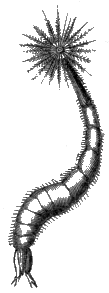 Chameleon-fly Larva.
Chameleon-fly Larva.
Possibly the same phial in which was brought home the last-named larvæ with the rat's tail, will furnish us with an equally elegant instance of larva-respiration under water, in the case of the larva of a fly, called the chameleon fly. This [172] little creature, if it can be found, and though not as common as the last, it may yet be detected, in summer by the edge of ponds, &c., has truly elegant habits. The great Swammerdam, who first described it, was lost in admiration at it. The extremity of its body is furnished with a coronet of about thirty elegantly feathered hairs. These are under the control of the insect, and are capable of being folded up, so as to enclose a minute bubble of air. When the larva is weary of remaining at the top of the water, and wishes to dive to the still and cool depths below, it causes these hairs so to fold up and close upon each other as to include the air-bubble, so that it cannot escape. Thus furnished with a pearl in its tail, it plunges downward, and thus breathes under water until the purity of the captive air-bubble is impaired, when it returns to the surface to repeat the same operations. The appearance of the little bubble shining, with a brilliant silvery lustre under the water, is very pleasing, and accounts for the [173] enthusiastic expressions used by Swammerdam, in speaking of the visible manifestation of the skill of God in this insect. The fact of an insect coming to the surface for air, and stealing away a portion, then diving down again into the waters, is not uncommon in insect history, although few are possessed of so elegant a contrivance for effecting it as the larva in question.
We must pass on to mention an instance or two of larvæ which, from the peculiarity of their respiration, come under the second of our divisions, that is, they live in the water, and do not breathe air, but obtain the gas necessary for their respiration from the water, which holds it in a state of solution. We shall first speak of the larva of the common May-fly, the perfect insect of which is so well known to, and highly prized by, anglers, under the various names of "duns" and "drakes," than which in some streams no insect that flies is a better bait to the unwary fish. Should the reader wish to examine them for himself, they may be found in May or June, hiding themselves during the day in the mud, or underneath stones, or in little holes in the banks, or taking a sub-aqueous tour upon the bed of the brook, while the [174] clear and purling waters roll smoothly on above them. Their little under-water cells are shown in the cuts, together with the larva.
 Cells of May-fly Larva.
Cells of May-fly Larva.
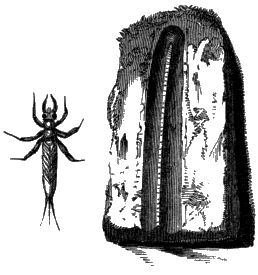 Larva and section of its cell.
Larva and section of its cell.
Their organs for breathing the water, if the expression, which is in some measure correct, may be admitted, are very like the gills of a fish. But instead of forming a part of the structure of the mouth and head, as those of the fish, in the larva they are placed along its body, and are arranged in pairs. A delicate little air-tube enters into each of these gills, and there branches out into a great many directions; this tube is connected with [175] the large trachea, or breathing vessel of the insect, running along its body. The air entering these gills, and thus being exposed to a large surface of water containing dissolved gas, loses its impurities, and absorbs the pure gas from the water, whence it is then conveyed to the various parts of the body. In many species of these larvæ the whole series of gills are moved to and fro incessantly, and so quickly as to be scarcely perceptible to the eye. Some of them use them as oars, moving with inconceivable rapidity, and being capable of darting both backwards and forwards with great quickness. They have also the power of leaping or springing in the water to a considerable distance; and feed on minute aquatic larvæ, and on vegetable matters.
The only other instance of this kind that we shall quote will be that of the terrible larva of the dragon-fly, whose deeds of insect murder came before us on a former occasion. The apparatus provided for them is very singular, and has been described with his usual accuracy by the talented Réaumur. It exists in the tail of the insect, and may be readily watched in action by adopting the following expedient:—Pour into a small glass, in [176] which the larva has been put, and which is half full of water, a few drops of a solution of carmine, by means of a little tube introduced into the water, and made to drop its contents near the tail of the creature. Immediately it will be seen that the coloured liquid is rapidly sucked in by the tail of the insect, and then, after the expiration of a little time, is forced back again in a tiny jet, with considerable violence, to a distance of several inches.[H] Réaumur tells us, that if we hold the insect between the finger and thumb gently, and let fall a drop of water on its tail, we shall presently see it eagerly sucked in, the body of the insect becoming sensibly larger; and by-and-by it is thrown out again. Sometimes it raises its tail above the surface of the water, and, whether for sport or not, it is hard to say, squirts the water in a mimic jet to some distance.
The apparatus has been described as resembling the piston or plunger of a force-pump, which moves to and fro within a cavity inside the insect's body, and by that means draws in and forces out the water. The tail is defended by a sort of [177] coronet, composed of five hard bristle-like pieces, which are under the control of the creature, and may be opened and closed at pleasure. The larva appears capable of inflicting a somewhat painful pinch by this contrivance, so that, what with its wonderful mask, with its powerful squirt, and with its tail thus armed, it would be difficult to select another insect better prepared for battle with creatures of every aquatic tribe than it. The action of the pumping apparatus sends it rapidly forward through the water, somewhat like a paddle-wheel, or at least upon the same principle as that contrivance, namely, the resistance offered by the water to the stroke of this apparatus.
MEANS OF DEFENCE OF THE LARVA.
There is, perhaps, no period in the life of an insect when it is so much in danger of the attacks of foes, as when it is in the larva state. Possessed, at the best, with but very feeble powers of locomotion, in comparison with those of winged insects, it is continually exposed to destruction on all sides, from which it has not the power to escape. Not only do insects of various species particularly select the larva for the object of their attacks, but birds and other creatures are also in the lists against them. Thus imperilled, what chance has the larva against foes so numerous, and in a contest so unequal? It has been calculated that a pair of sparrows, for their own consumption, and for that of their tender brood, destroy at least three thousand caterpillars in a week! and we well know what multitudes of larvæ fall into the [179] clutches of the cawing rooks which follow the tail of the plough. The winged insects are tolerably secure, although many even of their ranks fall victims to the swift-winged swallow and sand-martin, and to the rapid leap of the artful trout. But the poor crawling larvæ are neither strong enough to fight, nor swift enough to flee, and fall by thousands into the unsparing hands of their various enemies.
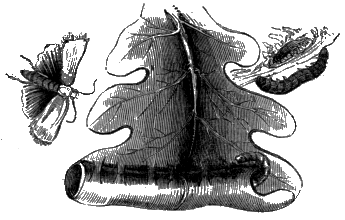

Yet, the Creator, who has wisely appointed a large portion of their numbers for food to many creatures, has also taken many precautions to prevent their being entirely annihilated, as might otherwise have been the case. These are well deserving a brief notice, previous to our passing on to the last stage in the history of the larva. From what has been already said about the coats of various larvæ, it may be imagined that that must be a stout-hearted enemy which could venture to attack some of them. The spines and hard excrescences with which they are furnished must, undoubtedly, prove far from agreeable to the touch of a foe; and there can be no question that this sort of armour is, of itself, a good defence to many larvæ. Others form artificial coverings, which are [180] equally useful, by concealing them from the notice of their enemies. Thus, as we have before remarked, some dwell in tubes of leaves, hid from every eye; others encase themselves in a shield of cemented gravel or shells, like those represented in the cut, presenting a most grotesque appearance; others hide themselves in variously-formed cells. Some, immediately on being touched, roll themselves up, like hedge-hogs, into a ball, which looks like a little globe of hairs, and is so slippery that it cannot be retained between the fingers; others, again, when they are touched, instantly drop down, and from their colour, resembling precisely [181] that of the herbage into which they have fallen, it becomes next to fruitless to search for them.
A very singular larva which, both for offence and defence, adopts a most extraordinary procedure, must be mentioned by itself. This larva is not unfrequently to be found in our houses, and is said to feed upon our disgusting and annoying invaders—the bugs; but it so completely contrives to conceal its real character, that not once in a hundred times would it, probably, be recognised as an insect at all. It collects together a number of particles of sand, or fragments of wool, or silk, or earth, and with singular skill, contrives to form a sort of coat out of these, in which it envelopes itself. Thus attired, as may be imagined, it is not easy to discover what the object really is, and it thus, undoubtedly, escapes the undesirable notice of any of its enemies. But more than this: like those North American Indians, who hunt by concealing themselves in the skins of wolves, and so attract less attention from the herd than they would do if they were to expose themselves in their natural aspect to view, this crafty larva steals upon its prey in much the same [182] manner, although it can run with sufficient swiftness when necessary. It creeps forward with the greatest stealth, moving only one leg at a time, and thus quite insensibly approaches its victim, who is not at all alarmed at what merely appears to be a lump of dust. Soon, however, it is convinced of its fatal mistake, and discovers the terrible fact that it is in the embrace of an unsparing devourer.
Other larvæ escape notice in a singular manner, by their close resemblance to little pieces of stick. Thus, we are told by Messrs. Kirby and Spence, that "there is a certain tribe of caterpillars called surveyors (Geometræ), that will sometimes support themselves, for whole hours, by means of their posterior legs, solely upon their hinder extremity, forming an angle, of various degrees, with the branch on which they are standing, and looking like one of its twigs. The body is kept stiff and immovable, with the separations of the segments scarcely visible; it terminates in a knob, the legs being applied close, so as to resemble a bud at the end of a twig; besides which, it often exhibits intermediate tubercles, which increase the resemblance. Its colour, too, is usually obscure, [183] and similar to that of the bark of a tree: so that, doubtless, the sparrows and other birds are frequently deceived by this manœuvre, and thus balked of their prey. Rösel's gardener, mistaking one of these caterpillars for a dead twig, started back in great alarm, when, upon attempting to break it off, he found it was a living animal."
Some, however, are actually armed, so as to offer an active resistance to the onslaught of any enemy. Mr. Abbot has described a terrible caterpillar, well known in certain districts in America, under the strange title of the "Hickory-horned Devil." This creature is furnished with seven or eight strong horn-like spines, upwards of half an inch in length, which project from its head and anterior segments. When threatened by danger, the caterpillar does not attempt to fly, but lifts up its head menacingly, and shakes it about in a very fierce manner. The negroes, in particular, are so terrified at its aspect, that they dread it as much as the rattlesnake. But, in reality, it is harmless; and Mr. Abbot, in order to convince the ignorant people that such was the case, took hold of it, in their presence, without receiving any injury. This, however, [184] did not convince them, and they made answer that, although it did not sting him, it would undoubtedly sting them.
The weapon of another is thus pleasantly described by De Geer:—"In the month of July, I found a caterpillar resting upon a small twig, which I cut off in order to enable me to examine it more attentively. As I was scrutinizing its appearance, I happened, accidentally, to touch its body. Instantly there shot out, from a spot near the head, two streams of clear fluid, which struck me on the face, and partly entered one of my eyes, causing a very acute, but fortunately, not a very enduring pain. My surprise at this salute prevented my taking particular notice of the place from whence the jets proceeded. It appears probable that this caterpillar has been thus endowed with this squirting apparatus to enable it to defend itself against its enemies, or at least, to assist in frightening, or perhaps in hunting, its prey. For myself, I confess, after the reception I had met with, I felt some degree of fear at too nearly approaching it."
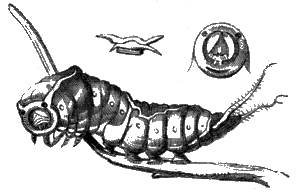
On examining them carefully at another opportunity, this entomologist found that these caterpillars were provided with a squirting apparatus, situated in a cleft in the neck. When the creature is irritated, it thrusts out a curious organ, divided into four branches, and drilled with holes, like the rose of a watering-pot. From this organ shoot the jets of fluid spoken of. After the discharge they are drawn in again, and covered over by the closing up of the cleft. Strange to say, when taken in-doors, the caterpillar lost the power of squirting altogether. It appeared as if it could only do so in the open air, where a number of insect enemies were arrayed against it. This caterpillar is commonly known as that of the Puss-moth, and has sometimes caused the most strange and foolish country tales by its striking appearance. It has been described as a horrible monster, having a head like a lion, jaws like a shark, a horn like a unicorn, and two tremendous stings in its tail! [186] Certainly, its appearance is not the most engaging in the world, as may be conceived from the representation of it in the cut; and what adds to its singularity is, that it possesses the power of lashing its sides with its tail, so as to drive away flies. If the reader should be fortunate enough to find one, he may have some amusement in examining all the curious apparatus with which this rather forbidding looking insect is supplied.
The winter draws near, and sends its foretokening cold breathings to warn every creature, vegetable and animal, that the dark season is arriving, when food is no longer to be obtained. What is to become of the larva? Can it endure the penetrating tooth of frost, or the overwhelming shower of rain? Or can it endure to be from week to week, from month to month, without a mouthful of food? From the facts already stated with reference to the age of larva, it is very certain that many larvæ have to bear these trials; and some, not merely during one, but during several winters. We must, therefore, inquire how they have been defended, or strengthened, so as to enable them so to do.
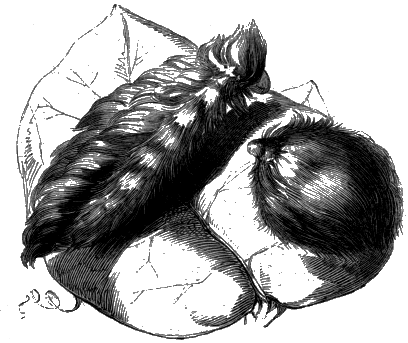 Shaggy-coated Larvæ.
Shaggy-coated Larvæ.
The alteration in the coats of animals during winter, or rather, just previous to it, and the fact that animals destined to inhabit the arctic regions are enveloped in coats of the shaggiest hair, are well known to every person. There can be no doubt, that in many instances in the insect world, where a larva has to be exposed to the frosts of winter, the same provision of a hairy covering, which has been given to them by the Creator, is intended to meet the same end, and to preserve their soft and tender bodies from the destructive influence of extreme cold. The following [188] striking observation of a talented entomologist, who has not thought it beneath him to write a most interesting book only on the family of ants (M. Huber), shows very clearly that such is, in fact, the intention of providing the larva with a covering of this kind. He noticed that the larvæ of some species of ants destined to pass through the winter, were furnished with this kind of warm clothing, while those which were not so destined had smooth coats, that is, even in the same species: thus proving to us, beyond a doubt, that as the winter approached, the warm coat was put on by the larvæ. The engraving on the last page represents some extraordinary specimens of hairiness in caterpillars from Brazil, now in the British Museum.
A large number of larvæ become torpid during winter—they are not dead—they are not sensibly alive—they are plunged in that long half-death which affects not only them but also many large animals, who retire in winter, lie down to sleep for weeks, and awake to find the cold departing, and the spring-time nigh at hand. But the frost sometimes proves too severe for them, and the poor insects become sometimes congealed into solid lumps [189] of ice! Alas! we shall exclaim, then there is an end to their life when that takes place; and, undoubtedly, the severity of such a degree of cold destroys large numbers; yet, strange to say, some larvæ actually revive, even after they have been thus frozen into hard inanimate lumps. One observer states that he has found them in this condition; and so entirely congealed, that they chinked like small stones when dropped into a glass tumbler! yet they revived after careful management. In an experiment made during Sir John Ross's voyage to the arctic regions, upon the larvæ of a moth, they were four successive times exposed to the intense cold of 40° below zero, and four times they revived again on being brought into the warm atmosphere of the cabin. Experiments have also been made by other persons with a like result. It may, therefore, be considered certain that some larvæ will bear to be frozen into solid masses, so that they will snap asunder like an icicle, and yet return to life again; and even go through all their stages of development, into the perfect insect. How remarkable a fact this is, when we remember the deadly effect of frost upon man and the higher animals!
Many larvæ, however, form nests of various kinds, in which they comfortably spend the dreary days and nights of this stern season. "With this view," write the excellent observers, Kirby and Spence, "the larva of Cossus ligniperda forms a covering of pieces of wood, lined with fine silk; those of some other moths excavate, under a stone, a cavity exactly the size of their bodies, to which they give all round a coating of silk; and the larvæ of Pieris Cratægi enclose themselves, in autumn, in cases of the same material, and thus pass the cold season, in small societies of from two to twelve, under a common covering formed of leaves. Bonnet mentions a trait of the cleanliness of these insects, which is almost ludicrous. He observed in one of these nests a sort of sack, containing nothing but grains of excrement; and a friend assured him that he had seen one of these caterpillars partly protrude itself out of the case, the hind feet first, to eject a similar grain; so that it would seem the society have on their establishment a scavenger, whose business it is to sweep the streets, and convey the rejected matters to one grand repository. This, however singular, is rendered not improbable, from the fact that beavers dig, in [191] their habitations, holes solely destined for a like purpose, as do also badgers."
A singular variety of larva-nest is mentioned by a Mexican traveller. He says,—"After having ascended for about an hour, we came to the region of oaks, and other majestically tall trees, the names of which I could not learn. Suspended from their stately branches were innumerable nests, enclosed, apparently, in white paper bags, in the manner of bunches of grapes in England, to preserve them from birds and flies. I had the curiosity to examine one of them, which I found to contain numberless caterpillars. The texture is so strong that it is not easily torn; and the interior contained a quantity of green leaves to support the numerous progeny within."
The larvæ of some Australian insects form the most curious nests we have ever beheld. A representation, taken from specimens in the entomological collection at the British Museum, will show what extraordinary structures these are. They appear like minute bundles of faggots, and have been formed by the insect cutting short pieces of twigs, all nearly of the same size, and then cementing them together in the manner represented. [192] Some of these are of a large size, as large as a moderate-sized pear; others are smaller, and these present the most beautifully regular appearance, consisting of a number of very small rods, bound together in a cylindrical form, like the fasces of the Roman soldiery.
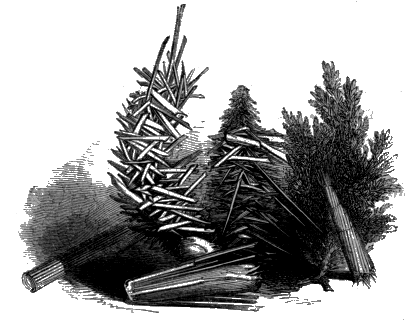 Australian Larva-cases.
Australian Larva-cases.
In this manner larvæ pass through the winter. Without a doubt many perish; but there remain infinite numbers at the end of this season, which, from the depths of their cells, become sensible to the influence of spring, so soon as the first footsteps of that season are felt upon the earth. [193] The larva wakens to active life once more; and with an appetite rendered all the keener by its fast of four or five months, it leaves its dormitory, and begins to consume whatever suitable food may lie in its way; and so it continues, until the time of its change approaches.
PREPARATION FOR A CHANGE.
The last stage of the larva's history hastens on. Its career of activity and voracity is nearly ended, and the insect's days in this form are well nigh spent. Hitherto it has been an earthly, earth-loving being, without either the desire or the power to raise itself into the airy element, in which multitudes of its species are disporting the day long. If we may so speak, its highest desires have only been confined to the quality and quantity of its food; possessing these, it was content. But now, its hours of feasting are come to a close, and it has to make ready for a great and momentous change. The crawling, and, perhaps, repulsive creature which we turn from without regret, has a high destiny to accomplish, when the period of its sojourn in its vile body is fully accomplished; and then, that form which now creeps among the dust of the [195] world, shall mount up as on eagles' wings, and be carried whither it will through the pure regions of the sky.
The age to which the larva generally attains before this change takes place is exceedingly variable. To some it is permitted to reach the venerable age of four or five years; others, three; and many, not nearly so much. The dung and fungus-feeding insects, as if hastened forward by the warmth of their position, are at the end of their larva life in a week; others live a fortnight in this state; and others, several months. We are told of a curious anecdote of a beetle which had existed in a desk, set up in an office in London, for upwards of twenty years, half of which period, according to Messrs. Kirby and Spence, it must have lived as a larva. But this is quite an exception to the general rule.
For some days before, the larva loses its long distinguishing characteristic—its appetite—and now forsakes the plants upon which it formerly fed; or if it does not forsake them, no longer consumes any part of them. It becomes, apparently, in some degree sensible that it is approaching the most dangerous period of the history of [196] the insect—the state of sleep or torpor in which it is to exist as a pupa—of which we shall speak more particularly in our next chapter. Before, although a weak and comparatively a defenceless creature, it was still able to exercise a vigilant watch against its enemies, and thus to avoid them, or to prepare for their reception; but now, its eyes are to be closed in a death-like slumber; its body to hang a tempting bait to any wandering foe, or hungry bird, and it can in no way resist the attacks of the feeblest adversary.
As if fully aware of this, the wonderful instinct of the larva meets the difficulty by teaching it to select the best place for its concealment from a dangerous notice. With this view, it sets out in search of a hiding-place, and rests not until it has obtained a city of refuge which may prove to it a defence against the enemy. It may be some little recess, covered by an irregular stone, and sheltered round the sides by moss and the upspringing grass; or, perhaps, a little hole in the earth has received the poor fugitive from future harm, and in order to conceal itself more completely, it has drawn over the mouth of the cave a covering of leaves. Here, [197] safe from observation, the larva bids a farewell—to speak as the poets speak—to the busy staring world for awhile, and loses all recollection of its past history, in the night of torpidity upon which it has now entered. The larvæ of the lady-bird, and other insects, glue themselves fast to the under side of a twig or leaf, and here pass the days of their sleep in safety. Many of the larvæ of insects whose life, up to this period, has been passed beneath the surface of some glassy pool, now quit the pure element, and seek the shore, on which they are to pass the remaining portion of their existence.
But there are two other ways in which larvæ prepare for the state of pupa, which are so curious, and prevail to such a large extent among insects, that we may be excused for following the example of all authors upon insect history, and treating our readers to the interesting facts which have been recorded by various observers upon this subject. One of these is the plan of hanging themselves up in the air, like sailors in their hammocks; and in other positions, this plan is commonly called the suspension of the larva. The other is the formation of beautiful cases of various kinds, [198] which are called cocoons, in which they wrap themselves up close during the period to be devoted to the pupa state. Let us speak of these each separately; and, first, of the case, or cocoon, as a place of concealment for the larva. It is right, however, to premise, that, while the greater number of insects are in a torpid or half-torpid state while in the pupa form, all are not so, as will be noticed in the next chapter; and those which are not do not of course require the protection of a cocoon, or the contrivance of a silken hammock.
The material of which the case or cocoon is composed is a beautiful silken fibre, which is furnished by a spinning apparatus placed either at the extremity of the body, or more frequently at the mouth of the insect, whence it proceeds in a filament of the utmost delicacy and transparency, but at the same time of considerable tenacity. By its means alone cocoons, of a number of different kinds, some of extraordinary beauty and ingenuity, are constructed; but in other cases the insect has recourse to various materials to assist in giving strength to the walls of its cell.
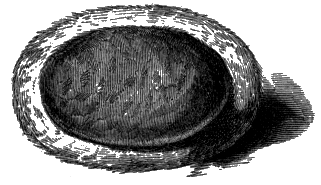 Cocoon of Silk-worm.
Cocoon of Silk-worm.
The best example, and the most familiar one we can select of a purely silken cocoon, is that of those
|
"——spinning worms That in their green shops weave the smooth-haired silk." |
This beautiful and valuable cocoon, when examined externally, appears to be formed in two different ways; for the outer covering is loose and open, while the inner one is compact and close, and so in truth it is, although both coverings are formed of a single thread. The outer has been called the scaffolding, by means of which the inner and more solid covering is constructed. The larva stationing itself between two leaves, or in any other suitable spot, fastens its thread to one of the adjoining surfaces, and then proceeds to draw out the fibre and fasten it in various positions [200] until it has woven around itself an envelope, as it were, of loose gauze. After this has been done it begins to form the closer and more compact structure of the inner envelope, laying on the silk backwards and forwards in a series of zig-zags, until it has laid on several layers, and thus completely shut itself in. The loose outer portion forms what ladies so well know under the title of flos-silk; the inner fibres are the most continuous, admitting of being wound off without breaking, and they form the ordinary silk of commerce.
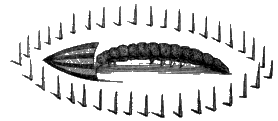 The Larva surrounded by its Palisade.
The Larva surrounded by its Palisade.
M. Lyonnet has given a most interesting account of the proceedings of another larva which far surpasses the silk-worm in the ingenuity of its manner of forming the cocoon. This larva is very small; in fact, not more than the sixth of an inch in length, and is found on the under side of oak-leaves. M. Lyonnet observes, that beyond all the larvæ he had ever watched, he considered this creature the most inconceivably ingenious workman. Its little cocoon is of a white colour, and of a long oval form, having its upper surface ornamented with seven upright ridges. The first thing the creature begins by doing, is to erect, in [201] the most curious manner, a series of little upright palisades of silk at a certain distance from each other, all round its body, so as to form a sort of oval fence, and probably the larva intends them to serve as a sort of hedge to keep off intruders while it is busy at work! After spinning half its case, it turns round, and begins at the opposite end, and thus forms the other half; it then unites it in the middle, and by so doing incloses itself in a very pretty cage of silken net-work, which it subsequently strengthens by adding a firm layer on the inside. The time taken in the construction of this ingenious cocoon is not more than half-an-hour. It is quite impossible to understand how the little being contrives to form the upright ridges on the surface of its cocoon; and as the larva is so minute it is almost hopeless to expect to discover it. Attempts have been made to unravel the difficulty, but not with complete success. When, looking at some magnificent works of man, we are tempted to become inflated with pride, [202] let the remembrance of what this tiny insect can do keep us humble, and direct our admiration rather to Him who is the Author of all wisdom, the Giver of every good and perfect gift.
Upon the leaves of pear trees we may sometimes find a pretty cocoon of very slight and elegant texture, formed of silk, as shown in the cut.
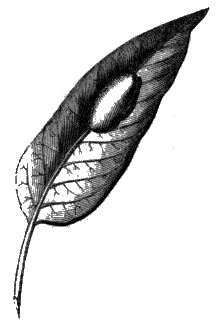 Cocoon on a Pear-leaf.
Cocoon on a Pear-leaf.
A very singular cocoon is spun by the larva of a common moth, somewhat of the outline of a balloon in form. This cocoon is spun in a very slight manner, and thus offers a striking contrast to those of many other insects; in fact, it is so slight, and the meshes are so open, that the insect can be readily seen within suspended in a hammock of silk, and thus presenting a very curious appearance. In another, the inclosed insect looks just like a poor prisoner within a grating.
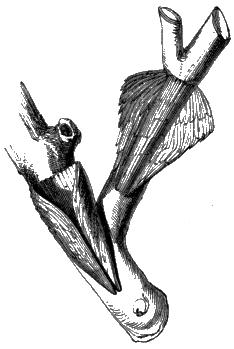 Cases formed of Epidermis of Bark.
Cases formed of Epidermis of Bark.
In order to give a sufficient degree of strength to their cocoons, some larvæ adopt the plan of forming them partly of silken fibre and partly of other materials. Réaumur, being on an entomological excursion in the forest of Vincennes on a fine day in the month of May, fell in with a most curious cocoon, formed by a larva which feeds upon the oak-tree. At first he could scarcely conceive what the object he saw before him was, but on removing the branch it proved to be a very singular cocoon. Detaching a small branch, on which was a larva just commencing its cocoon, Réaumur, finding the evening draw on, set out on his return home. The larva did not seem to discover the fact of its being carried away a prisoner; and as the entomologist carried the branch with gentleness, it proceeded with its task as comfortably as if stationed on the tree it was now leaving behind. Réaumur beguiled the tedium of the way by carefully watching its mode of proceeding in the formation of its cocoon. He thus noticed the larva cutting very delicate layers of the fine upper skin or epidermis of the bark of the twig, which it fastened together by silken cords, and then formed into two wing-like pieces fastened on each side of [204] the twig in the manner represented in the cut, something like the feathers of an arrow in appearance. And now, this being done, the difficulty was to draw the two sides together, and so to convert them into a covering for its body. The manner in which this was done will hardly, perhaps, be imagined. It will be best understood if the reader will cut out two pieces of paper of the shape of these two side portions, fasten them on with a little glue by one of their edges to a piece of twig, and then, by a fine needle and thread, draw them together by stitching from side to side all the way up. The larva does something very like this, for it fixes silk cords to each of the outer edges, and then pulls and hauls with all its might until it has forcibly bent over the layers until they meet, and then it ties the edges together by short [205] cords, so as to produce a seam so beautifully close, even, and fine, as would put the "fine-drawing" of the most superlative tailor to shame; in fact, the join is frequently quite imperceptible. Having done this, it lines the inside with beautiful tapestry of silk. By the time Réaumur and his friends had got to the end of their walk, which occupied an hour and a little more, the larva had, after vast labour, joined together its seams, and far advanced toward the completion of its task.
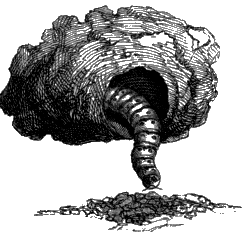
Réaumur made also some most interesting observations upon a larva which constructs its cocoon of a sort of silken mesh, the interstices of which are filled with grains of earth. Having broken off the top of a cocoon he witnessed the singular spectacle of the larva proceeding to mend it again. Without leaving its cell, the patient labourer put its head out of the opening in the attitude represented in the cut, and, after looking about for a [206] little time, picked up, one by one, a number of grains of earth, which it stored up in its case. After this, it filled up the sides of the opening with a net-work of silk, working the grains of earth into it as it proceeded. For three hours the larva worked incessantly at its task, and at the end of that time had materially reduced the size of the opening. Réaumur was now curious to observe how the opening still left would be filled up, as the insect could no longer put its head out, and he expected to see it filled up with a mesh of silk. But he had not given the larva due credit for ingenuity in making this supposition. It filled up the opening first, with a mesh of silk, but between the meshes, in a most curious manner, it thrust out some little grains of earth, which it had previously stored up, until they actually appeared on the outside, and any one would have supposed they had been laid on from without. It finally ended its labours by coating the inside of the opening also with a layer of earth. Réaumur afterwards cut the cocoon in half with a knife, and by that means was enabled to see how successfully the larva had repaired the injury.
We must now speak briefly of the Suspension [207] of the Larva; and it may be mentioned, that the insects, whose larvæ perform this manœuvre, are almost exclusively the butterfly tribe. There are various ways of effecting this object. The spinning apparatus, by which the cords are to be formed to sustain the body of the insect in the air, is situated in the mouth of the larva, and it may well be imagined that the insect, which is about to hang itself up by the tail, has no easy task to perform in having to fasten its cords to the tail, and then to the branch above it. If a spider wished to hang itself up by the tail it would be a very easy thing so to do, for the spinning apparatus is placed there, and it has only to let itself fall from a branch after first glueing the end of the cord to it; but a larva is differently circumstanced, and it requires no slight display of ingenuity to accomplish its purpose.
Its first process is to select a suitable leaf or twig, upon which it weaves a sort of little mound of silk of the shape of a button. This done, it examines it carefully to ascertain its strength, and satisfied therewith, it then proceeds to thrust its two hind legs in amongst the threads of which the button is composed, and in so doing it causes [208] the hook-like processes which fringe these legs to become securely entangled in them. It then is safe as to the issue, and now lets its body drop down, fearless of the most violent rockings to which even a tempest might expose it.
Another way of suspending themselves is almost equally singular with this. It may be witnessed by the reader if he will take the pains to collect the larvæ of the common white butterfly, found in abundance upon our cabbage rows; and by properly attending to, feeding and watching them, this curious proceeding may generally be observed, in a few at least of the number, supposing that the others may have hung themselves up without being seen in the very act. If we were to set a mountebank to the task this larva has to perform, it may well be doubted whether with the richest reward before him he could manage to effect it. First, he would have to tie both his feet fast to a branch, so that he would swing head downwards; then, in order to hang himself in the horizontal posture, he must bend his body up, fasten a cord round the branch in a proper place, so as to form a loop, and then put his head and body into it, so that it would support him comfortably just under [209] the arms. Probably the most supple-jointed gentleman would find himself discomfited in the attempt. The caterpillar in question, however, does all this, and more; for it has to spin the ropes with which it is to be suspended. Fixing its hinder part, in the manner just described, to the little button of silk, which it first forms, it then spins the girth, in which it intends to trust its safety, by the apparatus of the mouth. Sometimes larvæ tie themselves in an upright position, as martyrs to a post; but the most common method is the horizontal one, giving the insect the resemblance of a sailor swinging in his hammock.
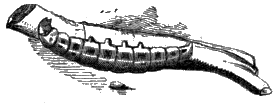 Horizontal Suspension.
Horizontal Suspension.
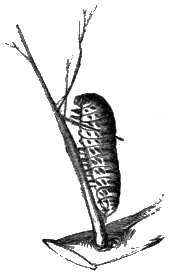 Perpendicular Suspension.
Perpendicular Suspension.
We must ask attention, before we close our chapter, to one more account of the proceedings of a larva; and this too is in a common insect—perhaps the housewife would say a little too common—the [210] meat-fly. This larva, when its days in that condition are at their close, quits its long greedily-devoured and disgusting food, and penetrates into the earth; there it contracts its body in a singular manner, and its skin becomes thickened and hard, so as to form a sort of parchment-like case, inside which its jaws are cast off, instead of outside, as is commonly the rule. "Were such an extraordinary transformation as this to happen to one of the larger animals, it would be held forth as altogether miraculous," writes Mr. Rennie. "Were a lion or an elephant, for example, to coil itself up into a ball, compressing its skin into twice the thickness and half the extent, while it remained uniform in shape and without joinings or openings: and at the same time were it entirely to separate its whole body from this skin, lie within it, as a kernel does in a nut, or a chick in an egg, throwing off its now useless tusks into a corner; and then, after a space, should it acquire wings, break through its envelope, and take its flight through the air, there would be no bounds to our admiration. Yet the very same circumstances in miniature take place every day during summer, almost under the eye of every [211] individual, in the case of a blow-fly, without attracting the attention of one person in a million." So much more are we attracted by great things than by small.
The work of preparation finished, the insect securely buried in its cell or warmly surrounded by its cocoon, or hanging up to the branch of a tree, or in any other way concealed from view or protected from injury, little more remains to be added to the larva history. Its last action, after settling itself in a comfortable position, is to cast off its skin, which is generally, in the case of those larvæ which inhabit cells or cocoons, left inside the recess: sometimes it is cast out. The period at which the insect ceases to belong to the larva stage, and passes into the next, varies, and will receive notice in the following chapter.
When in the vengeance of God upon the guilty land of Egypt it pleased Him to send the plague of insects, the exclamation of the magicians was: This is the finger of God." Such, in an admiring sense, may be ours also as we look back upon what we perceive God to have done for this humble portion of His creation in the few past pages. What provision, what wonderful forethought and [212] wisdom has not been exercised upon beings which man despises, or even abhors, and which fall daily by thousands under foot, crushed and forgotten except by a few. Let us search the green lanes and hedge-rows more assiduously,—let us poke even into the dirtiest corners,—let us examine well the leaves and branches in our gardens, the depths of the purling brook, the cavities of the aged trunks, and the cracks in the deep-furrowed bark,—let us look narrowly upon the cabbages and nettles, as well as upon the rose-bush and myrtle,—let no place, in a word, be beneath our scrutiny, no object beneath our notice;—let us do this, and we shall not need to sigh after foreign scenes, or the majestic wonders of nature, for we shall have a microcosm, a world of wonders, in a table drawer, and an exhaustless theme of admiration in the contents of a tumbler of water.
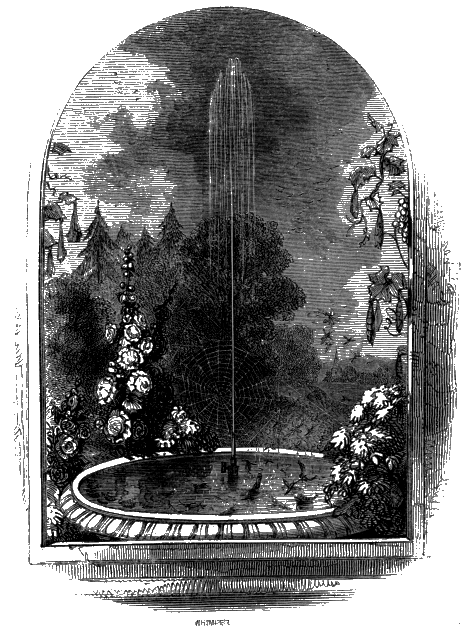 INSECTS ESCAPING FROM THE PUPA CONDITION.
INSECTS ESCAPING FROM THE PUPA CONDITION.THE TRANSFORMATION.
Hanging to the slender branch of yonder rose-tree, swinging to and fro with the gentle air which blows in scented waves through the flower-garden, is a little object to which we wish to direct attention. Had not notice been thus directed to it, in all probability we should have passed it by, if we observed it at all, only considering it to be a broken twig or withered leaf suspended by a cob-web. We may examine it minutely, but all is quiet and motionless in the little mass, and it is impossible to detect the least sign of life. A casual eye would rest upon it without interest, and would turn away from it uninstructed as to its nature and properties. In colour it has nothing to attract—it [216] is of a dirty white or brown, and in shape it is, though curious, so small, and so uninviting, that few would take the trouble to pay much attention to it. Day by day it swings from its silken cord, and is to all appearance an object without interest to all around it.
Yet this slumbering, unattractive mass contains a living being. Though the aspect of death has passed upon it, and though we may perhaps be unable to detect the symptoms of movement in its parts, it is yet alive, and the lapse of a little time will convert the slumbering being, thus singularly hung up to be the sport of the wind and rain, into a creature more extraordinarily active than perhaps any other in the animal creation. While it sleeps, great changes are taking place; it is receiving new organs, it is being matured, developed, perfected, fitted for a nobler existence, and for a higher range of duties, than it has yet known. Such is the pupa.
From these remarks it will be sufficiently evident that this chapter of our insect history has to speak of a period when there are but few traces of active existence in the insect, and it might therefore be supposed there remained little to be [217] said upon a period of the insect's life which is only comparable to a prolonged sleep. But entomological science is too rich in interesting matters upon every subject to admit this conclusion, and we shall find that there is much to be narrated which equally, with what has formerly been written, is calculated to raise our admiration to the Great and Beneficent Author of all Nature.
If we turn to a Latin Dictionary and hunt out the word which stands at the head of this chapter, Pupa, we shall find several definitions of it given; for example, a little girl, a doll, and a baby. What have either of these to do with an insect? some will exclaim, and they may feel disposed to consider the great Linnæus, who gave the insect tribes while in this stage this title, to have been not over happy in his selection of terms. But those who thus exclaim have perhaps only seen babies as they are clothed in England, possessing the power and comfort of free movement, and having their arms and legs at liberty. Between the aspect of these little creatures and our insects no one can trace any resemblance. But it is very different on the continent; there, out of the strange notion that it will keep the poor little [218] being's limbs straight, it is the custom to wrap babies up in swaddling clothes, until they can neither stir hand nor foot, and they are made to resemble Egyptian mummies as nearly as possible. Babies wrapped up in this cruel and barbarous manner form objects of so peculiar an appearance, that it is quite ludicrous to trace the resemblance between them and the pupæ of insects; and therefore Linnæus, as it appears, could scarcely have selected a better epithet for the insect than its present title of pupa, as it too has the aspect of being wrapped up in swaddling bands.
 A Pupa.
A Pupa.
But, as we formerly mentioned with regard to larvæ, all insects in the pupa state are not called popularly by their scientific and correct name. Those that are closely wrapped up, and are in fact complete mummy insects, are called sometimes by the term Chrysalis, or Aurelia, because they are sometimes of a golden lustre, the one being derived from the Latin, the other from the Greek term for "gold," and this even when they are not gilded in this manner. Again, when, as we shall presently have to notice, the insect in the pupa state [219] is still capable of eating or moving, or when it does not lose its legs, its popular name is a Nymph. As in the preceding chapter, so in this, we shall not regard these terms, as they only create a great amount of confusion, but shall adopt the true term, pupa, throughout, whether the insect spoken of falls within the one or other of these popular divisions, or not.
We traced the larva in the last chapter up to that period in its history when it enters its cell, or otherwise retires to concealment, previous to its becoming transformed into the pupa. Here, immured in darkness, and alone, it is left to undergo that mysterious struggle of the vital powers which is to end in producing a new and more perfect creature out of one which, however perfectly adapted to its condition, is very far inferior, as regards the completion of its organization, to that which it is destined to become; and here we may appropriately pause to take up the history of the curious larva so recently described, at p. 207, as performing the feat of hanging itself up by the tail from cords spun by its mouth; since it exhibits to us in a striking point of view the shaking off of the old form of larva, and the putting on of the [220] new one of pupa. In addition to this, it is, perhaps, one of the most astonishing instances of animal agility with which we are acquainted.
In order to make its manœuvres and the difficulty of them the more easily comprehended, let us (to follow Messrs. Kirby and Spence in the same matter) put a case of a somewhat similar kind before the readers by way of supposition. Country fellows at wakes and fairs frequently—for the diversion of the company there assembled, or for a prize of some value in their estimation, perhaps a fat pig, or a leg of mutton—run races in sacks which are tied close about their necks, and of course tumble about a good deal, and display anything but a graceful mode of progression. "Now," say these authors, "take one of the most active and adroit of these, bind him hand and foot, suspend him by the bottom of his sack, with his head downwards, to the branch of a lofty tree; make an opening in one side of the sack, and set him to extricate himself from it, to detach it from its hold, and suspend himself by his feet in its place. Though endowed with the suppleness of an Indian juggler, and promised his sack full of gold for a reward, you would set him an absolute [221] impossibility; yet this is what our caterpillars, instructed by a Beneficent Creator, easily perform!"
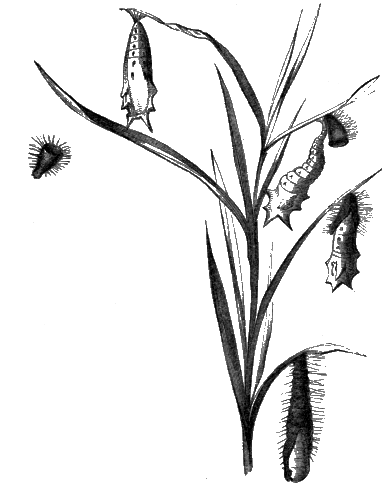 This Cut shows the entire change from the first rupture of the skin to the casting
away of the old skin.
This Cut shows the entire change from the first rupture of the skin to the casting
away of the old skin.
 Tail of a Pupa magnified to show the
toothed parts.
Tail of a Pupa magnified to show the
toothed parts.
Let us proceed to show in what manner the caterpillar performs this wondrous feat. After suspending itself in the way already described, a little time generally elapses, during which the insect by turns contracts itself, and then dilates again. At length its skin splits near its head, and a portion of the pupa appears, which acts like a wedge, and, being thrust partly through the slit, causes it to tear still higher and higher towards the tail. The insect continues its painful labours, swelling and contracting alternately, so as to push the torn skin higher and higher up, as one would roll off a stocking, until at length the old skin is folded into several rolls, and is quite at the tail. But the task is as yet only half accomplished; the most arduous and difficult part remains to be done. The pupa is shorter than the larva, and consequently hangs out of reach of the silken button in which the latter was firmly fixed by its hind legs. It seems now as if the poor insect must fall, for there appears no way for it to get up to the silk anchorage, and the folds of the pushed-up old skin are all that retain it in its position, which, [222] as may be imagined, is far from a secure kind of fastening. How is it to disengage itself from its case, and be suspended in the air while it climbs up to take its place? Without arms or legs to support itself, the anxious spectator expects to see it fall to the earth. His fears, however, are groundless; the supple segments of the pupa's abdomen serve in the place of arms. Between two of these, as with a pair of pincers, it seizes on a portion of the skin; and, bending its body once more, entirely extricates its tail from it. It is now wholly out of the skin, against one side of which it is supported, but yet at some distance from the leaf; the next step it must take is, to climb up to the required height. For this purpose it repeats the same ingenious manœuvre: making its cast skin serve as a sort of ladder, it successively, with its different segments, seizes a higher and a higher portion, until in the end it reaches the summit, where with its tail it feels for the silken threads that are to support it. The tail is provided with a number of minute hooks which catch in the meshes of the silken button, and the pupa, thrusting it into the meshes of this button, feels quite secure as to the result, and drops safely into the perpendicular position, dangling in the air as gaily as did the larva before it. But its old skin still clings to it, and seems greatly to annoy it by its presence; so much so, that it sets about attempting to cast it down altogether. As it will be remembered that the legs of this skin are still firmly attached to the silk, in consequence of their hook-like form, it will be evident, that this also is a task of some arduousness. In order to get rid of it, it jerks itself about in various directions, and spins round very rapidly,—doubtless the reader has often seen the insect in this act, and has wondered what was its object in whirling round after this manner,—by this means at length the cast-skin appears loosed from its hold and drops off. The whole proceeding from first to last is represented in our engraving. The little hooks of the tail of the pupa are represented in the adjoining cut much enlarged. Well does Réaumur exclaim,—"These manœuvres of withdrawing its tail from the old skin, of climbing up the old skin, and of hooking its tail in the silken button,"—and, as we might add, of whirling itself, and in other ways agitating itself to get rid of its old skin,—"are manœuvres so delicate and perilous, that we cannot help wondering how an insect which only executes them [223] once in its life, should execute them so well; and we are led to the inevitable conclusion that it has been thus taught by a Great and All-wise Master."
The manner in which other larvæ cast their skins and become pupæ when they enter their cell cannot be described, as they perform this act in all the privacy and darkness of their solitary habitations; but in all probability it differs in no respect from the manner in which the same creatures cast their skins when they moult, excepting that the new being which emerges from the cast-skin is no longer a larva, but a pupa.
The time occupied by the creature in its process of change differs in different species. In some it is short, in others it is long. Generally, it does not exceed a few days. We are told, however, of the larva of some insects which are six months before they become pupæ. The Baron de Geer tells us with surprise of the larva of a moth which he had watched. It became a larva, and spun its cocoon, in the month of August, 1746, and was attentively kept during the winter. The spring came, but the larva still remained a larva, and did not show any signs of changing its form; [224] and winter came again, finding it still a larva: the second winter passed, and it was not until April 1748, that is, more than eighteen months after it first became a larva, and entered its cocoon, that it underwent the change, and became a pupa: some time afterwards it became a perfect insect.
WHAT IS A PUPA?
But it may now be asked, What is a pupa, and what are the differences between it and a larva, and between it and the perfect insect? It is very necessary that this should be clearly understood; and to that end we shall endeavour to render our explanation as simple as possible. But it will be far better than the best description, if the reader will be persuaded to watch these changes throughout himself. The butterfly tribe furnish the very best illustrations in the world; and by merely collecting a few caterpillars from the way-side, or from the kitchen-garden, a source of amusement will be opened which will a thousand-fold repay the trouble and time consumed in the occupation. Of all other ways, personal observation, when it is so readily to be effected as in the case of these insects, is the best and most impressive method of [226] becoming acquainted with the "Life of an Insect." Such knowledge is far more entertaining than book-knowledge, and is much more agreeable to acquire, and more easy to retain.
We must guard our definition of what a pupa is, by reminding the reader that some insects with which he is very familiar do not pass through this change in the same manner that the majority of insects do; that is, in a state of torpor or sleep. If he were to rear up a spider from the egg, and were to watch for the time when it would become a still, lifeless-looking object, like that which we have called a pupa, he would assuredly be disappointed, and he might accuse this little work of leading him into error, because it declares that all insects must pass through the pupa state before they become perfect in their form and number of their parts. Yet that very spider has passed through both the larva and the pupa state under the observer's eye without his being able to recognise the fact, simply because in both these states it is very like the perfect insect, and can walk about and eat just as usual. In fact, it is more than probable that spiders of the same kind in these different conditions could scarcely be recognised [227] so as to say that they were pupæ, or perfect insects, even by tolerable entomologists; and it is very likely that mistakes of this kind have often occurred.[I] We learn, therefore, from this statement, that some pupæ are active, and move about just as they did before, although they are in the pupa state.
In a great number of cases, then, a pupa is a state in an insect's life when it rests from active exertion, and from taking food, and when, underneath the dry and withered skin, a series of great changes are taking place, which are preparing it for its future life in the perfect state. Thus it differs from the larva state in not eating and moving, and in the important particular,—that it is receiving new parts and organs, which are added to it under the skin. It also differs from the perfect insect in the same respects as in the first place from the larva, and also in the important circumstance, that the perfect insect the moment it enters that state, has no more organs added to it—it is, in fact, perfect, while the pupa is imperfect. Let us place these differences in a tabular form:—
The Larva Moves about and eats. Has no new organs added to it beyond those acquired in the egg. |
The Pupa Does not move about nor eat. Has several new organs added to it, to prepare it for the perfect state. |
The Perfect Insect Moves about and eats. Has no new organs added to it, beyond those obtained in the pupa state. |
Let us repeat our caution, that this definition is only applicable to inactive pupæ. In the active pupæ the same development of new organs takes place, but it does not interfere with the usual actions of life. We must also add, that some of the pupæ which we must call inactive, nevertheless are not wholly without motion, but are capable of manifesting that life is in them, death-like though they appear, by slightly moving the lower part of the body.[J] All inactive pupæ, however, are without the power of moving about.
At the risk of being thought tedious, it has been indispensably necessary to be thus precise upon this point; a little careful study of these two or three pages will fix the distinctive characters of [229] the pupa firmly in the reader's memory, and will enable him to find the account given of its history clear, easy, and interesting.
Having thus defined what the pupa state is, let us take up one of these withered objects, and by a little gentle treatment, with the assistance of a delicate scissors, a sharp pointed penknife of very keen edge, and two or three pins, we shall succeed in unrolling the insect mummy. In order to obtain the best sight of what the pupa case contains, it will be advisable to select as large a pupa as can be procured. Those of the butterfly tribe are well suited for this purpose. If we are pretty fortunate in our dissections, we shall succeed in discovering, that within the membrane-like skin there is exhibited a beautiful spectacle of order and neatness. The legs, and wings, and other external appendages, are folded down close to the body of the insect. The feet are often crossed smoothly over the breast, and the wings are flattened against the side of the body; the antennæ are also neatly arranged parallel with the legs; and altogether the insect presents a very singular appearance, from the fact of all its organs being thus smoothed down, compressed into the smallest [230] compass, and enveloped by the external skin. The mummy appearance is very striking in some pupæ, as in the specimen figured. The appearance of the folded limbs is indistinctly exhibited in the companion pupa. All the parts of the perfect insect can be distinctly traced, if the pupa is sufficiently matured.
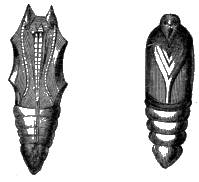 Pupæ.
Pupæ.
By gently using a fine needle, the wings, antennæ, and legs, can be separated from the side of the body, and made to exhibit somewhat of their natural appearance; but as yet every part is widely different from the corresponding parts in the perfect being. The legs are shapeless, the antennæ are imperfect, and the wings,—those glorious organs of the complete condition,—are as yet devoid of their splendid tints, being of a greyish colour, and exhibiting little resemblance to the elegant form afterwards to distinguish them.
Strange to say, every organ in this pupa is enclosed in a sheath of membrane. The head of the insect is covered by a case; the delicate [231] antennæ, however long or fine, have their cases, or sheaths; even the eyes are provided with them. They exist also upon the trunk, wings, and legs, and tongue, or proboscis. These cases must not be mistaken for the general outer case which covers the whole insect; they are separate from that, and cover the organs in question closely, after the manner of a glove.
If we were to open a pupa within a few hours after it had assumed this state, we should find its interior filled with a milky fluid, in the midst of which its future limbs and organs are seen very distinctly, but are as yet in a most fragile, or even half fluid state. At a little later period this fluid disappears, and hardens into a sort of glue, which partly fastens down the tender limbs into their proper position until the appointed time comes for the insect to burst from its sleep and live, and from which the case which covers them is formed. From the account thus given of the contents of the pupa-case, it will be apparent that the pupa possesses, when perfect, all the organs of the complete insect, head, eyes, antennæ, wings, legs, &c., and is in fact only different from it in that it is still inactive to a great extent, and still a prisoner within its cell of membrane. [232] In a little while the bonds which keep it in the tomb will be broken, and the slumberer shall rise a glorious creature to the enjoyment of all the happiness of a new condition of existence.

Perhaps few things would cause a person ignorant of insect life more amazement than if we were to hold before his eyes some of the varieties of pupæ in one hand, and the perfect insect in the other, and were then seriously to assure him that both were the same creatures in reality. "Can it be possible?" he might exclaim. "This dry, brown little mass, with these singular knobs, and this elegant insect with its gaudy wings and delicate figure—these the same being!" Nor when we look at the various figures of pupæ, should we be much surprised at his exclamation. In one of the cases at the British Museum is a very large pupa which we have had engraved, and which is here presented to the reader. In this curious creature the folding up of the limbs [233] is very obvious; and some idea of its strange aspect may be formed from the representation of it here given. The pupæ of several moths are very singular in shape. In some there is a sort of little hook, which sticks out from the head, and seems as if it were intended to hang up the creature by. In others there is a kind of nose attached to the head, giving it a droll appearance. The cause of these protuberances is the long tongue of these moths, which, as it is much longer than their bodies, could not of course be contained in the pupa case, unless it was folded up; it is, therefore, neatly folded up and packed into these receptacles, where it is stowed away until, by the insect awakening to active life, this singular instrument becomes necessary to them, when it is withdrawn. The older naturalists, who loved to find out mimicries of all kinds in nature, used to be fond of painting pupæ with human faces, on account of the frequent resemblance to a Roman nose which is found among them. Goedart, a celebrated naturalist, has drawn several, which we are sure will excite the merriment of our readers, and we have therefore shown these remarkable creatures as represented by him in the adjoining cut. [234] One is a respectable-looking old gentleman's face, with his hair brushed up very primly off his forehead. Another resembles a mermaid, for it has the head of a lady, and something like a cap, but its tail is more like that of a fish. The others are quite caricatures. It is the introduction of a dot, to represent the eye, which gives the resemblance to the face in these figures; without it they are by no means strikingly like the face. Madame Merian has favoured us also with some very curious [235] drawings of pupæ of the insects of Surinam, which appear more natural than those of the last author, and present a very fantastic aspect, by reason of the curious projections which stick out from their heads. A few of these are represented below.
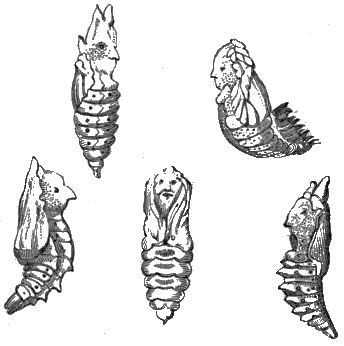 Pupæ after Goedart.
Pupæ after Goedart.
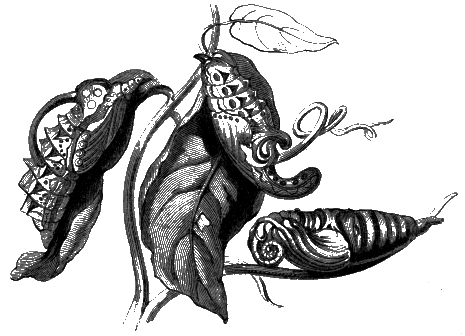 Curious Pupæ. From Madame Merian's work on the Insects of Surinam.
Curious Pupæ. From Madame Merian's work on the Insects of Surinam.
As in the case of the larva, so with the pupa; if it is found in a dark situation, it will probably be destitute of colour, or, at any rate, it will only be of a yellowish white: such pupæ, when taken out of their natural hiding-place, and exposed to the sunlight, become of a dark colour. Indeed the [236] majority of pupæ are without any of the gay colouring which distinguishes the previous condition of the insect. It seems as if it had been thought unnecessary to deck in gorgeous raiment the cerements of what we might call "the tomb" of the insect. But there are some beautiful exceptions to this rule. The pupæ of most butterflies, which are suspended in open day, are of a green or yellowish brown colour. Some, however, are painted in fairer colours; and a still greater number are speckled with glittering spots of golden hue, and shine as though gilded with the purest leaves of that precious metal, and burnished. Hence, as before explained, the Latin and Greek terms of aurelia and chrysalis for the pupæ of these insects. The gilding makes them very attractive objects, being applied now in streaks, now in spots, and occasionally,—and this in the very common pupa of the butterfly whose caterpillar, or larva, feeds on the nettle,—they are entirely covered with this splendid coat. The shade of gilding ranges in the depth of its tone from a very pale yellow to the full lustre of virgin gold. No wonder that those who mistook the object of chemistry, in trying to turn all things into gold, were attracted by these [237] glittering things, and actually believed these spots to be of real gold, and hence imagined that they had found out an argument in nature for the transmutation of common metals into that coveted one. But a little experiment, which it is in the power of any one to perform, would soon have undeceived them, and taught them the truth of the proverb, "All is not gold that glitters." By infusing a portion of saffron in hot water, and straining it off after a little time, and adding to the rich yellow liquor thus obtained a few lumps of pure gum Arabic, a sort of gilding varnish will be obtained, which, if applied to a bright shilling, will give it very much of a golden appearance, owing to the shining of the metal showing through a transparent film of a golden colour. The gilded look of the pupa was found by Réaumur to be produced in the same way by the shining white membrane of the inner skin showing through the outer skin, which is of a transparent yellow.
In the Transactions of the Linnæan Society for 1833, the Rev. L. Guilding describes a very curious pupa, the case of which resembles pearl. These little bodies are found in abundance in the island of Antigua, and are often sent home [238] to Europe, under the name of "ground-pearl," as distinguished from the ordinary fishery-pearl. They are devoured by turkeys, and fowls, until the birds are nearly choked with them, when the remedy is to pour vinegar down the throat, which dissolves the pearls, and sets the poor bird at ease. They are strung into necklaces and purses by the ladies of the Bahamas. They long caused much perplexity to naturalists; but they were ultimately found to be really only the pupæ of a little insect which appears to infest the ants, those voracious creatures, and thus to keep down their numbers. A representation of the ground-pearl, and the insect within, is annexed.
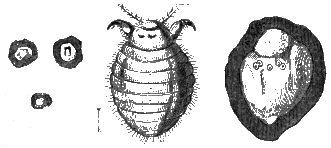 Ground Pearl. The Insect and its Case magnified.
Ground Pearl. The Insect and its Case magnified.
RESPIRATION OF THE PUPA.
Having glanced at these particulars in the history of the pupa, we come to the important question,—Does the pupa, in this torpid condition, still breathe, as the larva did, or not? On a careful examination we might detect, with the help of a magnifying glass, the same breathing holes or spiracles, spoken of on page 161, as appertaining to the larva; and were we sufficiently skilful to dissect the pupa, we should find much the same arrangement of air-tubes within the body. In the absence of all other means of ascertaining the fact, we should be warranted in concluding from the presence of these organs alone, that the pupa has the faculty of breathing, no less than the larva. M. Réaumur has given a beautiful description of the breathing-holes, or spiracles, of the pupa, and has represented them in an engraving, [240] of which a copy is furnished at page 161. He found that they are protected by little valve-like contrivances, just as our mouths are protected by our lips; and these can be opened or closed at pleasure by the creature; so that if plunged into water, that fluid cannot enter the insect's body, for all its little doors—and there are no fewer than eighteen of them!—are fast shut. Singular to say, however, if plunged into oil, the oil has the power of entering them, and the pupæ may be thus drowned.
It is very easy to put the fact of the breathing of the pupa, inanimate as it appears, to a certain test. By taking a wine-glass half full of water, and putting it under an air-pump, and then exhausting the air, we shall be able to extract the air which exists dissolved in the water: or some water that has been boiled and allowed to cool will do as well. If we now put a pupa into this water, and again exhaust the air from the receiver, we shall notice, at the second stroke of the piston, a number of little jets of air come from the insect's body at the places where the spiracles are situated, thus clearly proving that the creature breathes air by this apparatus. The fact may be tested also [241] in another way—and both this and the preceding experiment are due to the ingenious Réaumur. He took the pupa of a butterfly, and suspending it by a thread immersed it half way down in oil; on taking it out after some time it was still alive and apparently uninjured, the reason being, that the entire number of its breathing-holes were not covered. He took another of the same species, and plunged it entirely under the oil, and taking it out after a time it was found to be quite dead; in fact it had been suffocated by the air being shut out from its breathing apparatus, and that as effectually as if it had been one of ourselves lying at the bottom of the sea. We may say, therefore, with perfect accuracy, that though the pupa, this seemingly un-living object, neither moves nor eats, nor in any other way gives us a sign that it is alive, except in a few cases, and that in its advanced stages, we can, nevertheless, prove it to be living; as it can be shown that it has the power of breathing; and if it breathes, it lives.
We may take the liberty of appropriately appending to this statement a most interesting and delightfully-told anecdote, from the pages of the Baron de Geer, of an insect whose larva lives in [242] the water, but whose pupa is an air-breathing creature, and consequently would perish if the change from larva to pupa were to take place under water, without some especial contrivance to furnish it in the pupa form with a supply of air. Yet how can this be, when the insect is under water the whole time up to its becoming a perfect moth? We shall hear:—
"At the commencement of spring, as soon as the frost and ice had disappeared, I sauntered out one day to procure some fresh plants from the bottom of a stream, in order to feed some of my caterpillars with them. Between the leaves of these aquatic plants I presently found a large number of aquatic larvæ, which had there safely passed through the rigorous season just gone by. I took a number of them, and put them in some boxes, where they eat the leaves with which I fed them. There they grew larger from day to day, although by slow degrees. I tended them until June in the same year without perceiving any other change in their appearance than that they had grown to a considerable size. But at the commencement of this month I noticed that they became very uneasy; they forsook their leaves, [243] and wandered about the sides of the boxes, which contained water. Sometimes they would creep out of the water, and again would go into it. They seemed as if they were in search of something which they had lost. It was now evident that their object was to find some convenient place in which to undergo their transformation into pupæ, but they did not like the boxes in which they were confined, and several even died. I began to despair of seeing their metamorphosis; which gave me much regret, as I had a great desire to become acquainted with their whole history. In order to satisfy myself, I went on the 26th of June to the spot from whence I had taken them, in order to discover, perchance, some larvæ about to become pupæ, and to ascertain the places they selected in which to undergo their change. I had the gratification of being completely successful, and of discovering not only the larvæ, but even several of them which had shut themselves up in silken cocoons, and had not yet undergone their transformation.
"The month of June appears, therefore, to be the period when these larvæ prepare for their change of form. They do not leave the water to [244] accomplish it, the change taking place under water. They attach themselves to the leaves of some of the younger aquatic plants, which are at a suitable depth from the surface of the water. By means of several silken cords the insect fastens together two, and sometimes even three leaves, between which it spins an oval cocoon, composed of very white silk. This cocoon is of a double structure; the true inner cocoon, which is very white, is placed within an outer envelope of silk, of a greyish or brownish colour. The envelope extends considerably beyond the sides of the true cocoon (which lies loosely in it); and towards one end there is a wide opening in it, the inner cocoon being perfectly closed in on every side." The cut on the next page represents the perfect insect and the pupa thus carefully provided for.
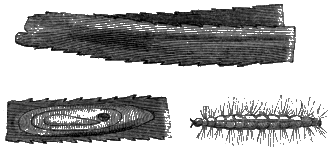 The Cut represents two leaves, between which the Worm lies, the Cocoon itself, and the Larva.
The Cut represents two leaves, between which the Worm lies, the Cocoon itself, and the Larva.
In this inner cocoon there is not so much as a single drop of water! The pupa could not exist in it if it were not full of air; and the difficulty is how to fill a little cell with air which is already buried many inches under, and on every side surrounded by, water. De Geer states that he did not find a particle of water in all the cocoons which he opened. In order to ascertain whether or not it was really necessary for the pupa to be thus carefully housed in a silken ball full of air beneath the water, he took out several pupæ and put them into some water in a saucer. At first they swam, but presently they sank to the bottom. They lived for several days, but ultimately every one died, showing plainly that the air-cell was absolutely necessary to their existence.
 Pupa and perfect Insect.
Pupa and perfect Insect.
Yet, although these pupæ were air-breathing creatures, strange to say, De Geer found that if taken from their little cells out of the water, they shrivelled up and died. He put several in a dry box, and invariably found that in a short time they [246] were dead. He imagined, with great probability, that the cause of their death was the evaporation of their fluids, which of course does not take place when they are enshrouded in their cocoons, and surrounded on all sides with water. He made one more experiment with them, which was as follows:—He took several out of their cocoons, and placed them in water in such a manner, that one of their sides was in the air, while the other was in the water; he kept them for a considerable time in this position, and he had the pleasure at its expiration of seeing them become perfect insects, just as if they had never left their cocoons. The necessity of both air and water to their well-being was thus clearly proved.
How can we sufficiently admire the ingenuity and skill displayed by this insect in the execution of its difficult task! When a human engineer wishes to build under the water, he must have recourse to the most cumbrous and powerful mechanism to enable him to effect his object. Piles must be driven into the bed of the river so closely as scarcely to allow any water to come through; a steam-engine must be fixed close by, to pump out all the water from the space thus [247] enclosed; and a number of men must labour hard to stop up the chinks, where the water comes pouring in. Thus men, and machines of great power, and in sufficient number, are requisite to enable the most expert engineer to form a cavity at the bottom of the river's bed. What if we were to give him as a problem, to build a cell which should be perfectly water-tight and filled with air, without allowing him to employ any of these means, and to insist that it should all be done without his coming up to the surface of the water at all for anything? He would probably tell us it was impossible. Not so the insect; it, though on all sides surrounded with water, actually spins a web in the waves, and fastens it by cables of sufficient strength to adjoining plants, and afterwards forms a water-tight cell in which it shuts itself safely up secure against the invasion of enemies, or the intrusion of a drop from the element in which its cell floats and is moored.
 Pupa of the Ephemera, showing its gill-like Organs.
Pupa of the Ephemera, showing its gill-like Organs.
All pupæ of aquatic habits do not, however, possess this remarkable faculty of surrounding themselves with air even in the midst of the water; and these would certainly perish unless means existed for them also to inhale the vital air. These [248] means are found in the endowment of them with the power of swimming. Surely our readers must often have seen the wriggling movements of certain little blackish objects, which are to be found in every stagnant puddle in the summer. Many of these are the pupæ of various species of gnats; and when we watch them come darting upwards by a succession of flaps with their tail, until they reach the surface, where they remain for a short time, we see the means by which, although they live immersed in water, they are enabled to breathe the air. For if we scrutinized them a little narrowly, we might detect on each side of their largest extremity or head, a pair of minute tubes which open into the air at the surface of the water. It may sink beneath the water for a time without inconvenience, and it is soon found plunging [249] upwards, anxiously seeking to thrust its tubes into the air. In the larva state the gnat breathes by its tail, in the pupa state by its head! The pupæ of some aquatic insects breathe like the larvæ of the same insects by organs like gills. That of the ephemera shown on the last page is an instance.
The curious apparatus of a telescope-like air-tube of the rat-tailed insects, described in a former page, will not be forgotten by the reader. It may interest him to learn that there is another little creature which, in the pupa state, is furnished with a somewhat similar apparatus. These pupæ have not the same power of swimming with the last, and therefore require a special provision to meet the necessities of their case. They are plunged some way down in the water, and air is conveyed to them by a hollow tail-like tube, which is always found to open on the surface of the water. It is a curious thing to contemplate these little creatures, so beautifully provided for in this manner. Secure of all they need in the supplies of air furnished to them by their tube, they rest peacefully in the waters, unmoved by any of the accidents which occur to surrounding creatures, and patiently [250] awaiting the hour which is to behold them rise from their watery bier, never more to return. Let us so likewise rest in assurance of our Heavenly Father's love and care for us, knowing that every want will be supplied to his children by Him, who has said, "I will never leave thee nor forsake thee."
VARIETIES AND AGE OF THE PUPA.
Although we are anxious not to attach too much importance to mere names in this little work, and rather to keep the reader's attention fixed upon the really essential truths of the "Life of an Insect," it is expedient that we should mention that while all pupæ may be divided into the two classes, active and inactive, yet there are several very striking variations in them, which are more remarkable than those of larvæ. These it is proper here to mention, in order that the reader may be spared the perplexity which would otherwise ensue, were he to imagine that all inactive, or all active pupæ, were pretty much alike. Let it never, however, be forgotten, that it is no matter what the variation in form may be, nor does it matter whether the insect is active or inactive, while in this state of passage from the larva to [252] the perfect form, it is always neither more nor less than a pupa. Through this stage all perfect insects pass, although they may put on various forms and aspects while they are in it, and may possess various, and, perhaps, very opposite faculties during its continuance. If this important fact is borne in mind, there will be no risk of being misled by the confusion of sounds and names, which some have been pleased to encumber insect history with.
In order to form a clear conception of these variations, reference may be made to the engraving on the next page, in which we have caused to be represented the five different kinds of pupæ, as they were named and classified by Linnæus. This plate will sufficiently manifest the necessity of an explanation upon the subject of the variations of pupæ; for few persons in examining it would form the remotest idea, that all the insects there represented are really and truly in the pupa state. Some look so like the perfect insect, that it would be almost impossible for any one only slightly acquainted with insect history to believe them to be in what is in reality a transition stage from the larva to the perfect form.
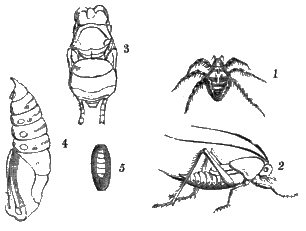 Various forms of Pupæ.
Various forms of Pupæ.
I. The insect, No. 1, is a pupa called the Complete, because it is active, and has many of the parts of the perfect insect. The pupa of the spider is an instance.
II. The insect, No. 2, is a pupa called the Half-complete, or semi-complete. It is also active, resembles the perfect insect, but has only the rudiments of wings. The grasshopper is an instance of this kind of pupa.
III. The insect, No. 3, is a pupa called the Incomplete. It is inactive, but possesses rudiments of legs and wings. The common wasp is represented as an example of this kind.
IV. The insect, No. 4, is a pupa called the Obtected.[K] This pupa has its upper portion encased in the peculiar manner represented, the [254] chest and lower portion being distinct. The butterfly pupa belongs to this division.
V. The insect, No. 5, is a pupa called the Coarctate.[L] In this case the pupa is enclosed within its larva skin, which forms a globular or oval case, the pupa lying loosely in it as if it had shrunk to a smaller size. The pupa of the blow-fly is an example.
Such are the five variations of pupæ, as they were recognised by Linnæus—the Complete, Half-complete, Incomplete, Obtected, and Coarctate. They are sufficiently minute for ordinary purposes: and it will possibly save the reader some confusion of ideas to endeavour to fix them in the memory; so that when looking at an insect whose pupa state may not be so very characteristic as that of the blow-fly, or butterfly, he may still be able to say with confidence, that although it is unlike these, it is nevertheless a pupa. On all subjects nothing is of so much importance as clearness of ideas. It is better to know only a few things, and to understand them clearly, than to have a confused and indistinct knowledge of a great number. It [255] has been, therefore, simply and entirely with a view to obviate this state of things in the mind, that these definitions of the different kinds of pupæ, which may have appeared not altogether interesting, have been given.
Having fulfilled this duty, we may now proceed to the more agreeable task of ascertaining some interesting facts relative to the insect's life and age in the pupa state. We have already seen that the insect in the larva state often arrives at a very respectable old age; indeed, in this state insects live longer than either in the pupa or perfect states. But pupæ also attain to a very fair number of days, sometimes living as long as two years in that state. Often, however, they are not more than a few days in this condition, and the insect, after a short repose, springs forth a new and active being. But it has been found that insects live a longer or shorter period in the pupa state according as the temperature of the air is cold or hot. Thus, for example, when the larva of a moth has become a pupa in the early part of summer, the pupa state will generally not last beyond a fortnight. But if, on the other hand, the larva becomes a pupa late in the autumn, the [256] pupa state will last until June in the next year: thus manifestly teaching us that according as the weather is mild and genial the pupa state will be shortened; or according as it is cold and rigorous it will be increased in duration. The ingenious Réaumur determined to put these singular facts to an experimental test; and as his results are in the highest degree interesting and important, we shall proceed to submit an abstract of them to the reader's notice.
In casting about for the means of exposing the pupæ he was about to experiment on, to a warm and equable temperature, Réaumur determined to conduct his first experiments in the Royal Conservatories, which were always carefully heated, and in which, as he with French naïveté expresses it, "summer reigned in the depths of winter." In the month of January he carried thither a number of boxes containing pupæ of different species. The result was precisely what he had expected:—in the midst of a severe winter a number of butterflies appeared in his boxes, many of which would not naturally have made their appearance until the months of May, August, or even September; thus shortening the pupa state from four, seven, or [257] eight months, to a fortnight, or to five, or to six weeks in different instances. Five or six days seemed to be equal to a month of the natural temperature. The butterflies thus developed were in no respect different from those which are brought into activity at the natural period. They were as active and perfect, as if their time and place of birth had been the green fields, instead of amidst the strange vegetation of these splendid Conservatories. Several of the mother insects deposited their eggs, accomplishing the last act of their existence as if summer had come, and died while the frosts and snow held all external nature yet in bondage. Not only, therefore, was the duration of the pupa state in these insects shortened, but their whole life was thus abridged by several months.
In November of the same year Réaumur recommenced his experiments, and again exposed a number of pupæ to the genial influence of these hot-houses. The result was the same. In the first week in December butterflies appeared, which would not, in natural circumstances, have been developed earlier than the May of the next year. There were some pupæ, in particular, whose development [258] he watched with great interest. These pupæ belonged to a beautiful species of moth, which has two broods in a year; that is, it lays eggs in May which become butterflies in July, and then again lays eggs which become pupæ in August or September, but do not become butterflies until the following June. He was curious to see whether this second brood, instead of waiting for several months, would, like the first, disclose its butterflies in a considerably shorter time, now that it was exposed to the warmth of the Conservatory. Such actually proved to be the case; and thus two generations of these butterflies were obtained in one year. Alluding to the depredations of caterpillars, he quaintly remarks, "This certainly is not a secret which appears very profitable at present; but who can tell whether that which is useless to us to-day, may not possibly become of value to-morrow? Could we discover some new species of larvæ which would supply us with as good a silk as that of the silk-worm, and might be more easy to rear, but which only produced one generation in each year, and if it lived upon leaves which could be found all the year through, we might avail ourselves of this [259] means of increasing the number of its broods." This remark deserves much consideration.
He was now anxious to try whether, by applying a more equable method of warming, he could succeed in hatching pupæ as he had done in the hothouse. The idea occurred to him of endeavouring to hatch them under a hen. He concluded that the warmth of the mother's breast would quite as easily hatch the insects, as it does the eggs. But there was this obstacle in the way: How could he prevent the fragile and tender bodies of the insect pupæ from being crushed and killed by the weight of the hen's body? and, as we would also suggest, How could he ensure that the bird would not actually have eaten up the objects of his care? Aware of the fact, that, when a hen is in the humour to sit, she will often allow smooth stones to be placed among her own eggs, he anticipated no difficulty on that score, and he hit upon the following ingenious experiment:—He procured some hollow glass balls which he had caused to be made as nearly as possible similar in size and shape to the eggs themselves. Into these, by an opening at one end, he introduced seven or eight pupæ, and stopped the mouth up with a [260] cork, but so as to allow a free communication with the external air by paring off a piece from the side of the cork.
Thus prepared, he put the glass egg together with the others in the nest. The hen was a little more sensible than Réaumur had given her credit for; and though she did not thrust the egg out of her nest, she removed it to the outside, where she was so obliging as to permit it to remain; and as it was here just as warm as if it had been in the centre of the eggs, Réaumur did not attempt to interfere with her arrangements. A great deal of moisture arose from the bodies of the pupæ, and condensed like dew on the sides of the glass; but after a day or two this disappeared. The reader may now be anxious to learn the result of this experiment. It was equally successful; indeed, it was more so than the preceding, for in the afternoon of the tenth day a pretty little butterfly was seen within his glass egg, being the first that had appeared of the eight pupæ, and the first ever hatched under the bosom of a hen! The remaining pupæ, all but two, appeared soon after; these two died. Perhaps the warmth of their glassy cell was too violent for them, for it was [261] found by the thermometer to be two or three degrees above blood heat. The whole six pupæ were born in less than six days, while others of the same species in a box in a window-seat were not developed until twelve days later. As the heat thus obtained seemed too violent for pupæ to be artificially reared with success, Réaumur suggests that many variations might be made in the experiments, which would have the effect of moderating its amount. These experiments decided in the most satisfactory manner the quickening influence of increased warmth upon the pupæ of insects. Réaumur now became anxious to try the effects of the opposite state of temperature, and to ascertain whether exposure to cold would exercise any effect upon the pupæ. It was reasonable to imagine that as warmth had hastened forward their development, cold would retard it.
Réaumur determined to try what would be the result of putting his pupæ in their boxes in a cellar, and taking proper care to preserve them from the damps of such a situation. He put them there about the end of January. In ordinary circumstances these pupæ would have become butterflies in the month of July in the same year. [262] July came, and we can conceive the curiosity with which the ingenious experimenter went down, as he tells us, to his cellars, to see if any change had taken place in the pupæ. July passed away; August also passed by, yet the pupæ still slumbered on in their original form. Réaumur left Paris in September, and did not return until the November following. He immediately went in quest of his pupa-charge, and found them still unaltered. Were they dead? Placing one in his hand, it soon began to exhibit such symptoms of motion as plainly showed that it was alive. Winter closed over them still in the pupa form. The spring of the next year dawned upon them, but they were insensible to its influences. "And even now," cries Réaumur, in the month of August, just two years from the time they left the larva form and became pupæ, "they are in perfect health, in excellent condition, and would all become butterflies very soon if I were only to expose them to a warm summer's influence."
"These extraordinary facts," observe Messrs. Kirby and Spence, "lead us to a very singular and unexpected conclusion,—that we have the power of lengthening or shortening the life of many [263] insects at pleasure—that we can cause one individual to live more than twice as long as another of the same species, and vice versâ. Had Paracelsus made this discovery, it would have led him to pursue his researches after the elixir of immortality with redoubled confidence, and would have supplied him with an argument for the possibility of prolonging the life of man beyond its usual term, which his sceptical opponents would have found some difficulty in rebutting. Even the logical Réaumur seems inclined to infer from it, that this object of the alchemist's was not so chimerical as we are wont to conclude. He confesses, however, that, if it were to be attained only by the same process as effects the extension of an insect's life,—by prolonging its state of torpor and insensibility,—few would choose to enjoy it on such conditions. The man of pleasure might, perhaps, not object to a sleep of a hundred years, in the hope of finding something new under the sun when he awakened; and an ardent astronomer would probably commit himself with scientific joy to a repose as long and as sound as that of the Seven Sleepers, for the chance of viewing his predicted return of a comet on stepping out of [264] his cave. But ordinary mortals would consign themselves to the perils of so long a night with reluctance, apprehending a fate no better than that which befel the magician who ordered himself to be cut in small pieces and put in pickle, with the expectation of becoming young again."
But this is in every respect erroneous as a deduction from these experiments on insects. It must not be forgotten, that these experiments were made at a time of the insect's life when it is naturally torpid, and not upon the perfect insect. Had Réaumur attempted to prolong the life of a butterfly, he would have failed completely, that is, if he had adopted the same means; so that all which we can infer from these results is simply this, that we can only prolong or shorten the pupa state, which is a state of torpidity, a kind of half-way between life and death.[M] The human frame knows no such state after birth as can be properly compared [265] to the inactive pupa state of insects; and consequently all reasoning founded on what may take place in such a state under the particular circumstances described, is without foundation. Besides all this, God has himself fixed a limit to human life; and we are expressly assured by his word of truth, that "it is appointed unto man once to die;" and though by reason of strength we may reach far into a long life, yet the hour comes at last, and the green earth closes over the only mortal portion of a man. Undoubtedly had Réaumur prolonged his experiments, he would have found that death, or the transformation of the pupa, would ultimately have taken place.
As yet, we are not aware that any practical results on a large scale have followed from Réaumur's interesting experiments. It has been already remarked, that in countries where the silk-worm is reared, it is the custom to hasten the hatching of the eggs by women carrying little packets of them about their person. But this is only to bring forward the development of the larva state. Perhaps the time anticipated by Réaumur may arrive, when insects may be hatched under hens! or in hatching machines, so as to [266] obtain two instead of one brood of eggs and larvæ in a season. Réaumur suggests that the great and wealthy who have good hot-houses, might give all the appearance of summer to them by introducing pupæ in winter, which would soon be hatched, and butterflies or other insects might be seen flying about in December or January, from flower to flower! But he forgot that gardeners generally are rather averse to the presence of insects at all, and particularly to the all-devouring larvæ of many species of butterflies, which would soon commit sad havoc among their choicest plants. We may recommend such experiments to the reader as highly interesting and easy of performance in a common sitting-room, where a fire is kept in winter, with no other apparatus than a tin-box, or a glass jar of very moderate size; even a pill-box would answer every purpose.
Some curious experiments on pupæ of another kind were also performed by Réaumur. He varnished them over with various varnishes, and found that the pupæ thus varnished were developed several weeks later than others of the same species unvarnished. He tried similar experiments [267] upon eggs, and found that the eggs of a hen would keep fresh for a very long period if they were entirely coated with some kind of varnish. This proved a most useful experiment, for it is now common all over the Continent to preserve eggs by covering them either with oil or butter.
We may learn, in reflecting upon the facts brought to light by this ingenious entomologist, with what admirable care and skill the Great Creator has arranged the period to be occupied by the insect in the pupa state. It has been wisely ordained by these arrangements that the insect shall not be developed until the season when its proper food is to be found, or when a proper position for placing its eggs is to be discovered. The gay flutterer, so tender in its frame, must not be born amid the snows of winter, or in the ungenial days of early spring; its pupa, therefore, requires the warm influences of July and August before it will undergo its change. If it were born earlier than that time it would unquestionably perish, and the insect would become extinct; if later, the same result would take place, for it would fall into the killing power of [268] the early winter evenings. As it is, all is well. The insect and the day are made for one another; for it the flower blossoms, and the warm air breathes, and all nature is spread out in warmth and happiness. Its career run through, it departs from the scene it has enlivened, leaving behind, just at the proper time, and in the proper place, the eggs which are to become quickened, live, and die, like itself, all in their appointed time. We thus perceive that it is chiefly the increasing temperature of the air which fixes the time of the insect's duration as a pupa, and sets in movement all the great chain of the events of external nature. In what way an increase of warmth thus acts we are still unable to say; perhaps, indeed, we may never be able to tell. Neither can we understand how it should be, that the principle of life should be ready at a moment's notice to complete its work in the perfection of the insect, and yet held in abeyance by a few degrees of a lower, or quickened into activity by a few degrees higher, temperature. We know that this has been God's doing, and marvellous it is in our eyes; but the wisest of men feels himself ignorant if asked the question, how it is thus arranged? Truly [269] none but a God infinite in wisdom as well as love would take such thought for so humble a creature as a poor insect; but let us not forget that
|
——"each crawling insect holds a rank Important in the plan of Him who framed This scale of beings,—holds a rank, which, lost, Would break the chain, and leave behind a gap Which Nature's self would rue." |
The duration of the insect in the pupa state, though variable, is, without doubt, limited, and sometimes it is fixed to an hour, quite irrespective of all external circumstances. The most remarkable example of this kind occurs in the case of the insects whose larva we have already mentioned—the Ephemera. These insects appear with the greatest regularity, issuing from the waters of the Seine or Marne, in France, between the 10th and 15th of August. The fishermen call them manna; and when their season is come, they say, "the manna begins to appear," or "the manna fell abundantly last night," alluding, by this expression, either to the astonishing quantity of food which the insects afford to the fish, or to the large quantity of fish which they then take. The [270] fishermen expect them with the greatest confidence during these few days, nor are they ever disappointed. Millions upon millions suddenly rise into the air between eight and ten o'clock in the evening, and this generally for three successive nights.[N] Whatever be the temperature of the atmosphere, whether it be cold or hot, these flies invariably appear at the same hour in the evening, that is, between a quarter and half-past eight; towards nine they begin to fill the air; in the following half hour they are in the greatest numbers; and at ten there are scarcely any to be seen. So that in less than two hours—and these always the same—this infinite host of insects leave their pupa state, become perfect insects, perform their appointed work, and vanish. The same phenomenon of regularity of limit to the pupa state occurs also in other insects, though, perhaps, less strikingly. Some insects constantly leave the pupa at break of day; others in the full tide of noon-day, and others when the shadows of declining day come over the landscape. These, however, are certainly exceptions to the general rule, which appears to lay down no precise period [271] of the day or month when this state is ended, and the perfect state is entered upon; but a limit, nevertheless, exists, mainly dependent for its appointment upon the external influences of warmth and air.
This limit attained, we are brought to the next point in the history of the insect pupa. The beautiful organization of the perfect insect has been going on under the dry and repulsive exterior. Its delicate limbs, exquisitely wrought wings, and the other most wonderful organs with which the perfect insect is furnished, are now completed. Nothing remains but to cast off the slough of its pupa case; and it will then be set free to range whither it will in the great atmosphere into which it will emerge. If the reader has been watching these insect changes with the natural object before him, he will immediately confirm our statement, when we mention that it is often possible to tell when the pupa case is about to disclose its occupant. The general form of the limbs is often very clearly to be seen, and the movements of the included insect become much more sensible and conspicuous. If the beautiful gilded pupæ, called, as we have before said, Chrysalides, or Aureliæ, have [272] been thus nursed with a view to observe their change, it will be noticed that they lose entirely that golden lustre which made them at first such attractive objects. These signs infallibly foretoken the approaching transformation.
THE GREAT CHANGE.
We must now spend a short time in narrating the particular circumstances which attend this interesting event,—the extrication of the insect from its pupa case. We shall, in the first place, speak of such pupæ as are not aquatic, and, afterwards, of the singular ones which are so. In the case of the butterfly, which, as we have recommended repeatedly its being nursed and bred, it will be expedient to mention first, the extrication of the insect is, comparatively with some others, a very simple operation. The insect within is seen to struggle for a time, twisting its body in various ways, until at length a longitudinal slit appears down the middle of its thorax. The slit extends gradually along the head, and down the parts which compose the breast, until the insect emerges from the outer case. The inner membranes [274] are now to be removed, and this, after a little time, is fairly accomplished, and the butterfly emerges, and, leaving the pupa skin behind it, by-and-by plunges for the first time upon the soft waves of the summer air. This is one of the simplest of these methods of extrication.
 Pupa of Goat-Moth.
Pupa of Goat-Moth.
A very natural difficulty will arise in the mind as to what possible means of escape can be granted to such insects as live in the pupa state in the interior of old trunks of trees, or even in little caves of the earth. These cases have all been satisfactorily provided for, puzzling as they may seem. Take, for instance, the pupa of the great goat-moth, the Cossus ligniperda, of which we give a representation here. This creature lies buried in a deep excavation, formerly made by itself when in the larva form, inside the trunk of a willow. How is it to get back to the hole at which it entered? Without legs, without any other apparatus by which it might drag itself forward, one would say it is in a hopeless case; it must lie there and perish, for there appears no way of extricating it from its den. But not so. [275] Helpless as it appears, it will certainly make its way out, and taste the sweets of liberty, and be wafted along the fields of air. But how? Let us suppose a man in such a condition; let his feet be bandaged together, so that they cannot move; let a strait-jacket be put upon his body, and secure his arms and hands; after this, let a leathern bag be put over his head, and tied down round his middle; then put him in a cellar, and bid him work his way out and up the stairs until he reached the front door, where he must undo his bandages, and slip himself out of his strait-jacket and hood; after which, he may go wherever he likes. What a feeling of despair would fill the poor prisoner's mind, promised his release on condition that he should accomplish it in that way! To him it would be a task altogether impossible, even though his life were offered as the reward of his success. It is not less a question of life and death to the insect than it might be to him; yet its extrication is accomplished, not only in a very simple, but in a very easy manner.
If the reader will carefully examine the representation of the insect given in the last page he will notice that the pupa case is provided with [276] certain sharp points, which are all directed towards the tail of the insect; these sharp points are called by entomologists adminicula. They are of infinite consequence to the insect. Who has not himself performed, or been the subject of, the trick of causing a grain of barley to creep up the sleeve? The manner in which it is gradually pushed up is strikingly similar to that in which the pupa of the cossus is forced upwards and out of its wooden gallery. It will be readily supposed that, in consequence of the peculiar direction assumed by the tooth-like processes in question, it will be very difficult to push the pupa backwards, as the points would catch in any obstacle and arrest its progress in that direction; but they offer no resistance to its moving in a forward direction. The manner in which the insect proceeds, then, is as follows:—Being capable of slightly shortening and lengthening the lower part of its body, which is the part thus provided with hooks, it begins to push backwards, but the hooks catch in the sides of the wood, and thus prevent it from moving back, and it is, consequently, actually driven forwards; and so it continues to thrust itself gradually forwards in this simple manner, just as a boy with his hands tied [277] might thrust himself forwards as he lay on the ground, by pushing against any object with his feet. In this way the patient creature moves, we may be sure, by very slow degrees; but that matters little; it moves until it has at length reached the opening of its gallery outside the tree, where it may often be seen sticking out half way. Here, by a remarkable instinct, it ceases to move forwards, for it would otherwise tumble down, and probably destroy itself. At length, after violent struggles, its swathing bands are all either torn asunder, or slidden off, and the insect wings its way in unrestrained freedom far from the scene of its triumphs of patience and hope. The pupa of the "father long-legs" makes its way up from the subterranean chamber in which it has so long been sheltered, fed, and protected, and reaches at length the surface of the ground, where it becomes the perfect insect.
 Swelling of the Head of the Fly.
Swelling of the Head of the Fly.
But other pupæ, although not, perhaps, quite so arduously placed as in the last instance, nevertheless present us with an extremely difficult puzzle, as to how the included insect is to be extricated from its swathing bands. The common flesh-fly, or blow-fly, for instance, in the pupa state is shut [278] up in a membranous case, out of which there seems no escape; but there is a way, and the manner in which the insect gets out of its prison is a remarkably curious one, well repaying the trouble of a little close observation. At the larger end, under which the head of the fly lies, and from which it always issues, there is commonly a sort of lid which can be pushed off like the lid of a box, and the insect can then walk out at pleasure. But in the case of the pupa of the blow-fly this lid is not very easily removed, and the fly, therefore, is furnished with a most ingenious method of thrusting it off. On opening the larger end of such a pupa, if the fly within is ready to come out, a most curious phenomenon will be seen. The insect moves towards the lid, and there begins to blow out its head in the most extraordinary manner, swelling it to twice its natural size; a moment after it will resume its natural size; then again it will puff it out, making its two eyes to start asunder, and its head to assume several different shapes in succession! Two representations are annexed of the [279] striking figure of the insect's head when it thus causes it to swell out. After repeating this action several times, the fly emerges from the pupa. The cause of this remarkable dilatation is the filling of a membrane, situated at the middle part of the head, with air, by which it is blown out into a sort of bladder as large as the head itself. This acts as a kind of lever, and eventually pushes up the lid of the pupa case, allowing the insect to make its exit unmolested. This part generally disappears afterwards, and the head becomes alike firm and unyielding in all its parts; but it may, in at least its rudiments, be seen even in the head of the adult fly, by slightly pressing its head between the fingers, when it appears as at x in the cut.
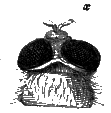 Head of a Fly magnified.
It shows opposite
the letter x the
remains of the membranous
bag.
Head of a Fly magnified.
It shows opposite
the letter x the
remains of the membranous
bag.
More singular still are the circumstances which mark the exit of the insect from the pupa case in other instances; and yet more strikingly than those narrated, do they exhibit to us the amazing exercise of the Divine attributes of wisdom and forethought in the case of these humble beings. The larva of a species of moth, which dwells in a wooden cell scooped out of the poplar tree, to which there is [280] no door by which it can escape readily, gnaws away the wood until it leaves only an extremely delicate layer between it and the outside of the tree, which is as thin as writing paper. This done, it enters into the pupa state. Its time in that condition being accomplished, it moves itself by the same contrivance as the cossus, and actually pushes through the thin layer, and appears on the outside of the tree, thus making its escape from prison by pushing down a part of its prison wall!
An instance described by the naturalist Bonnet is yet more ingenious in the arrangements by which the insect escapes. While in the larva form it takes up its abode inside the leaf of an ash, curiously rolled up into a cone; and then, after a time, it becomes a pupa, forming a silken cocoon of a very slight texture, and, therefore, easily ruptured by the insect, which it suspends like a hammock in the midst of its habitation. It is the closely joined sides of its leafy dwelling that form a barrier which, were it not for the precaution of the larva, would be impenetrable to so small and weak an animal. But, like the last-mentioned, this larva seems to be aware of the feebleness of [281] its next condition, and gnaws in the leaf a round opening, taking care not to cut through the exterior thin layer of tissue, or epidermis. This door is to serve the insect for its exit in due time. But in proportion to its bulk, its green chamber is of considerable size. How, then, shall the insect know the exact place where its portal is situated? How, without a clue, shall it discover in its dark abode the precise circle which requires only a push to throw open its gate? Even this is foreseen and provided for. Out of all other positions in which the little hammock, of which we spoke, might have been hung, and they are numerous, the larva has been directed so to place it, that the silken cord which suspends the head is fastened close to the side of the door which it has previously constructed; and the insect, when it emerges from the pupa, guided by this thread, like Theseus, makes its way out of an apartment which, but for this contrivance, might have been to it a labyrinth as inextricable as that of Minos. Other insects adopt the same precaution of gnawing a doorway for the escape of the perfect insect, only leaving a sufficient thickness of outside tissue to protect the helpless [282] pupa within from the invasion of enemies from without.
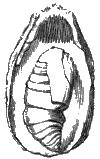 Cocoon of Emperor Moth.
Cocoon of Emperor Moth.
Upon the pear or willow tree may sometimes be found an illustration of escape from the pupa, altogether well deserving our notice. In such situations the brown flask-shaped cocoon of the emperor moth may occasionally be discovered. In structure it is composed of a solid tissue of layers of silk, almost of the texture of parchment; but at the narrow end, or that which may be compared to the neck of the flask, it is composed of a series of loosely attached longitudinal threads, converging like so many bristles to a blunt point, in the middle of which is a circular opening, through which the moth makes its escape, the threads readily yielding to pressure from within, and acting somewhat on the principle of the wires of the opening to a rat-trap, or the willow cricks of an eel-trap. The silk of its cocoon is of so strong a texture, and so closely gummed, that had both ends been similarly closed, the egress of the insect would have been impracticable. But, it may be thought, such a cocoon is exposed [283] to the attacks of a number of insect enemies, who might easily find entrance to it at the opening thus left at one of its ends. This source of peril has been foreseen. Within the exterior funnel-shaped end, at some little distance down, the insect has constructed a second funnel composed of a similar circle of needle-pointed threads, which, proceeding from the sides of the cocoon, converge to a point, and form a cone through which not the smallest aperture is left. From the arched structure of this singular dome, and from the fact just mentioned, that no visible opening can be discerned in it from without, it is rendered quite impenetrable to the most violent attacks of besiegers, while it yields to the slightest pressure from within, and allows the insect to emerge from its cocoon with the utmost facility. When it has passed through it, the elastic threads resume their former position, and the empty cocoon presents just the same appearance that it did before. A celebrated naturalist (Rösel), was sorely perplexed at this, the first time he had the gratification of watching the insect escape. He states that he could scarcely help thinking that there was something supernatural in the appearance of one [284] of these fine emperor moths in a box in which he had put a cocoon of this kind; but in which he could not discover the slightest appearance of any insect having escaped from it, until he slit it longitudinally, and then found it to be empty!
Mr. Rennie mentions an instance, perhaps not so ingenious, but equally curious, with this history of the proceedings of the emperor moth, in a little insect, also a moth, which also dwells upon the willow. It spins an elastic shroud for its pupa, of the singular shape of a boat with the keel uppermost. Its first step is to spin two walls of whitish silk of the required form; and when these are completed, it draws them forcibly together with elastic threads, so placed as to retain them closely shut. The passage of the moth out of this cocoon might have struck Rösel with still greater surprise than he had felt at witnessing that of the emperor moth; for in that cocoon there was at least no apparent difficulty to prevent the egress of the insect, as the opening existed in it at one end, whereas in this there is no opening at all. The insect escapes at the joining of the sides, the threads giving way in a particular spot; and the sides, though originally requiring force to draw [285] them together into the requisite form, become so elastic as to close again when the moth has passed between them, and made its escape. The cocoon preserves precisely the same form after the insect has quitted it as before, and it is impossible, by the naked eye, to detect the place of its exit.
As a general rule, insects make their escape from the pupa case head foremost; but there occurs a very singular exception in the case of some of the gall insects. The males of these insects contrive to make their escape out of the pupa case, formed of the dried skin, tail foremost; and as they thus back out of their dwelling, their wings are necessarily turned backwards over their heads; but a little exercise soon puts the ruffled insect in proper plume again, and the wings resume their customary position.
Some curiosity may be felt to know in what way the silk-worm moth escapes from the double prison,—the pupa case, and the cocoon,—in which she is concealed. How is the moth to make its way through the dense mass of fibres all glued together, which walls her in on every side? Her delicate wings and body would never endure anything like the severity of the struggle [286] necessary to enable her to force her way through this, to her, solid and resisting mass. Though much attention has been paid to the transformations of this particular insect, it is somewhat curious that it is still a matter on which opinions are divided, as to how the insect succeeds in making its egress. Some suppose that the eyes, which are the only hard organs of the head, are the instruments by which the threads are divided, their numerous minute facets serving the purpose of a file. Others hold the belief that the insect pours out a fluid which acts upon the gum and silken fibres of one end of the cocoon, and so softens them that they easily give way to the slightest pressure from within. "Perhaps the two opinions," observe Messrs. Kirby and Spence, "may be reconciled by supposing the silk-worm first to moisten, and then to break, the threads of the cocoon. In those that are of a slighter texture, a mere push against the moistened end is probably sufficient; and hence we find in so many newly-disclosed moths the hair in that part wet and closely pressed down."
It has been supposed, in cases where the cocoon is a hard, almost wooden cell, that the [287] feeble insect prisoner within is provided with a peculiar chemical fluid, of greater powers of solution than are requisite in the last instance. The cocoon of the "pussmoth," in particular, is so hard and dense, as to resist even the point of a penknife; and the insect it holds confined within it is a weak creature, totally unprovided with any apparatus fit for penetrating walls so hard and dense as these. What is it to do? "Here," observe the writers last quoted, "the eyes are clearly incompetent; nor could any ordinary fluid assist their operations, for the gum which unites the woody particles of the cocoon is indissoluble in aqueous menstrua. What an aqueous solvent cannot effect, an acid is competent to; and with a bag of such acid our moth is furnished. The contents of this she pours out as soon as she has forced her head through the skin of the pupa, and upon the opposite end of the cocoon. The acid instantly acts upon the gum, loosens the cohesion of the grains of wood, and a very gentle effort suffices to break down what was, a minute ago, a strong barrier. How admirable and effectual a provision! But there is yet another marvel connected with it. Ask [288] a chemist of what materials a vessel ought to be to contain so potent an acid; he will reply,—Of glass.[O] Yet our moth has no glass recipient; her bottle is a membranous bag; but of so wonderful a fabric as not to be acted upon by a menstruum, which a gum, apparently of a resinous nature, is unable to resist! This fact can only be explained by the analogous insensibility of the stomach to the gastric juice, which can dissolve bone; and it is equally worthy of admiration. In both cases, the vitality of the membranous or fleshy receptacle secures it from the action of the included fluid; but how, who shall explain?"
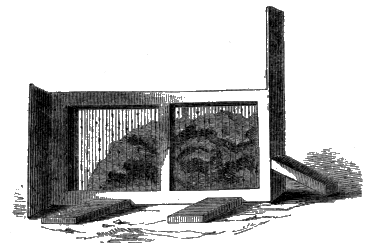 Glazed Ant-hill of M. Huber.
Glazed Ant-hill of M. Huber.
The naturalist, Huber, the patient historian of the ants, gives us a very interesting account of the proceedings of these wonderful insects, in actually assisting the young out of their silken cases. These pupæ are enclosed in a tissue of silk, of so compact a texture, and formed of so strong a silk, as to render it impossible for the prisoner within to rupture the fibres, and get out of prison. The worker ants, therefore, are [289] instructed by a heavenly Ruler and Guide to give help to the prisoners, and to secure their egress. But how do these indefatigable attendants ascertain precisely the moment when their aid is required? The insect within has no power of voice to cry out for help, nor those without, in all probability, the faculty of hearing, if it could do so. It seems probable that they are acquainted with it from some slight movements which take place within, which they ascertain by means of their antennæ. Whatever it be, the attendants never interfere at a wrong time. Their manner of proceeding is beautifully described in the following words of this author:—"Several males and females lay in their envelopes in one of the largest cavities of my glazed ant-hill. The labourer-ants assembled together, and appeared to be in continual motion around them. I noticed three or four mounted upon one of these cocoons, endeavouring to open it with their teeth, at that extremity answering to the head of the pupa. They began to thin it by tearing away some threads of silk where they wished to pierce it, and at length by dint of pinching and biting this tissue, so extremely difficult to break, they formed in it a [290] vast number of apertures. They afterwards attempted to enlarge these openings, by tearing or drawing away the silk; but these efforts proving ineffectual, they passed one of their mandibles into the cocoon, through the apertures they had formed, and by cutting each a thread, one after the other, with great patience, at length effected a passage, of a line[P] in diameter, in the superior part of the web. They now uncovered the head and feet of the prisoner, to which they were desirous of giving liberty; but, before they could effect its release, it was absolutely necessary to enlarge the [291] opening. For this purpose these guardians cut out a portion in the longitudinal direction of the cocoon, with their teeth alone, employing these instruments as we are in the habit of employing a pair of scissors. To expedite the work some raised up a little slip cut out in the length of the cocoon, whilst others drew the insect gently from its imprisonment. When the ant was extricated from its enveloping membrane, it was not, like other insects, capable of enjoying its freedom, and taking flight; it could neither fly, nor walk, nor without difficulty stand, for the body was still confined by another membrane, from which it could not by its own exertions disengage itself.
"In this fresh embarrassment the labourer-ants did not forsake it: they removed the satin-like pellicle which embraced every part of the body, drew the antennæ gently from their investment; then disengaged the feet and the wings, and lastly, the body, with the abdomen and its peduncle. The insect was now in a condition to walk, and receive nourishment, for which it appeared there was urgent need; the first attention, therefore, paid it by the guardians was that of giving it the food I had placed within their reach."
It is droll to add, and it may be some of our readers may feel somewhat abashed at the fact, that these labourer-ants are extremely particular in the observance of great order and regularity in their chambers; and they therefore carefully sweep up all the cast-off coverings, which are collected together, and deposited in one of the most distant lodges of their habitation. Could man, with all the powers of reason, and the faculties of an immortal being, have evinced a more striking instance of careful, gentle, and patient assistance in the hour of need than we see manifested in the case of these insects? Alas! how often does man need to come to them to learn not only a lesson of wisdom and order, but of the tenderest sympathy and affection. How often lies a poor fellow-creature in the bondage of hopeless poverty, or in the embarrassment of inextricable difficulties! How seldom does his emergency meet with that resolute and thorough-minded earnestness of brotherly love, which will patiently give him help and pity, until his troubles are surmounted, and his steps set free!
It is time that we spoke somewhat upon the extrication of insects from their pupa cases, even when [293] under water. Here arises a great difficulty;—the wings of the insects thus placed, if wet with water, would be unfitted for flight, and would probably frequently lead to the death of the insect by drowning. Yet it is to leave its sub-aqueous abode, mount up through the waves overhead, and finally emerge without a drop of water clinging to its body, and from the glassy surface of the water it is to take its flight into the air. Some will be tempted to exclaim,—"This is a clear impossibility!" Far from it. The little worm so well known to anglers as the "caddis-worm," performs this feat with the greatest ease, and in the following manner:—
 The Pupa-case, Larva and Fly of Caddis-worm.
The Pupa-case, Larva and Fly of Caddis-worm.
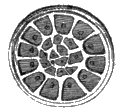 Grating of the Pupa-case.
Grating of the Pupa-case.
It has been mentioned that the larva known under this name constructs for itself a case of various materials in which it dwells at the bottom of the waters, where the hand of the young angler [294] knows well to find them. This case is heavier than water, and consequently cannot float, and so carry the insect to the surface. As the insect enters the pupa state it weaves, at the entrance of its singular habitation, a grating of silk, which, strange to say, is not only not softened and melted away by the water, but hardens under it until it is as hard as gum. This little grating is of a circular form, and fits exactly into the opening, and is perforated with holes, so as to look something like the gratings which cover our coal-cellar mouths in the pavement of cities. These holes are for the purpose of letting in fresh water for the respiration of the insect. Out of this under-water cell the insect must make its escape. To enable it so to do the pupa is furnished with two strong curved jaws, which are of no other use than to assist it in making an opening in one of the silken doors of its case, as they are cast off immediately afterwards, and there remains not a vestige of them in the perfect insect. This opening made, the pupa forces its way out at that end. But what then? How is it to reach the surface, [295] even now? Its legs, as will be seen by looking at the cut, are furnished with a number of hair-like processes, which assist it in swimming; it therefore, still enclosed in the waterproof coat—the pupa skin—strikes upwards to the surface, and reaching it, its skin splits, its impervious raiment is cast aside, and the insect springs from the surface into the air without the minutest drop of water to impede her flight, or injure the delicate tissue of her wings!
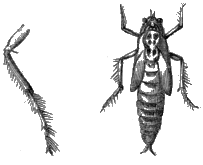 Caddis-fly's Legs magnified to show the Hairs.
Caddis-fly's Legs magnified to show the Hairs.
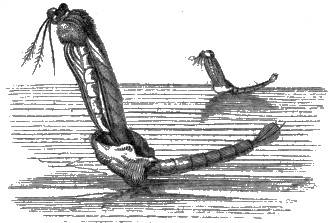 Escape of the Gnat from its Pupa-case.
Escape of the Gnat from its Pupa-case.
We may take another common insect for an illustration of this mode of escape from the pupa, of an equally interesting kind. If the reader will on some fine summer day resort to any place of standing water by the road-side, he may probably succeed in discovering the emergence of a number of gnats; and a very amusing occupation it is to stand by and watch the insect,—this moment an occupant of the waters, and the next darting in the air, a new and air-breathing form of existence! About ten days after the gnat has become pupa, it [296] prepares for leaving that state and becoming a perfect insect by raising itself to the surface of the water, stretching out its body there, the thorax, or, in simpler language, the front enlarged part being raised above it. Immediately the eye of the observer detects the fact that some change is taking place in the insect; the enlarged portion cracks and splits, and through this opening the head of the gnat makes its appearance; then the trunk of the insect rises in a curious manner through the breach, and more and more of its body rises, preserving all the time a perpendicular position, so that it looks just as if it were rising out of the water, and not out of the horizontal pupa case floating on the surface. The upright body of the [297] gnat now resembles a mast in a boat, only that it is continually being raised higher and higher by the gradual emergence of the insect. Its wings and legs are all folded closely down its sides as is shown in the cut; and it has therefore no power at all to prevent its being overset by a breeze, and drowned in the little waves below; the lower portion of its body alone retains it in this position, being as yet contained within the pupa case. No ship-builder dare venture to put a mast of such proportions into any of his vessels, for fear of their being top-heavy, and hence liable to heel over in a gale of wind. And undoubtedly many gnats, particularly in windy weather, are shipwrecked as soon as they emerge. This is, in fact, a moment of peculiar danger to the little insect-mariner, and a breath of untoward air will frequently drive it about like a ship in a tempestuous ocean; and if it is once laid on its side, all is over with the gnat; no patent apparatus can save it; and we have the mournful testimony of Réaumur, that in stormy weather he has seen a vast number of such shipwrecks in the mimic ocean of a pool of water. Generally speaking, the peril is only momentary, and the insect emerges [298] in safety. Having thus raised itself to the perpendicular position, the gnat withdraws its two forelegs from the pupa case, and stretches them out; then it draws out its two next; and now feeling safe, it quits the perpendicular position and bends toward the water, plants its feet on its glistening surface, which is to it as safe as the land, since it has the faculty of walking on the waves. It is now in perfect safety, its wings expand and become dry, and presently the insect will for the first time make use of them by flying to some adjoining twig.
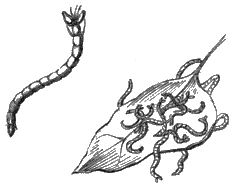 Blood-worms, natural size and magnified.
Blood-worms, natural size and magnified.
But we need not in many cases leave our homes to see an escape from the pupa in every respect as singular as the last, and in many, precisely identical. Before the writer's study-window was an artificial fountain, in which, as the water was not constantly allowed to play, aquatic insects of various kinds had permission to establish themselves. Nor were they long in availing themselves of this liberty. A week or two of genial summer weather was sufficient to people the water with various inhabitants among them was a little creature which will be recognised by every reader when we mention its title—"the blood-worm." It [299] is in reality not a worm at all, although resembling worm in shape, and in its serpent-like movements. This little creature was for a time particularly active; and in a tumbler of water taken from the fountain might be seen perhaps a dozen of them twisting about in a very singular manner. By-and-by a change came over them, and it turned out that the worm-like creatures had become pupæ of a blackish colour, thus at once deciding their insect character. They belong, in fact, to the insect called the Chironomus plumosus. These black pupæ were scarcely less active than the red blood-worms, or larvæ of the same insect. They flapped about their tails with great vehemence, and thus, although their bodies naturally sink in the water, they were able to swim from the bottom to the surface, or from side to side. Observing that they had finished their appointed period in the pupa form, we became anxious to watch their change into the perfect insect. Neglecting, however, to [300] notice them at the proper period,—the afternoon of a warm sunny day, we were astonished the next morning to find a surprising number of pupa skins lying empty of their tenants on the surface, as though some of the water fairies enumerated in fable had been dancing on the waves all night, and left their little black shoes behind them in their haste to flee from the light of the smiling morning. We determined to be better prepared for the observation on that day; and as the afternoon came we had the gratification of seeing a large number of these insects rise from the water, all in the following[Q] manner:—They rose up from the bottom and reached the surface by the peculiar movement of their tails just described; there the thorax was thrust above the water, and immediately the insect burst its cerements, elevated itself by a wave-like motion from the rest of the pupa-case, which filled with air, and now glistened like silver; it then planted its forelegs on the water, withdrew the rest of its body from the case, unfolded its wings, and in a few moments was sailing in the thin air. On one stormy day the surface of our [301] fountain was bestrewn with the dead and dying bodies of these insects drowned in the waves.
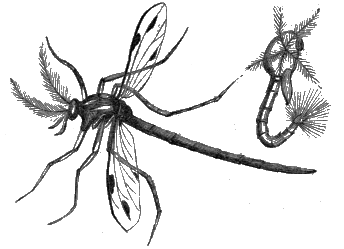 Pupa and perfect Insect of the Chironomus Plumosus.
Pupa and perfect Insect of the Chironomus Plumosus.
De Geer,[R] speaking of the pupæ of a moth, states, that he was not fortunate enough to witness the manner in which they quit their watery abode. But he seems to think that they quit the pupa case, then mount to the surface of the water, or up some aquatic plant, in order to reach a dry spot, where they remain, their wings being developed afterwards, and that thus the risk of their being wetted is avoided. Their bodies being lighter than the water, he [302] conceives, accounts for their being able to rise to its surface. Too much weight, however, must not be attached to this observation, as it is not accompanied with satisfactory ocular evidence of the fact.
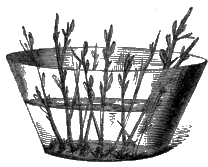 Pupæ of Dragon-fly.
Pupæ of Dragon-fly.
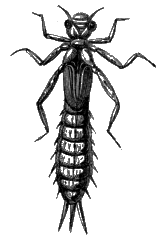 Pupa of Dragon-fly, showing the
sharp points at the end of its feet.
Pupa of Dragon-fly, showing the
sharp points at the end of its feet.
The pupa of the "dragon-fly" furnishes us with a very interesting example of escape; and it well deserves the reader's attention, if he be so placed as to have the opportunity of observing it. Perhaps, indeed, few insects afford us such a singular series of interesting facts as are to be found in the escape of this one from its pupa. The best method of observing their change is to procure as many of the larvæ as possible, to put them in a basin of water, at the bottom of which are a quantity of dead leaves, and to allow several sticks to be in the water touching the bottom of the basin, and reaching above the level of the water, as shown in the cut. Then we must watch carefully to notice any of the larvæ which, having become pupæ, creep towards the edge of the water. These are such as will in all probability be the first to undergo [303] the change, for they come to that position in order that they may get dry before proceeding further. If these are now closely observed, they will be seen after the lapse of a little time to leave their position, and to begin creeping about in search of a suitable spot where they may undergo their metamorphosis. Most probably they will select for this purpose the sticks we have introduced into the basin, and, after running up and down them, will fix upon a particular spot, where they place themselves securely, the head invariably uppermost. From what will be subsequently mentioned, it is necessary that the insect should fasten itself so firmly to the branch, that not even a violent effort would disturb its position. This is secured by the insect thrusting the sharp claws with which its feet are armed into the stem on which it rests. The points of these claws are so fine and hard as even to penetrate wood with facility. They are shown in the cut; and even after the dragon-fly has escaped [304] out of the pupa case, they may be easily made to fasten upon a piece of a branch, by simply pressing the feet against it very lightly. In order to watch the changes of this insect Réaumur once, whilst staying in the country, collected a large number of the pupæ, and placed them on a piece of cotton-print tapestry, where they soon felt at home, and fixed themselves in preparation for their change, without moving far from the spot where they had been placed. At few periods of the day could a visit be paid to the room where this tapestry was hung without seeing a spectacle at once diverting and extraordinary. Previous to its changes the pupa becomes more transparent, and the large and beautiful eyes of the insect it encloses grow increasingly brilliant. These signs always indicate that the transformation is nigh at hand.
It comes to pass in the following manner:—Some movements of a struggling kind take place inside the pupa case; and at length the case splits at the upper part, near the head: through this rent the body of the dragon-fly appears and tears it open, acting like a wedge, until the slit extends along the head across to the two eyes. The latter transverse slit is produced [305] by a contrivance similar to that mentioned in the case of the blow-fly, a sort of air bladder which the insect distends at its pleasure, and thus causes the skin covering its head and eyes to split open. The head and body of the insect rise and make their appearance through the slit; and the head is now so much larger than it appeared while in the pupa case, that it seems almost impossible that it could ever have been contained within it. The insect continues to rise perpendicularly out of the case, and the legs make their exit, leaving the leg cases of the pupa undisturbed in their attachment to the support on which it rests. In order to facilitate the disengagement of the rest of its body the insect now bends itself in a curved form backwards, being only kept from falling by the last rings or segments of its body being still embraced by the sheath of the pupa case. When it has extricated itself thus far, it begins to move about its legs in different directions for several minutes, as if to get them into use; but after this it ceases all movement whatever. Not a quiver can be seen in its limbs, and the young observer would be inclined to conclude,—as a great entomologist once did, the first time he witnessed the [306] changes of this insect,—that it was in reality dead, and that it was a waste of time to watch it any longer. This state of profound inaction may endure for a quarter, or even half an hour: it appears to be intended in order to give time to the insect to recruit its strength for a fresh and more violent series of efforts, and to admit of its parts becoming hardened and dry. Suddenly, as we are, perhaps, carelessly looking on the inanimate object, it performs a feat of the most surprising, because unexpected agility. Its body, which was previously much bent backwards, is now swung forwards and bent into a curve; it then swings back, and then forwards again, and so quickly that it almost seems to leap. It then rests its legs upon the front part of the pupa case, and pulls the rest of its body out of the case by degrees, and then creeps forward, leaving the pupa case behind, still immovably fixed upon the plant.
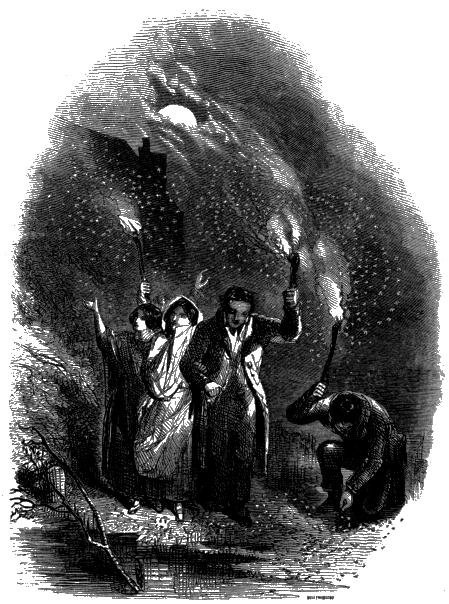 EVENING FLIGHT OF EPHEMERÆ.
EVENING FLIGHT OF EPHEMERÆ."Behold," says Réaumur, "the dragon-fly new born, but very different from those which traverse the air, or rest upon the plants around. It is quite in disguise. The body, though longer than the pupa case out of which it was drawn, has not got all its natural length. The wings, which are the large and useful organs of these flies, have as yet very little more volume than they had when enclosed in the short and straitened pupa case. They are merely furrowed plates, or laminæ, of some thickness, and arranged one over the other, as if packed together. One can scarcely conceive how each of these wings can acquire its proper dimensions,—how it is to enlarge and lengthen sufficiently. They are folded into plaits like a fan, or like the leaf of a tree just about to be developed; hence they naturally appear very narrow, and the cause of their appearing so short is, that each of their longitudinal portions is folded up like the paper lanterns, more frequently used by nuns than by other persons."
The remaining portion of the dragon-fly's history will be found in the next chapter.[S]
Some curious instances are given by various authors of the escape of more than one insect from the same pupa. Thus we are told that a male and female emperor moth were once produced from one larva, and therefore one pupa, of extraordinary size. Messrs. Kirby and Spence [308] tell us of a German entomologist who says, that two specimens of the pine-lappet moth were once produced from one pupa, which was of the remarkable size of two inches in length and one in thickness. But these are very rare instances, the common and almost universal rule being that one pupa only contains one insect.
Nothing now remains for us to add to the insect's history in the pupa state. Already,—for it is Spring far advanced,—the air is becoming peopled with insect tribes—
|
"The insect youth are on the wing, Eager to taste the honied spring, And float amid the liquid noon." |
A thousand times ten thousand, nay, thousands of thousands, are already in the air; and the low hum of their wings may be heard if we stand breathless and listen in the midst of some sequestered spot, far from the roar and bustle and strife of town life. But the great life-season of the insect world is yet to come; and though May whispers it is nigh, June, July, and August must bring it to us, and with it a teeming multitude of insect flutterers more numerous than the stars of heaven, or the sand-grains of the sea-shore.
THE NEW-BORN PERFECT INSECT.
|
"Oh! start not! on thy closing eyes Another day shall still unfold; A sun of milder radiance rise; A happier age of joys untold. Shall the poor worm that shocks thy sight, The humblest form in nature's train, Thus rise in new-born lustre bright, And yet the emblem teach in vain?" |
Beautiful as these lines are, and poetical as is the idea they develop, they are incorrect. The perfect insect springing from the pupa is not an emblem of man's glorious resurrection from this body of sin and death; why, we shall immediately discuss. In the oftentimes beautiful mythology of Greece, the name for the butterfly was [Greek: Psychê], that the soul. Just as the insect bursts [310] with brilliant wings from the dull and grovelling form of the pupa, flutters in the blaze of day, roams on untiring wings through the genial air, and enjoys the use of faculties so new and strange to it, when contrasted with those of the pupa state,—so was it imagined that the soul's arising from amid the corruption of this vile body would prove a deliverance from the bondage of mortality, and the countless infirmities to which it is heir. And surely there was much poetry in the conception; but we, who must not leave the path of true insect history for any poetical fancies, have now to remind the reader that the simile is in many respects inaccurate, and in so doing we shall merely bring to his recollection what was said as to the contents of the pupa-case at p. 231. From this it appears that the pupa state, far from being a state of death, is one in which new parts are added to the insect; in which the insect is actually not only alive, but in some instances capable of moving about, as well as before or after; and, lastly, in which the various organs of the perfect insect all exist previous to the disclosure of the latter. Thus, if we were to slit open a pupa-case just before the insect bursts from it, we should find [311] that, although kept in bondage by the case, the insect was in all respects the same as if we had allowed it to break out of its prison in the ordinary manner. In a word, the perfect insect is after all only the same being which we saw in the egg, larva, and pupa states, now having cast off its last skin, and become an adult being.
When a man or an animal dies, the particles of the body are separated from each other, their union is destroyed, and they themselves are dissipated in various ways. The flesh returns to dust, the spirit to God who gave it. How different this change from that which the insect undergoes! and how inappropriate in strictness, as
|
"Emblems of our own great resurrection, Emblems of the bright and better land," |
as emblems of the mysterious union of the immortal soul and its immortal, incorruptible body! The fable of the Phœnix was more expressive of the real nature of this great change; for there the body of the creature was reduced to death first, and the new-born being sprang from its ashes. As we are anxious to convey only the most clear and accurate idea to the reader's mind of the various stages of insect life through which we are conducting [312] him, it appeared expedient to notice the mistake taught in these pleasing lines, only to avoid the error of its being supposed that they give us an accurate idea of the true nature of the change from pupa to imago.
The term Imago is a Latin word, and, like those of larva and pupa, was given to insects in this condition by the naturalist Linnæus. It signifies properly an image, copy, or representation of any object. In applying it to insects in their last stage, Linnæus intended that we should understand by it, that the insect had now reached its stage of perfection, and had become in all respects exactly like, that is, the image of, its parent. And though a better term might probably be found, yet as no person is likely to fall into any serious mistake merely because we call an insect in its last state an imago, it is as well to retain it; better indeed, than, by inventing another, to create nothing but confusion and disorder in the minds of young entomologists. In this chapter, therefore,—the last chapter of the Life of an Insect, the word imago may be considered as synonymous, or having the same meaning, with that of "perfect insect;" it is an insect's last stage of existence.
It would be a great mistake to suppose that the insect, so soon as it leaves the pupa-case, is in that instant in every respect similar to what is known to us as the perfect insect. When, for example, a butterfly has just succeeded in extricating itself from its pupa-case, if we were to take it up in the expectation of finding it all at once decked with the glories of its wings, and elegant in its form, we should be disappointed. Owing to the cramped position which its limbs, and wings, and other organs, have so long been made to occupy, its appearance when it emerges from the pupa is necessarily different from that which it wears after all its limbs have been in free exercise, and the flutter of its wings has been heard over hill and dale, throwing the gentle air into an irregular line of tumult.
Now that summer has come, abundant opportunities for watching insects in all their stages may be had; and by careful searching of the garden, field, and woodland, a number of pupæ may be discovered on the very eve of disclosing the imago, or perfect insect. Let us suppose that the reader has not looked in vain; but has brought home in a tin box several of these [314] singular objects, about which so much has been said. The pupa, ready to burst open and let loose the struggling captive within, is before him; the skin splits, the body of the insect appears, withdraws itself from the pupa-case and inner membranes, and the imago appears before him. But O, how different from the splendidly adorned insect which we know it is still to become! Its tender body is weak, soft, and languid, and bedewed with moisture. Its wings, instead of being of their usual size, and variegated with such glowing and admirably contrasted colours as only a Divine hand could create, are in the largest sized butterflies scarcely bigger than the nail of the little finger; instead of being uplifted in full strength and beauty, they hang drooping down over the sides of the trunk; and their colours are all dull, and muddy, and without any of those distinct spots and beautifully defined marks, streaks, and bands, which we observe with so much admiration in the wings of these insects. Altogether we might take it rather for a mutilated and imperfect insect, instead of what, in spite of its unattractive appearance, it really is,—a perfect insect, and in a short time to become a splendid one.
We have only to wait patiently for the lapse of a little time, and our desires will be fully gratified in beholding all these symptoms of weakness and imperfection disappear. The imago, attaching itself either to the cast-off pupa-case, or to some other convenient support, first stretches out one organ, and then another; its body loses the coating of moisture which bedewed it, its various parts become firm and hardened, and its colours come forth in all their beauty. All the parts which had been forced into a constrained position, now relieved, assume that which is natural to them in the perfect insect; and the wings no longer have a questionable appearance, but become expanded into those light and exquisite structures which form the peculiar beauty and characteristic of many insects, displaying themselves almost magically in the form, it may be, of the thin, transparent membrane of the fly, or as the painted tissue of the moth or butterfly, extending frequently to five or six times their previous dimensions.
Here let us take up, as an illustration of these beautiful and interesting phenomena, the concluding portion of the history of the dragon-fly, commenced [316] at p. 302. The expansion of the wings of this elegant creature, after it has left the pupa-case, and fixed itself, generally on the stem of some pond plant, goes on so rapidly, that we can actually see them becoming larger each moment as we look upon them. If we were to attempt to trace their outline on paper, before the next stroke could be added, their form would be different. During the whole time that the development of the wings goes on, the insect continues perfectly still and immovable. Its wings are not stirred in the least, and the insect seems to avoid all risk of having these delicate organs touched by any surrounding object. Its wings, which are by-and-by to possess almost the stiffness of a thin layer of the mineral talc, are at present softer and more flexible than wet writing paper, and if they were to receive any injury while in this condition, that injury could never be repaired; hence the insect requires to be in a perfectly quiet condition. The dragon-fly seems to be fully aware of this, and in order to prevent the wings, as they increase in size, from drooping down towards, and coming in contact with, its body, it curves it in the manner represented, so as to allow for the expansion [317] and elongation of the wings. At length, generally in a quarter of an hour's time, their development is fully completed; but they are not yet sufficiently firm and resisting to use in flying. If left to itself, the insect generally waits three, or even four hours, before it puts them into inactivity. In addition to the expansion and elongation of its wings, its body also elongates, until it has acquired its full dimensions. In vain should we look at first for the splendid colours in which these insects are decked; all the tints are blotted and unpleasing. Those charming species, which are spotted with beautiful blue and yellow tints intersprinkled with black, are, when they are but just emerged from the pupa, of a whitish yellow spotted with brown; the yellow marks, however, are seen to change to a beautiful deep orange, the brown to black, and some of the yellow marks to blue.
The following interesting description of the same changes as they take place in the butterfly is from the valuable work of Messrs. Kirby and Spence. "The pupa of a very interesting and beautiful butterfly, the only one of its description that Britain has yet been ascertained to produce, [318] I mean Papilio Machaon, being brought to me by a friend early in May, this year, on the sixteenth of that month I had the pleasure of seeing it leave its pupa-case. With great care I placed it upon my arm, where it kept pacing about for the space of more than an hour, when all its parts appearing consolidated and developed, and the animal perfect in beauty, I secured it, though not without great reluctance, for my cabinet, it being the only living specimen of this fine fly I had ever seen. To observe how gradual, and yet how rapid was the development of the parts and organs, and particularly of the wings, and the perfect coming forth of the colours and spots, as the sun gave vigour to it, was a most interesting spectacle. At first it was unable to elevate or even to move its wings; but in proportion as the aërial or other fluid was forced by the motions of its trunk into their nervures, their numerous corrugations and folds gradually yielded to the action, till they had gained their greatest extent, and the film between all the nervures became tense. The ocelli, and spots, and bars, which appeared at first as but germs or rudiments of what they were to be, grew with the growing wing, and shone [319] forth upon its complete expansion in full magnitude and beauty."
If we were expert anatomists, and were armed with a good microscope, the study of the wing of a dragon-fly would prove one of great interest to us. These beautiful organs, however, must be examined when they are as yet but a little expanded, as in their completely developed state we should certainly fail in detecting their real structure. Thin and gauze-like as they seem, they are in reality double, consisting of an upper and a lower surface, between which are several parts which are necessary to preserve the shape and carry on the functions of the wings. The two surfaces of the wing enclose what are called the nervures, resembling in some respects the veins of a leaf. These are really fine hollow tubes of some firmness, which ramify in large numbers between the two membranes of the wing, and thus give strength and stability of figure to them. Along these tubes, or nervures, branches of the air-vessels, or tracheæ, and of the blood-vessels, run.
From these necessary details let us turn to make the difficult, but important inquiry—How [320] are the wings expanded? by what means do they, from being thick, soft, and moist, become thin, hard, and dry? It is to be regretted that this inquiry cannot be answered with that satisfactory certainty which it deserves. It is very difficult to catch the insects in which the expansion of the wings is best observed at the right moment; and even then it is extremely difficult to say whether one cause more than another may contribute to this phenomenon. The following explanation of it is given by Messrs. Kirby and Spence, whose general accuracy on such subjects is well known. "As soon as the insect is disclosed, a fluid enters the tubes or nervures, and being impelled into their minutest ramifications, necessarily expands their folds; for the nervures themselves are folded, and as they gradually extend in length with them, the moist membranes attached to them are also unfolded and extended. In proportion as this takes place, the expanding membranes approach each other, and at last, being dried by the action of the atmosphere, become one. To promote this motion of the fluid seems the object of the agitations which, in many instances, the animal from time to time gives to its unexpanded wings. That [321] a kind of circulation, or rather an injection of an aqueous fluid into these organs, actually takes place, may be ascertained by a very simple experiment. If you clip the wings of a butterfly during the process of expansion, you will see that the nervures are not only hollow, but that, however dry and empty they may subsequently be found, they at that time actually contain such a fluid. Swammerdam, who appears to have been the first physiologist that paid attention to this subject, was of opinion, that an aëriform as well as an aquiform fluid contributes to produce the effect we are considering. He had observed that if a small portion be cut off from the wing of a bee, a fluid of the latter kind exuded from its vessels in the form of pellucid globules, becoming insensibly drops, which he concluded proved the action of the latter; and he noticed also that the wings were furnished with tracheæ, which were at that time distended by the injected air; whence he justly surmised, that the action of the air was also of great importance to produce the expansion of the wing." But Swammerdam appears only twice to have seen the expansion of the dragon-fly, in which this phenomenon is best observed. Herold, [322] an eminent naturalist, also attributes the expansion of the wing to the flow of an aqueous fluid into the nervures. M. Chabrier, a French entomologist, having observed a fluid in the interior of the nervures of the wings of insects, thinks it probable that they can introduce it into them and withdraw it at their pleasure, so as to facilitate their unfolding. When we call to mind the force with which the blow-fly, or flesh-fly, and the dragon-fly, are able to expand their heads by forcing air into them, we need scarcely ask for any other explanation than simply that the tracheæ are distended with air, and by that means the soft and yielding wings are made to assume their distended state.
It has been mentioned, that, in the case of the dragon-fly, the completion of the unfolding of its wings occupies about a quarter of an hour, but that sometimes it is even half an hour. The ordinary period is from five to ten or fifteen minutes in most insects, but it is sometimes prolonged to an hour, or to several hours. Again, in others, as we have already seen in the history of the emergence of the gnat, and other insects, from their aquatic state in the pupa, it is completed in a few seconds, and the [323] insect only rests for this brief period on the surface of the water, previous to taking flight from its apparently somewhat dangerous position.
Some observations of Mr. Rennie show, in a singular manner, the fact before mentioned, that if the wings, while yet wet and soft, are in any way pressed upon, or otherwise injured, they will never assume their proper appearance. "The thread by which a chrysalis is suspended may sometimes snap asunder; when this happens, and the chrysalis is allowed to remain, it will not usually produce an insect complete in all its parts; for the side upon which it lies being pressed against an unyielding substance by its own weight, instead of hanging lightly suspended by a silken cord, is prevented from becoming duly expanded, and when the insect is excluded, it is found to be deformed. A colony of the brown-tail moth, which we reared during the summer of 1829, spun in the corner of a nurse-box, a common web of several chambers for containing the pupæ. One of these chambers being accidentally torn, a pupa fell upon the earth in the bottom of the box, and in due time, a female moth was produced from it; but she never succeeded in expanding her wings, which remained till her [324] death, shrunk, rumpled, and totally useless for the purpose of flying, though in every other respect she was full grown, and deposited in the box a group of fertile eggs, covered with down from her tail, as neatly as was done by her sisters of the same brood. In the summer of 1825, the chrysalis of a small tortoise-shell butterfly, (Vanessa urticæ,) lost its hold of its silken suspensory, and fell upon the pasteboard bottom of a nurse-box, resting in a sort of angular position, so that the case of the upper wing on the left side, pressed upon the box with the whole weight of the chrysalis above it. When the butterfly made its appearance, it expanded its wings as usual; but the wing upon which it had rested was not half the size of the one on the right side which had lain uppermost. Another of the same brood had, from some cause, not grown so large in the caterpillar state as the rest. It was transformed, notwithstanding, into a chrysalis, which appeared healthy and well-formed; but when the butterfly appeared, though it did not differ from the usual appearance, its wings never expanded a single hair's breadth, and remained always in the same state as when it issued from the chrysalis."
After the insect has once withdrawn itself from the pupa-case, it generally retains the same appearance and raiment as long as it lives, not casting its skin like the larva, but having put on its permanent clothing immediately upon its leaving the pupa-case. But in the case of an aquatic insect, the Ephemera, of which we have before spoken, a remarkable exception to this rule has been noticed. When these insects leave the pupa-case, any one, on looking at them, would say that they had completed their changes; they appear to be furnished with every part necessary to them, and not to have any which is redundant; yet they are destined to go through a change equivalent to that which has just taken place, if, indeed, it is not more apparently difficult than it, and that is,—they have to cast off their skin. That they should be able to withdraw from thence their head, their legs, their body, and their long tails, would be no great difficulty for us to comprehend, because numbers of insects at their escape from the pupa-case do more than this; but in their case we are presented with a more perplexing enigma. In the transformation of other insects, as we have already seen, and, indeed, in that of the insects before us, the wings are at first [326] very soft and pliable, and therefore can be easily withdrawn from the cases in which they were contained. But in the Ephemera, the wings, after it has left the pupa-case, are fully developed and expanded, and seem to have acquired all their consistence, and to have become hard and inflexible. Moreover, its wings are so thin, that we can scarcely believe that they are in reality double; that is, that they are covered by an outside sheath; and it seems incomprehensible how, if such is the fact, the wings can be withdrawn from this case or sheath, when the only opening that can be discovered for that purpose, is a very minute hole near the spot where the wings take origin from the body of the insect. Let us now see how all these difficulties are overcome, and how the insect withdraws itself from this, as we might almost call it, second pupa-case.
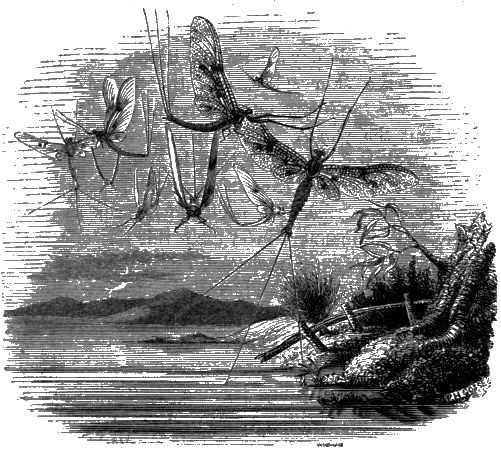 Dance of the Ephemeræ.
Dance of the Ephemeræ.
The Ephemeræ, when they leave the water, rise high into the air, and wing their way perhaps far from the place of their birth. They may often be found wheeling over green fields, or wandering among the forest shades, far from the bubbling stream in whose waters so large a portion of their existence was spent; but more [327] frequently they are to be found somewhere in the neighbourhood of the stream, enjoying an aërial dance. The feet of the insect are armed with hooks of great minuteness, and by their means the insect attaches itself to a suitable object, sometimes to a wall, sometimes to a twig, or to the trunk of a tree; [328] it does not much matter where. Without at first making the least movement, the insect patiently abides the time when it must withdraw itself from its useless upper garment, and sometimes it has to wait a whole day in this position. The time arrived, the skin splits, and the body of the insect rises gradually out of it; but the difficulty is about the wings. Nevertheless, as we watch the insect, we shall find that it gradually draws them out of their delicate cases, and at length emerges, as perfect in beauty and form as before. The manner in which this is effected is as follows:—although the outer case of the wings is hard and rigid, yet the wings which it covers over are preserved in a soft and moist condition. In proportion, therefore, as the insect disengages itself from the anterior part of the skin, the inner or real wings become contracted, by a number of plaits, into a form nearly cylindrical, which readily admits of their being pulled through the openings lately mentioned; and as soon as the insect is released from its envelope, these plaits unfold, and the wings return to their former shape and dimensions. So exactly does this thin skin, thus cast off, fit all the parts of the insect's body, [329] that it may often be mistaken for the insect itself, when it is found clinging to the place where it has gone through its changes.
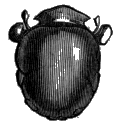 Wingless Beetle.
Wingless Beetle.
Before we leave the subject of the wings, it must be mentioned that there are some insects which have none. The cut represents a beetle of this class.
If the reader will now take a peep into one of the nurse-boxes in which he may have been rearing butterflies from the pupæ, presuming that several of them have ere this burst from their cases, and are fluttering about anxious for liberty, he will generally detect upon the bottom or sides of the box one or two marks of a somewhat reddish colour; sometimes, indeed, they are very red. These spots are produced by the insect, which, on its emergence from the pupa, generally deposits a drop of fluid from its intestines. Almost all insects perform the same action at this period; but we may well remark with Réaumur, it could scarcely have been supposed, that the excrements of a butterfly should ever have filled the minds of a whole population with terror. Such has, however, been the case, and may, perhaps, yet be in [330] districts where ignorance and superstition close the minds of the inhabitants against the truths of entomology. "Historians," says Réaumur, "tell us of showers of blood, as having been the cause of terror to nations, and considered as prophetic of fearful events, of the destruction of cities, and revolutions of kingdoms. At the beginning of the month of July, in the year 1608, one of these showers of blood was said to have fallen in the suburbs of Aix, and for some miles around. It turned out that the supposed drops of blood were in reality drops deposited by the butterflies. It is not improbable that other showers of blood recorded by historians, and taking place about the same period of the year, might be accounted for in the same natural and simple manner. Gregory of Tours relates that in the time of Childebert a shower of blood fell in different places in Paris, and particularly in a certain house situated in the territory of Senlis. Another was said to have fallen toward the end of June, in the reign of King Robert. In the year 1533, we are told by another author, a prodigious multitude of butterflies appeared throughout a great portion of Germany, sprinkling plants, [331] leaves, buildings, clothes, and men, with bloody drops, as if it had rained blood."
In the Gentleman's Magazine for the year 1764 we read that "a kind of rain of a red colour, resembling blood, fell in many parts of the Duchy of Cleves, and caused great consternation. Something of the like kind fell also at Rhenen, in the province of Utrecht." A gentleman is reported to have sent a bottle full of it to Dr. Schutte, to know if it contained anything pernicious to health. Dr. Schutte wrote a learned dissertation upon it, and gave it as his opinion that it was caused by the particles which had been raised into the atmosphere by a strong wind, and that it was in no way hurtful to mankind or beasts. Probably butterflies were the real shedders of this blood-like shower, as in the previous cases.[T]
Our next remark about the imago state of insects will, perhaps, create some surprise—Insects in this state, with some apparent exceptions, do not grow larger. When they leave the pupa state, and have all their parts fully developed, they do not subsequently increase in size. We are often [332] told by ignorant people that the little house-flies which we watch dancing in our chambers, or scrambling up our windows, are only young flies of the same kind as flesh-flies, and that by-and-by they will grow into a large "Blue-bottle!" This is a sad mistake. Let the reader try. Let a fly be put under a glass, and fed with a little sugar, or honey: in vain will he daily examine it, in the expectation of beholding it increase in size—it will live and die nearly the same little being unaltered to the last. If such persons only knew somewhat of the life of an insect, such an absurd, and, unfortunately, very prevalent mistake would not be committed. We might as reasonably call a trout a young salmon! If we were to examine any number of flies of the house-fly kind, (Musca domestica,) and carefully measure them, or weigh them, we should find them all almost exactly of the same size; which, of course would not be the case if they really grew larger as they grew older.
But there are some insects which, after they leave their pupa, increase within a very short time to a size which could scarcely be believed. In particular, the new-born insects of a tribe of flies which produce the aphis-lion larva before spoken [333] of, are distinguished by this peculiarity. We behold a very little insect emerge from the pupa-case, and in a quarter of an hour we are astonished to find it has grown to a great fly! This sudden increase appears the more marvellous, because during this period the insect takes no nourishment. The wings of this insect, when it is just born, are not more than one-tenth the size they acquire in that short space of time. The insect is to all appearance firm and plump, and offers a ridiculous contrast to the tiny pupa-case out of which it has emerged. It appears probable that this sudden enlargement is to be accounted for by the insect filling itself with air, and thus causing the various parts so closely packed together, and fitted into one another, in the pupa, to be expanded. The experiment which puts this idea to the test is a very simple one; we need only prick the body of the insect with a fine needle, and we shall hear a slight sound produced by the escape of the air; and in a few seconds the body of the creature shrinks to its former dimensions. It appears, indeed, that the body of the insect is actually larger at this time than at a subsequent period of its life, when it becomes [334] more flattened and shorter. Another beautiful insect, one of the lace-winged flies, exhibits the same singular phenomenon. Its pupa-case is not larger than a small pea, yet the body of the insect is nearly half-an-inch long, and covers, when its wings and antennæ are expanded, a surface of an inch square. It appears, in fact, almost incredible that it could ever have been contained within so small a compass.
The cases just related may appear to be really exceptions to the rule just laid down, as to the non-increase of insects when once emerged from the pupa; but upon a little consideration it will be found that the exceptions are more apparent than real. The increase in size is not really a process of growth, but is simply owing to the expansion of the body of the insect to its due size, only taking place in a sudden manner by breathing a certain amount of air. The dragon-fly gives us another instance of a similar enlargement soon after leaving the pupa-case.
THE STRUCTURE AND ORGANS OF THE IMAGO.
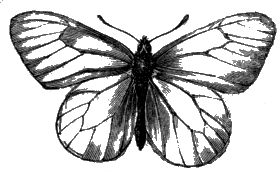 White Hawthorn Butterfly.
White Hawthorn Butterfly.
We must now ask the reader's attention to a very important part of the history of the insect—the knowledge of its various parts, and their uses in the insect economy. Men of science would call this the anatomy and physiology of insects; and if there is a desire felt to know and retain the proper terms employed by those versed in this science when they treat of these subjects, it will be well to bear these names in mind. We may, however, convey some notion of the nature of the studies called by these names, by the following illustration. Let us take yonder butterfly as our example, and, arresting it in its zig-zag career over flowers and fields, let us carefully bring [336] it in-doors, and there look closely at its various parts and appendages. There we find two long, delicate, thread-like organs springing from the head; then we come to the head, with its different organs; farther back is a separate portion, distinct from the head, and distinct, also, from the remainder of the body of the insect; at the side of it are the wings; below are the legs; last of all we bring under our notice the remaining division of the insect's body, the abdomen. Now if Anatomy stood at our right hand while we took notice of each part, she would point out all the peculiarities of its structure, and would tell us of how many other parts it was made up, and how all were beautifully and wonderfully put together by the skill of the Great Creator. Further than this, she would, very probably, strongly insist upon our remembering each part by a particular name; and, as we may add, since she is particularly fond of, and learned in, Latin and Greek, we may rest quite assured each name she communicated to us would be in one or other of these classical languages; for example, instead of saying the butterfly was one of the "scale-winged" insects, which would be far too homely for her, she would declare that [337] it belonged to the Lepidoptera, which is the same thing in Greek; and its "head" she would inform us was the "caput," which is the Latin for that word! This done, her strict duties would be exactly fulfilled, and she would summon her sister-science, Physiology, to give us further information about the butterfly. Physiology, who, we may remark, is a far less stern-looking personage than her austere relative, and appears with a countenance which expresses that she has much to tell us which will greatly interest us, would next take up the panting insect. She would tell us to consider attentively the head of the little creature, while we listened to her elegant account of the purposes it was intended to subserve. She would dilate with eloquence upon the exquisite machinery which was compacted into so small a compass as its mouth; and she would render us almost breathless with amazement, as with rising animation she revealed to us the astonishing optical wonders of an insect's eye, telling us, perhaps, that an insect may probably see like the fabled Argus, behind, and before, and on every side, at the same time! Then she would tell us, in order, the nature and uses of each part, [338] and, in a word, give us a minute, but delightful account of everything that is known about the Life of an Insect.
From this it will be manifest that we have hitherto chiefly listened to the voice of Physiology in this little book, although the leading particulars of the Anatomy of the insect in its various stages have also been brought before us. We must now address ourselves for some little time to learn, from the combined sciences of Anatomy and Physiology, the structure and uses of the different organs, and their principal parts, in the insect, in the imago or perfect state. In order to follow the account we shall have to give the reader, it will be convenient to take some common insect, such as a wasp, and fix in the memory the names of the various parts we shall have to distinguish, in thus treating of the imago-insect. A dragon-fly is a good example also. We shall first mention the general arrangement of the insect's structure; and subsequently take up each part separately.
It must first be mentioned, that insects possess no internal bony skeleton, like that possessed by ourselves and many other animals. If we were [339] to cut open the dead body of a fly, we should look in vain for anything like the back-bone, or the bones of the legs. But it must not, therefore, be thought that insects have no skeleton at all. Their skeleton is the thick, hard, horny substance which forms their external covering. In the wasp, for instance, it will be easily perceived, on pressing the head or the trunk of the insect between the fingers, that there is a very firm, solid coating, protecting the tender and delicate organs within. It is a very singular fact that the wisdom of the Creator has so ordered this outside coating, that where it is most necessary to be strong, as for example, when an insect has to burrow through the ground, or is in danger of being often crushed, there its thickness is greatest; and again where, as in the case of those insects which live chiefly in the air, this thickening is less necessary, because there is less risk of injury to its body, there the external covering is thinner and softer. So extraordinarily is one insect strengthened in its external coats, that it is scarcely possible to crush it by the hardest squeezing between the thumb and fingers. It has, on this account, been compared to a once famous London character, called "Leather-coated [340] Jack," who used to suffer carriages to be driven over his body without receiving any harm!
In looking at an insect, we perceive that it is naturally divisible into three principal parts: first, there is the head, or caput; next, the trunk, or thorax; and thirdly, the hinder portion of the body, or abdomen. If we turn to a Latin dictionary, and hunt out the word insecta, which is the Latin term for "insect," we shall find that it is derived from a verb which signifies "to be cut in," or "notched." From this we see that the very word insect has arisen from perceiving what we are now alluding to, the natural notching of the body of these creatures into certain portions. We mentioned, however, at page 89, that the insect in the larva form had a body which was, in almost every instance, divided into thirteen segments, or parts. It may be asked, Are these all lost in the perfect insect; or are they still to be traced in it? They are still to be traced in it. The head is one, three form the trunk or thorax, and the remaining number constitute the abdomen: but, in order to save disappointment, it must be added, that it is rare to find the full number of segments or distinct parts in the [341] abdomen; we seldom, in fact, find more than seven or eight, the remaining two or one being generally hidden. It is interesting, however, to trace in the perfect insect these indications of its previous larval condition, especially when we remember the strange appearance it underwent while a pupa.
Now the various parts in the head division are, to speak generally, the head proper, the mouth, the eyes, and the antennæ. Entomologists describe a large number of other parts, which would also be mentioned here if this little treatise were intended to give a minute account of the insect's anatomy; and those features which are of most prominence and importance, will be mentioned in addition when we come to speak particularly of these several chief organs.
The middle portion of the insect, or thorax, is divided into three parts—a front, middle, and hinder part; or, in the language of entomology, a pro-thorax, a meso-thorax, and a meta-thorax. Attached to the thorax are the wings and the legs. The remaining portion, or abdomen, is furnished with organs and appendages, not requiring special mention in this place.
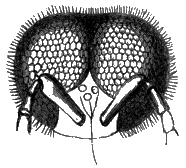 Eyes of a Bee.
Eyes of a Bee.
Let us consider briefly the organs which are seated in these divisions; and, beginning with the head, let us glean a few particulars upon that most interesting topic—the eyes of insects. We might well fill a volume with this subject alone, for truly it is almost inexhaustible. In the other sections of the animal kingdom, the eyes, though organs of the highest importance, are, nevertheless, simple, and little varied in their number and arrangement. But in insects, whether we consider their number, their structure, their arrangement, or their size, we are lost in amazement at finding these organs assume an importance in the insect's economy, of which we have no parallel elsewhere. Look, for example, at the accompanying representation of the eyes of a bee, and then let us ask whether, in all the world beside, we can find a creature whose two eyes are larger than all the rest of its head put together? What should we think of a quadruped as large as a bull, whose eyes occupied great part of its head, its forehead, and the greater portion of its face? What astonishing powers of sight it would possess!

The first thing we learn about them is, that some insects possess what are called simple eyes, and compound eyes. The accompanying cut represents in part the head of a flea, and is annexed in order to give a specimen of a simple eye. The little circle represents the position of the simple eye. All the organs connected with the head are supposed to be cut off. The head of the bee on the preceding page furnishes us with an excellent illustration of a compound eye. All perfect insects are provided with compound eyes, and a large number with simple eyes too; but no imago or perfect insect has simple eyes alone. We see, therefore, that the simple eyes are only additional or supplementary organs to the compound eyes, which are the chief organs of sight in these creatures. These simple eyes are minute lenses generally placed upon the crown of the head, or the forehead; in the bee this is their position; and by means of a pocket-glass, they can be readily seen in this insect, by looking at its head from above. They will be found arranged in a triangular form. Sometimes an insect is furnished with as many as sixteen [344] of these simple eyes; the spider is, among others, thus endowed. But more commonly they are only three in number. Sometimes they are not imbedded in the substance of the head, as might be supposed; but are actually placed upon the end of a little stalk, presenting an appearance as singular, as if at the end of a bull's horn the animal were to possess an eye in addition to his two others. Swammerdam and Réaumur performed some singular experiments upon these eyes in the bee. Réaumur varnished the back of the head, where these eyes are situated, in more than twenty bees, so as, of course, entirely to blind these eyes; but leaving the large compound eye untouched. The bees were then set at liberty within a few paces from the hive, but not one of them knew where to find it again! nor, indeed, did they appear to make any search for it. They flew at random to the adjacent plants, but never to a distance; and though they seemed to have no difficulty in flying, they did not attempt to fly up into the air.
 Eye on a stalk.
Eye on a stalk.
 Eye of the Dragon-Fly.
Eye of the Dragon-Fly.
The compound eyes of insects are, perhaps, among the most wonderful works of the Creator's hands. [345] In those gigantic creatures whose fossilized bones are all now remaining to tell us of their history, the mastodon, and megatherium, and in such vast creatures as the elephant and the whale, we behold the great power, skill, and wisdom of God; but here, in a little object which we may cover with a pin's head or with a large grain of sand, is a more wonderful instance of His infinite and amazing power than all these. The eye of a dragon-fly is a good instance of a compound eye: and of all the beautiful, radiant, gem-like objects that can be selected for inspection through the microscope, this is the most exquisite. Professor Müller, the great German physiologist, has with wonderful patience and care dissected the eye of this insect, and has given a most beautiful account of its structure. On examining the eye of this insect, even with a good pocket magnifying glass, such as those commonly sold by opticians for a few shillings, it will be found to present the appearance of a beautiful net-work, or very fine grating, as is shown in the cut. When a greater magnifying power is employed, it will be seen that each space in this net-work is a six-sided or hexagonal figure. [346] Now each of these little spaces is filled by a beautiful minute lens of the same shape set in it. On making a perpendicular cut into the eye it has been found to consist of various layers: the outer layer is a hard clear membrane composed of a multitude of six-sided facets, each forming a more or less distinct cone-shaped cylinder, which runs towards the centre of the eye, as seen in the cut. Under this is a layer of coloured matter, sometimes of a violet, or green, or even reddish hue, which is pierced with as many holes as there are facets. Beneath this there is a varnish of a black colour, within which is a second layer of coloured matter; and in the space between this last and the first coloured layer the delicate fibres of the nerve of sight, or optic nerve, run. These fibres then converge together at the back of the eye into a single large nerve, which is connected with the insect's brain, and conveys the impression of sight to that organ.
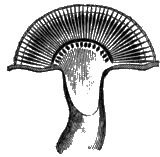 Magnified section of the Eye
and its nerve.
Magnified section of the Eye
and its nerve.
 Magnified section of part
of the Eye.
Magnified section of part
of the Eye.
Perhaps this account may be followed with some difficulty; let us, therefore, take a single facet, and trace it to its termination. Each facet being in fact a distinct eye, we shall be able, in so doing, to get a clear comprehension of the whole organ, which is after all only made up of a large number of these distinct eyes. Separating, then, one facet from the rest, we find this single eye to consist of several portions: 1. the six-sided facet; 2. the cone-shaped cylinder, clear and transparent; 3. a delicate fibre of nerve connected with the bottom of this cone; and, 4. the large nerve itself. The diagram on the next page will make this perfectly intelligible.
But it may be asked, What of the colouring matter? It exists in three places. 1. The first layer surrounds the cones (2), and separates them from one another, and from the nerve below in part. 2. The second layer surrounds the nerve fibres (3). And, 3. the last layer is at the junction of the nerve fibre (3) with the nerve itself (4).
This apparently complicated mechanism well deserves the reader's attention; nor should the subject be quitted until it is clearly understood. [348] We are unable to enter into further particulars upon the structure and functions of this beautiful apparatus; but it must be added, that the following is the manner in which the ray of light becomes perceived by the insect. It first passes through the facet (a), next enters the cone (b), then strikes upon the nerve (c) which conveys the impression, taking the large nerve (d) to the brain. The colouring layers are intended to prevent any rays of light from passing to other parts of the insect's eye, and so confusing the impressions made upon its senses by external objects.
 A single facet separated,
and magnified.
A single facet separated,
and magnified.
The number of these facets, or, if we choose to call them so, distinct eyes, varies in different insects. In some there are comparatively few, in others an amazing multitude. The following list of their number is given by Müller, as observed by various entomologists:—
| In the | Ant there are | 50 |
| " | Convolvulus Sphinx | 1,300 |
| " | Common House-fly | 4,000 |
| " | Silk-worm Moth | 6,236 |
| " | Goat Moth | 11,300 |
| In the | Dragon-fly | 12,544 |
| " | Butterfly | 17,355 |
| " | Mordella | 25,088 |
According to the calculations of another author there cannot be fewer than 34,650 in the compound eye of a butterfly. Amazing thought! each of this immense host is considered to be a separate eye, receives separate impressions of light, and has a separate structure and organization, both perfect in their kind.
It is not difficult to remove the compound eye of an insect; and in so doing it will be found that each lens is as clear as crystal. The ingenious Réaumur actually succeeded in removing one and adjusting it to a lens; and he found that he could see through the insect's eye very distinctly, only he says the surrounding objects appeared to be greatly multiplied. There is a common optical toy which is ground into a number of facets which communicates this appearance to objects when seen through it, and thus furnishes us with a good illustration of the endless confusion of images which would have perplexed the insect, had not the various beautiful contrivances of which we have spoken been adjusted to prevent it.
But we must guard against a very natural mistake which might arise upon the subject of the eyes of insects from supposing them in any degree comparable to those of higher animals as regards their motions. When man, or an animal, wishes to look at any object, they do so by causing several muscles to be brought into action which move the eyes round so as to receive the rays of light from the particular point where this object is placed; and so admirably arranged is the mechanism by which these movements are effected, that they are as well provided for all the purposes of sight with two eyes as with twenty. In insects no such apparatus exists; the eyes are quite immovable; they are, in fact, set in the head like a gem in a lady's ring, and are altogether removed from the control of the insect. In order to obviate the annoyance and inconvenience which would result from this arrangement, their eyes are formed on the wonderful principles already mentioned, and, instead of insects being furnished with two eyes, they are provided with many thousands! They are thus enabled to enjoy not only the same extent and range of vision with ourselves, but even a much larger.
Insects are also furnished with a contrivance by which they can see objects at a little distance, and objects at a great distance—it may be at the same time; which is more than can be strictly said of ourselves. In men and animals there is a very exquisite apparatus arranged within the eye, by means of which it can accommodate itself to objects close at hand, or again to others at the greatest distance. We can see at one moment a pin at our feet, and at the next the summit of a hill some thirty or forty miles off. Now the laws of light are such, that, to effect this properly, we must have some apparatus in the eye to arrange its focal capacity, so as to receive and concentrate the lines of light proceeding from such different points as the distance of a few inches, and that of many miles. What this apparatus may be is not as yet very satisfactorily determined. But in insects the same result is obtained by a very curious provision.—Some of their eyes are short-sighted, and some long-sighted. The simple eyes are supposed, by Professor Müller, to be the short-sighted eyes, and the compound eyes the long-sighted ones.
The number of compound eyes in insects does [352] not often exceed two, these being made up, it will not be forgotten, by multitudes of single eyes. But in a few, whose habits require that they should be endowed with extraordinary means of vision, there are as many as four. If the reader would betake him to the brook-side, and creep noiselessly along its margin some summer afternoon, until he comes to a quiet glassy pool where the water seems to have forgotten itself and fallen asleep, so still, so silent, and so smooth does it lie, reflecting all the lustre of the deep-blue sky overhead, he will surprise a dancing party of insects busy waltzing at a wonderful rate, now skimming hither, now shooting across the glassy pavement on which they sport, now joining together and wheeling round and round, and again, as the king-fisher comes fluttering down the river as though on some errand of immense importance, breaking up their party and flying into a thousand holes and corners to wait until all is quiet. Let him exercise his activity and patience, and catch one of these giddy insects, which are known to entomologists by the name of the Gyrinus Natator, and he will have a good example of an insect provided with four compound eyes, so that it can [353] see not only before and behind, but upward into the sky, and downward into the clear cool waters on whose surface its happy life is spent. Some insects, like Cyclops of old, are furnished only with one eye; and some, it is said, are quite blind—creatures that never feel the blessed influences of the pleasant sunlight. Like the simple eyes, the compound eyes are sometimes fixed on the end of a little footstalk, so as to give the insect somewhat the appearance of being furnished with a pair of opera glasses, or short telescopes.
In order to ascertain by what means the bee found its way to the hive, whether by seeing it through its compound eyes, or otherwise, Réaumur performed an interesting experiment similar in character to the one before mentioned. He covered with a red varnish, which was quite opaque, the compound eyes of a number of bees taken from the same hive. He then shut them up in a box with several other bees from the same hive which he left untouched. The box was only a few paces distant from the hive from which the bees were taken. He then opened the lid of the box, and those which had not been blinded instantly flew out of it, and entered their habitation. Those [354] whose eyes had been varnished appeared not to care to leave the box at all, and seemed very unwilling to make any attempt to fly; some of them, indeed, flew about from one side to another, but did not go far. Réaumur then threw several of them up into the air, and they immediately began to soar higher and higher, until at length they went out of sight altogether! Réaumur compares the poor insect's manœuvres to those of a crow, whose head and eyes mischievous boys have covered with a paper bonnet: the bird flies upward until its strength is exhausted, when it drops again to the earth. Not only did those bees which he threw up into the air thus soar until they were lost to view, but all the most active of those which were left in the box did so likewise, and Réaumur saw them no more. Not one could find its way to the hive. From this experiment, and from the preceding one, it is evident that both the compound and the simple eyes are necessary to enable the insect to see perfectly; for when either was varnished over, the bees could not find their way to their home again. Réaumur imagines that the cause of the wheeling flight of bees, sometimes observed, now in this direction, now in the opposite, [355] may arise from their eyes becoming perhaps in part obscured by the pollen, or yellow powder of the flowers into which they plunge, the bee thereby becoming partly blind-folded. These experiments are so interesting that they deserve repeating, and it might be tried whether the result would be different if only one eye were blinded. Other variations of the experiments will also suggest themselves.
Although not organs of sufficient size to give their colouring the requisite distinctness and amount of surface which would render it very conspicuous in our estimation, the eyes of insects are often exquisitely beautiful, and vie almost with precious stones in lustre. Their most common colour is black, or brown; but the eyes of many flies glow with fiery colours, some banded with green and purple, some variously figured black and red. Some again glitter like burnished gold shaded with the softest green; and some blaze with a play of colours, like the diamond set in jet. The eye of the dragon-fly, in particular, is a lustrous crystalline object of extreme beauty.
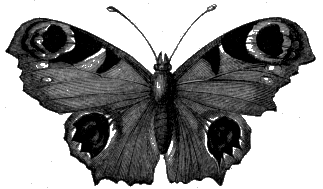 Peacock Butterfly.
Peacock Butterfly.
We have dwelt as long as our limits will permit on this wonderful apparatus of vision in insects: [356] let us now turn our thoughts for a little space to a pair of organs which are, perhaps, of all others the most characteristic of the insect tribes: these are the Antennæ. We need scarcely explain what these are, or point them out to the reader, since they are so familiar to most persons, but under the erroneous, or, at any rate, the questionable expression—"the feelers." We have an excellent specimen of antennæ in those of the butterflies, in which insects they are very long and elegant organs. They are attached to the head by means of a beautiful joint, called a ball and socket, the same as is often adapted to garden watering engine-pipes, so as to enable them to be moved about in all directions. They are never found absent in the perfect insect, and are manifestly organs of considerable importance in [357] the insect economy. As to their structure,—when examined under a microscope, antennæ are found to be composed of a variable number of small round pieces, covered with a horny or leathery skin, but within being softer and hollow, so as to form a series of tubes placed end to end, all connected together in such a manner as to admit of free movement between each joint, so that the insect can bend them into any shape it may find expedient for its purposes. But it must not be supposed that all antennæ are similar in form, or there would be a risk of their being continually mistaken by the reader for some other organ. The cut on the next page will, at a glance, exhibit the astonishing variety of form assumed by these organs. The common cockchafer is possessed of antennæ as strikingly different in form from those of the butterfly, as if they were really distinct organs intended and adapted to serve different purposes. Some are long and thread-like, some resemble a necklace of pearls, some are notched like a saw, some have a resemblance to a fan, some are like a club, some resemble a fork, and some a feather; in short, their variety of form is almost endless: and they differ as much in length and in [358] thickness; for while the antennæ of some insects are as long as, or even longer than, their bodies, those of others are very short, and little prominent; and while some are as thin and fine as the finest hair, others are nearly as thick as the true body of the insect. Let us now ask what is the use of these singular organs of the insect?
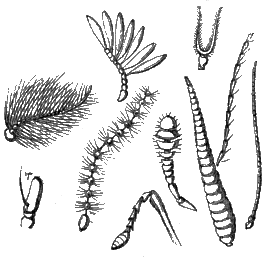 Various Antennæ.
Various Antennæ.
From a hint which has before been dropped, it is probable that the answer to this question will be readily anticipated. Various facts appear to show that they may be the insect's ears! "Can it be that such is their function?" some may exclaim, calling to mind that ears in other creatures are so different in appearance and structure from these organs. There have been many opinions on the subject, and some have maintained views completely opposed to this idea. But the greater number of entomologists seem to consider this as [359] their most probable function. If they are not ears, we are not able to point to any other organs in the head which are. From a number of facts it is certain, that insects can hear; from which it is equally certain, that they must possess special organs. We may, therefore, until the contrary is shown with respect to them, fairly be allowed to consider the antennæ as these organs. The opinions of Messrs. Kirby and Spence on this point are conveyed in the following words:—"They conceive that antennæ by a peculiar structure may collect notices from the atmosphere, receive touches or vibrations, and communicate them to the sensorium (or brain), which, though not precisely to be called hearing, may answer the same purpose." The late celebrated Dr. W. F. Erichson of Berlin, by means of the microscope, has discovered in all insects, and especially in those most remarkable for their powers of smelling, that these organs are furnished with a number of fine pores, clothed with membrane, which he regards as organs of smell.[U]
Every one has heard of M. Pelisson, the prisoner at the Bastile, and his spider companions [360] of the cell. This gentleman had, by patient training, engaged the attention of a spider, which used every day to come and listen to a solo on his violin, after which it would make its retreat again to its home. Now it is clear, that this little insect not only heard, but even enjoyed, the notes of his instrument; which would have been impossible, had it possessed no ears. Then again, every one must have noticed the start which a fly will make if some sharp noise be made near it, and how actively it will move its legs, and seem to be put all on the qui vive. A little every-day observation will furnish us with many similar instances. "A little moth," writes one of the last-mentioned authors, "was reposing on my window; I made a quiet, not loud, but distinct noise; the antenna nearest to me immediately moved towards me. I repeated the noise at least a dozen times, and it was followed every time by the same motion of that organ; till at length the insect, being alarmed, became more agitated and violent in its motions. In this instance it could not be touch; since the antenna was not applied to a surface, but directed towards the quarter from which the sound came, as if to listen." Can we question that [361] the merry grasshopper, chirping all day in the field, is heard by its mate? or that the cricket on the hearth sings for its fellows, or only to please our ears? or does the tap of the death-tick beetle, formerly commemorated, draw forth no answering tap from its companion on the other side of the post? All these instances, and countless more that might be mentioned, indicate, beyond a question, that insects have the faculty of hearing, and render it extremely probable that the antennæ are the organs by which this function is performed.
But it is probable that they serve another and not less important purpose. The country folk, who are generally very weather-wise, and whose sayings always deserve a great deal of attention, because they are very commonly founded both upon observation of facts, and experience, will always assure us that the high flight of swallows in their search after insects is a certain token of fair weather; their low flight of approaching wet. Why is this? Can insects foretell the state of the weather? and if so, by what means? That insects have a meteorometrical power of foretelling the state of the weather, appears beyond a doubt. To select a few instances. [362] Bees, our exemplars in so many points, might be consulted with advantage, and would often give us better information as to whether an over-coat or an umbrella would be probably required, than the not always trustworthy barometer. When engaged in their daily labours, if a change of weather to rain is at hand, although the sun may yet shine and the sky remain clear and calm, they foresee it, and return suddenly to their hives. Hence in weather of an unsettled description they never undertake journeys far from home, but make short excursions to and from their hives, being never absent long at a time; and if we find a bee wandering far from its hive, it may be taken, on the other hand, as a pretty sure prognostic that top-coat and umbrella may be left at home for that day at least. Ants, as we have already noticed, possess the same faculty of weather-wisdom, never allowing their larvæ to be caught in a shower. The abundance of insects in our houses in wet weather, is a familiar observation; we are assured that in hot countries their excessive numbers, during the rainy season, make these little creatures almost as terrible as a plague to all who are within—climbing up [363] the walls, scrambling into the dishes, drowning themselves in the soup-tureens, or putting out the lights with their bodies. In hot and sultry weather, when a black cloud or two in the far horizon give token of a coming storm, insects abound in the air; but as the heavens grow black, they disappear; and before a drop of rain has actually fallen, we may look in vain for them.
That the antennæ are the organs by which this knowledge of coming events with regard to the weather is obtained by the insects, appears probable. They may, perhaps, perceive by their delicate surfaces, changes in the electrical condition of the air, which are quite insensible to ourselves: and as all change of weather is preceded and accompanied by changes of electrical balance of one kind or another in the air, they may be thus forewarned of the coming danger. The following is the manœuvre of a large number of insects of the beetle tribe. When they are about to move from any station where they have been at rest, the first thing they usually do before they move a step, is to bring forward and expand their antennæ, which have previously been folded up out of the way. They open them as [364] widely as possible, so as to expose them to all the influences of the air, and then, if they be satisfied, they unfold their wings and take their flight. We might compare this proceeding with that of one of ourselves looking up at the direction of the wind, or tapping the weather-glass in the hall, previous to setting out for the day! Too much stress, however, it must be added, is not to be laid upon this point; for while it is unquestionable that insects have knowledge of the weather, it is of course very difficult to ascertain with certainty whether it is by means of their antennæ, or by the general feeling of their bodies; analogous, perhaps, to what rheumatic persons feel when the wind goes round to the north-east.
There is a still more singular use of the antennæ, which deserves to be mentioned. These organs appear to be the principal instruments of speech, if we may use such a term, or, at any rate, of the communication of intelligence. When the soldier ants go out upon their expeditions, and have left the nest, previously to setting off, they touch each other with their antennæ and forehead on the trunk; and this is their signal for marching, for as soon as ever a soldier feels this tap, he immediately [365] puts himself in motion. When, also, they have any discovery to communicate, they strike with them those that they meet, in a particularly impressive manner; and if a hungry ant wants to be fed, it touches with its two antennæ, moving them very rapidly, those of the individual from which it expects its meal. They appear to salute one another by gently tapping each other's antennæ, as we should shake hands on meeting an old friend!
M. Huber has related an account of some interesting experiments of his on a hive of bees, which strikingly proves that the antennæ are really organs for the transmission of intelligence. He wished to ascertain whether, when they had lost a queen, they discovered the sad event by their smell, their touch, or any unknown cause; for such a loss, in the course of a single hour, is made known in some way or other to the whole hive. In order to ascertain this, he first divided a hive by a grate which kept the two portions a few parts of an inch separated from each other, so that the bees could not come at each other, although any scent could easily have passed. In that part in which there was no queen, the bees were soon in great agitation; and as they did not [366] discover where she was confined, in a short time they began to construct royal cells, after which they grew more calm. Mr. Huber next separated them by a partition through which they could pass their antennæ, but not their heads. In this case, the bees all remained tranquil, neither intermitting the care of the brood, nor abandoning their other employments; nor did they begin any royal cell. The means they adopted to assure themselves that their queen was safe, and to communicate with her, was to pass their antennæ through the openings of the grate, A most curious spectacle thus presented itself; an infinite number of those organs might be seen at once, as it were inquiring in all directions; and the queen was observed answering these anxious inquiries of her dutiful subjects in the most marked manner; for she was always fastened by her feet to the grate, crossing her antennæ with those of the inquirers.
While we have been anxious to show that the function of feeling is not the important and principal office of these singular organs, it would be far from correct to state that the antennæ are not occasionally employed, to use the popular term, as "feelers." All who have paid any attention [367] to the motions of insects must have seen the antennæ actually employed as it were in exploring the number or nature of objects immediately around. From these and the preceding remarks, it becomes manifest, that, next to the organs of sight, the antennæ are most important and useful appendages to the body of the insect. When we consider the various purposes they serve, we become much perplexed to understand how it is possible for one organ to fulfil such varied duties; nor can it be explained. We are unable to conceive of the senses of insects except by comparing them with our own; and in our case there are no organs which can receive, and, at the same time, communicate, intelligence. Our ears, eyes, nose, and the other organs of the senses, have only one function severally assigned to them; and had they more, there would probably be no little confusion in our perceptions of external things. Such confusion does not probably exist in the insect; but it is very possible that its perceptions are somewhat different from ours.
Before we leave the region of the head, we have the important task to fulfil, of describing the mouth of the insect: this part is more complicated [368] than the organs we have as yet seen, and requires, therefore, a considerable degree of our careful attention to enable us to do justice to it, and to carry in the mind a clear view of this interesting portion of an insect's structure. "If," writes Mr. Westwood, "a beetle, and a butterfly, a house-fly, or an aphis, be examined whilst feeding, a totally different apparatus will be found in each, although perfectly adapted for the mode of feeding. The beetle is employed in gnawing and tearing in pieces hard or fleshy substances: its instruments of manducation are, therefore, horny and robust. The butterfly, on the contrary, has to seek its food at the bottom of the tubes of flowers; and here in the glowing beams of the sun it revels in its existence, and sips the most delicious nectar. It is necessary for this purpose that it should be provided with a long and slender instrument; but, from the very structure of this apparatus, it is essential for its defence, that, so soon as the insect has ceased feeding, the instrument should be lodged in a place of safety. It is, therefore, rolled up in a beautiful spiral direction, and laid to rest between a pair of hairy appendages, which will defend it from injury. If we observe a common [369] fly sipping up a drop of spilt wine, or revelling upon a morsel of sugar, it will be found that its mouth is totally unlike either of the former: it is short, thick, and fleshy, and acts as a sucker, the nutriment ascending through the canal which runs upward into the throat. The aphides and all their brethren have a mouth differently constructed, being a long and slender pointed canal, of a fleshy, or leathery substance, but furnished internally with several slender bristles, which the insect employs as lancets to wound its prey. In the flea, again, the structure is quite different."
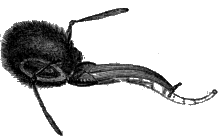 Proboscis of the Honey-Bee.
Proboscis of the Honey-Bee.
 Proboscis of
Carpenter-Bee
Proboscis of
Carpenter-Bee
To the variations in the mouth of each of these insects it has been thought good to attach a distinct name. When, for example, we speak of a bee's proboscis,[V] we speak actually of its mouth. The mouth of the butterfly is called by most entomologists antlia; that of the aphis a promuscis; that of the flea a rostrulum. But the reader [370] must not allow himself to be confused by these terms; they all are but names for modifications of the same part—the mouth. When the butterfly plunges its long tube into the flower—when the fly intoxicates itself with a drop of syrup, using its proboscis to pump it up—and when the flea thrusts its rostrulum into our flesh, and quaffs our life-blood as though it were nectar,—let us not forget the mouth is the organ employed in each of these cases, varied and altered in form though it certainly be.
 Diagram of the mouth.—a. The Labrum, or upper lip; b. The Mandibles, or upper jaws
c. The Maxillæ, or lower jaws; d. The Labium, or lower lip.
Diagram of the mouth.—a. The Labrum, or upper lip; b. The Mandibles, or upper jaws
c. The Maxillæ, or lower jaws; d. The Labium, or lower lip.
In all cases, the various parts of the mouth may be reduced to six, the names of which deserve remembering, and this will be rendered easier by the accompanying diagram, in which they are all separated and lettered, so as to distinguish each part; these six parts consist of four side-pieces, and two other organs, one above, the other below. The name of the upper organ is the upper lip, or in Latin, labrum; that of the opposite [371] lower one, is the lower lip, or labium. The upper pair, of side-pieces, are called the mandibles, or upper jaws; the pair below are the lower jaws, or maxillæ.
Let us now briefly mention the use of these various parts of the insect's mouth; beginning with the upper lip, (a) or labrum. Unlike that organ in ourselves, the insect's upper lip is generally, in such insects as bite their food, a plate of horny substance, which serves the purpose of an upper covering to the rest of the mouth. Like our own upper lips, however, that is to say, like those of men, at least, it is fringed with a sort of moustache in most cases.
The mandibles, (b) or upper jaws, in the biting insects, are instruments for cutting the food in pieces. When we bite our food, the movement of our jaw is upwards and downwards; but in the insect it is like that of a pair of scissors, or from side to side! These jaws are sometimes frightful-looking instruments, resembling, in the stag-beetle, horns; and their power is proportionally great. Although their general use is to masticate or crush the food for the insect, this apparatus is often employed as a formidable weapon of [372] defence, or offence; and very frequently in the excavation of a nest or retreat for the insect. They are sometimes so constructed, as to look as if they were furnished with several teeth.
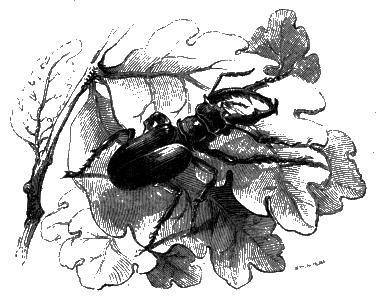 The Stag-Beetle, representing its enlarged Mandibles, like horns.
The Stag-Beetle, representing its enlarged Mandibles, like horns.
The maxillæ, or lower jaws, are less firm and strong than the preceding; but they are more complicated in their structure, and have attached to their sides remarkably delicate little processes like the antennæ, which are called the palpi, or, less properly, feelers. The lower jaws are much [373] varied in structure in different insects; as may well be imagined, when it is mentioned that the long and beautiful spiral tube of the butterfly, by which it drains the juices of the flower, is, in reality, composed of the maxillæ, or lower jaws. In ordinary cases, the principal use of the lower jaws appears to be to hold the food, while the upper jaws bruise and crush it; but their use, of course, varies with their structure and modifications.
The last part of the mouth is the labium, or lower lip. This also is a very complicated organ, generally serving to close the mouth from beneath, like the upper from above. It boasts, like the same organ in higher animals, of a chin below it, called the mentum, and on each side of it are a pair of feelers, or palpi, like those of the maxillæ. In the centre a little tongue-like projection is visible in the figure, which is sometimes called the tongue, but perhaps not correctly, if by that term is meant the apparatus for tasting. The lower lip is as much varied as the maxillæ.
It would be impossible, without going too far into minute technical details, to explain to the reader how all these various parts of the mouth are so modified, and altered, as to assume the very [374] different appearances presented to us in the insects already mentioned. This pleasure must be reserved for the time when, well acquainted with the generalities of insect history, which alone form the scope and subject of this little work, he feels anxious to study entomology as a science; and he will find a number of excellent books which will then well repay his attentive perusal, and satisfactorily answer all his inquiries on this and other difficult topics connected with this science.
It cannot fail to be noticed, that in this description of the insect's mouth no mention has been made of its organs of taste. Its eye, and probably ears, and means of touch, have all come before us; but where, it will be asked, is its tongue? The little organ mentioned as a part of the insect's lower lip, although strikingly resembling a tongue in some instances, is in others very different from it, and appears in such cases to be quite unfitted to act as the organ of taste. We must, therefore, suppose, that other parts of the lower lip or mouth have the same faculty in addition to the so-called tongue. It is very certain that insects have the faculty of tasting, and also of discriminating between their food; as few will be disposed to [375] question, who will place a plate of salt, and a plate filled with moist sugar, in a sunny window on a fine day; it will soon become evident which will be favoured with the attention of the flies.
Neither has any mention been made of a nose.[W] A common flesh-fly, however, will soon satisfy us, that it is not devoid of some organ or other which answers this purpose. If we cover a piece of meat under a cloth, or put it into a wire safe where it is certain that the fly cannot see it, it will scent it out as readily, or even more so, than a cat or a dog would. Sometimes this insect's nose proves a treacherous guide, for a plant has been described, called the carrion-flower, which diffuses an odour like that of putrid meat, which attracts the fly, and induces it to deposit its eggs thereon, under the idea that its future young will thus be hatched upon a certain source of food; but in vain, for they perish almost as soon as born, finding nothing in the plant whereon to exist.[X] But as to the precise seat of the [376] organ of this sense, opinions are greatly at variance. Some believe it to exist in the spiracles, some in the mouth, and some in a special organ which they call the nose, but which does not seem in reality to fulfil that office, at any rate, in the generality of cases. M. Huber showed the existence of this faculty to lie somewhere about the mouth, by some interesting experiments upon bees. He presented successively to all parts of a bee's body a camel-hair pencil dipped in oil of turpentine, to which most insects are extremely averse, but the bee took no notice of it. He then took a very fine hair pencil, while the bee had extended its proboscis, and presented it to its eyes and antennæ without effect; but when he pointed it near the cavity of the mouth, above the insertion of the proboscis, the creature started back in an instant, quitted its food, clapped its wings, and walked about in great agitation, and would have taken flight if the pencil had not been removed. On this it began to eat again; but on the experiment being repeated, it showed signs of similar discomposure; oil of marjoram produced the same effect, and more promptly and entirely. He then seized several bees, forced them to unfold their [377] proboscises, and stopped their mouths with paste. When this was sufficiently dry to prevent their getting rid of it, he restored them to their liberty; they appeared by no means incommoded at being thus gagged, but moved about and breathed as readily as their companions. Huber then tempted them with honey, and presented to them, near the mouth, oil of turpentine and other odours that they usually have an aversion to; but all produced no sensible effect upon them, and they even walked upon pencils saturated with them!
Leaving now the head of the insect, it is necessary for us to make some mention of the parts attached to the thorax, or trunk. In the head division we have seen that the various organs of the senses are situated: we shall now find that in the thorax division are placed the organs by which the insect is either wafted in rapid evolutions to the highest air, or runs with incredible rapidity along the surface of the earth. We have already described, on a previous page, the general structure of an insect's wing. It remains, therefore, for us here to advert to a few other facts in connexion with these elegant appendages.
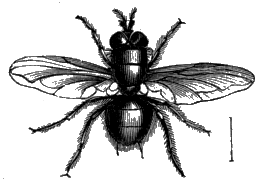 The House Fly. Natural size and magnified.
The House Fly. Natural size and magnified.
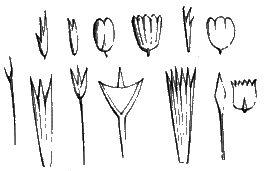 Scales of Insects Wings magnified.
Scales of Insects Wings magnified.
The natural number of wings in the insect world is four, arranged in two pairs. But this number is obscured by the modifications to which in many instances one or other of the pairs becomes subject; and we should, if this were not remembered, become somewhat confused at taking up the first insect that came in our way, which would probably be the common fly, and finding that we could only recognise two large wings instead of four. In this tribe of insects the hinder pair of wings is reduced to a pair of slender knobbed filaments. Some insects are without wings at all. The ant, the bee, the dragon-fly, the house-fly, and many other insects, are furnished with wings of gauze-like transparency and structure, often crossed in a curious manner by the nervures, of which we before had occasion to speak. These wings are called membranaceous. In the moth and butterfly tribes the wings are covered with what appears to be a delicate, beautiful powder, but is in reality a multitude [379] of exquisite scales, of the singular forms represented. The engraving shows the shape of the scales on the wings of these insects; on examination with a good lens, it appears that the long and hair-like scales are planted at the margin of the wings, and contribute to give to the edges that beautiful feathery look which is so much admired, while the short scales were placed principally on the middle portion of the wings; their numbers are almost infinite. If a butterfly is allowed to flutter awhile in a box it will cover every portion of its surface with them, and yet, on being permitted to fly out, we may scarcely perceive that it has lost any of its fairy plumes. Whether Leuwenhoek actually took the trouble to count so many, or arrived at the result from calculation after counting those on a given space, we do not know, but he declares that he found more than four hundred thousand on the wings of the silk-worm moth; and in those of larger [380] moths and butterflies the number must greatly exceed this. They are generally arranged like the tiles on a house-roof; and if they are scraped off, the minute dots where each was attached becomes distinctly visible. The term used to indicate the tribe of insects to which the moth and butterfly appertain, is, as has been before remarked, Lepidoptera, or "scale-winged," from this very fact. Some membranaceous wings are clothed with fine hairs.
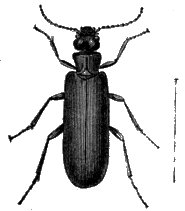 Blight-Beetle.
Natural size and magnified.
Blight-Beetle.
Natural size and magnified.
If we take up a beetle, and look for its wings, for the first time, we shall probably fail in detecting them, that is, of course, if the insect has not been observed in the act of flying. On examining the body we see, indeed, a pair of shining horny plates on its back; but surely these are not wings? Presently, the insect having mounted to the top of our finger, prepares for flight; its two hard cases fly up, and, behold! from beneath them appears a pair of the most beautiful gauze-like wings, [381] which it quickly unfolds, puts into motion, and then flies away. The two thick and horny covers for these delicate organs are called elytra, or "wing-cases." They are really the first pair of wings, much thickened; and their use is to protect the delicate membranous wings of the hinder pair, beneath them. When the insect flies, they open like a box-lid, and are carried out of the way of the other wings; when the insect rests it carefully folds up its other wings, and then these close over them, and preserve them from all injury. As the insects in which they are found frequent places of danger, burrow underground, or take up their abode under stones, it is manifest how admirable a contrivance this is for such purposes, and how efficiently the fragile wings will be covered and protected by such shields. The first pair of wings is sometimes thickened to the consistence of parchment as a cover to the other wings; and they are then called tegmina, or "wing-covers."
There are two other circumstances in connexion with this part of our subject, which deserve noticing. If the reader will take into his hand a large blow-fly, and carefully examine its body [382] with a lens near the spot where the wings are connected to it, he will succeed in discovering two organs of a curious kind. One of these, is a small membranous piece connected with the trunk-end of the wings, and is generally called the winglet, or alula. The other looks like a little drumstick hanging down, and is called the balancer, or poiser, or in Latin, the halter, or bridle. It is not clear of what use either of these organs is. Since the winglets are the largest in the heaviest bodies, and are altogether wanting in the lightest, it appears probable that one of their principal uses is to assist the wings during flight. If one might hazard the conjecture, perhaps they act like the parachute of a balloon. As to the so-called balancers, it has been considered that they serve to poise the insect while flying. Dr. Derham considered that they kept the body steady during flight; and he states that if either a poiser or a winglet is cut off, it will fly awkwardly and unsteadily, as if it had lost some very necessary part. Another observer states, that he cut off the winglets of a fly, leaving both its wings and poisers; but it could no longer fly. He also cut off, in another fly, the poisers alone, and the same result took place. On [383] cutting off both the poisers of a crane-fly, he says it was unable either to fly or walk.[Y] Mr. Westwood says he has seen the poisers beat rapidly upon the winglets like drumsticks on a drum, and it has been supposed that this action is the cause of the hum made by the insect in flying. This is doubtful, because it has been found that after the winglets are cut away the humming sound is still produced; and some humming insects have no winglets.
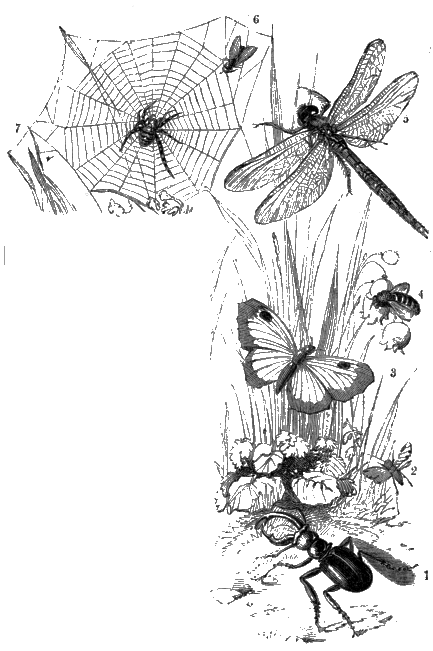
So much importance did Linnæus, the great father of natural history, attach to the character of the wings in insects, that he arranged the various families of insects under several heads expressive of the leading character of their wings. The orders into which he thus divided insects are seven in number: 1. Coleoptera, or case-winged; 2. Hemiptera, or half-winged; 3. Lepidoptera, [384] or scale-winged; 4. Neuroptera, or nerve-winged; 5. Hymenoptera, or membrane-winged; 6. Diptera, two-winged; and, 7. Aptera, or wingless: the Greek word pteron, signifying "a wing," furnishes the termination to each of these titles; the prefix is also derived from the Greek, and its import may be derived from the translation [385] attached to each. This system has been extended by modern entomologists, who have subdivided the 2d, 5th, and 7th orders into additional ones.
In the opposite cut the insects represented illustrate each of the Linnæan orders. They are—1. a Beetle; 2. an Aphis; 3. a Butterfly; 4. a Bee; 5. a Dragon-fly; 6. a House-fly; and, 7. a Spider.
As these organs exhibit to us in the most conspicuous manner the exquisite beauties wherewith it has pleased God, the Almighty Creator, to adorn the insect world, we may be allowed to make some reference to the colours of the wings, before proceeding to speak of those organs by which the insect moves on earth. Some, of the beetle tribe, are like tiny masses of burnished metal gleaming with colours of the most exquisite description. A vast number of locusts are remarkable for the splendour of their wings. Many dragon-flies are adorned with wings vying with those of the butterfly in loveliness. The wings of many flies are exquisitely painted with the most brilliant metallic hues, green and gold; and even those of a house-fly are often very beautiful by their having the property of iridescence, or reflecting [386] the prismatic colours of light. But insects of every tribe, however splendid in attire, fade before the glories of the butterfly tribe. Linnæus, speaking of the splendid colours of these insects, and particularly of the gorgeous tints which appear on the upper surface of the wings of a butterfly called the Morpho Menelaus, and another, justly observes, that there is scarcely anything in nature that for brightness and splendour can be paralleled with this colour. It is a kind of rich ultramarine, that vies with the deepest and purest azure of the sky; and what must cause a striking contrast in flight, the prone surface of the wings is as dull and dark as the opposite is brilliant; so that one can conceive this insect to appear like a planet in full radiance, and under eclipse, as its wings open and shut in the blaze of a tropical sun. The scales on the wings of some species shine with such extraordinary intenseness and brilliancy, that it is impossible to look at them in a bright light, as they completely dazzle the beholder. Messrs. Kirby and Spence say, they "know no insect upon which the sight rests with such untired pleasure as upon the lovely butterfly that bears the name of the unhappy Trojan king [387] (Papilio Priamus); the contrast of the rich green and black of the velvet of its wings with each other, and with the black of its abdomen, is, beyond expression, regal and magnificent." What adds to the beauty of the wings of this tribe of insects is the appearance of the beautiful spots like eyes, which are so familiar to us, and which are almost without a parallel, except in the animal world. This ornament gives to the wings of a butterfly an indescribable life and beauty, and constrains us as we contemplate it to acknowledge that 'Solomon, in all his glory, was not arrayed like one of these.' The astonishing variety of combination in the colours communicates an inexpressible charm to these insect glories: here is a lustrous blue, a glowing orange, a delicate lemon, an exquisite pink, a fiery copper, or a spotless white. None but a Divine hand could have produced such effects as are exhibited in these most gorgeously painted organs. No work of man will endure comparison with them. The most elaborately finished miniature upon which the artist may, in the features and dress of the person, have expended all the resources of his art in the production of harmonious and pleasing tones of colour, [388] appears but as a muddy, lustreless patch, when placed side by side with one of the butterfly-beauties of the tropics, or even of our own green fields.
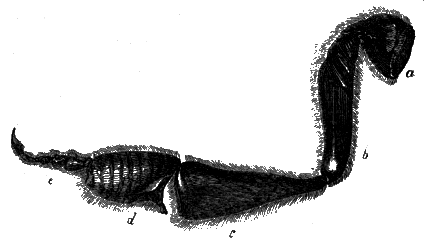 Hind Leg of a Bee.
Hind Leg of a Bee.
We must not, however, allow the fascination of these beautiful objects to engross our whole attention; and it is now time for us to state some particulars connected with the legs of the imago, or perfect insect. Six is the true number of legs which belong to the insect in the imago state. They are connected to its body at the thorax, and are formed of a series of minute tubes, provided internally with muscles and nerves. They are commonly divided into four parts; a the haunch, b the thigh, c the tibia, and d e the foot.
The front pair of legs, or, as they are generally called, the forelegs, are considered by some authors to be really the insect's arms, the last portion of them being the hand. Certainly they are often as useful to the insect as is this admirable organ to ourselves; not only are they serviceable in walking, but they also enable the insect to climb, to lay hold of various objects, or to catch their prey, to dig in the earth, and in many instances to clean the head and face of the creature; an operation in which many of them, and particularly flies and bees among our domestic insects, are most praiseworthily particular; having apparently an aversion to nothing so much as to a dirty face and unbrushed jacket! The other pairs of legs are altered in various manners in order to fit them for the different purposes for which they are required by the insect.
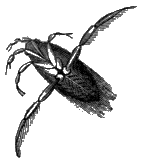
The purposes for which the legs are put into requisition are, as will be easily guessed, for walking or running, for jumping, for climbing, and for swimming. Most surprising in all these respects is the degree of agility and swiftness with which it has pleased the Divine Creator to endow these insect-organs. M. Delisle once observed a fly, [390] only as large as a grain of sand, which ran three inches in half a second, and in that space made the enormous number of five hundred and forty steps. If a man were to be able to walk as fast in proportion to his size, supposing his step to measure two feet, he would, in the course of a minute, have run upwards of twenty miles, a task far surpassing our express railroad engines, or the famous Seven League Boots recorded in the nursery fable. In leaping, also, insects far excel man, or any other animal whatever. The flea can leap two hundred times its own length; so also can the locust. If a man were six feet long, and could leap as high and as far as one of these insects, he might stand near Bow Church in Cheapside, leap up into the air over the top of St. Paul's cross and alight at the bottom of Ludgate Hill; which would be something more wonderful than it has ever entered into the minds of the writers of fairy tales to conceive of. The insect called the frog-hopper can leap more than two hundred and fifty times its own length. Some spiders can leap a couple of feet upon their prey. The legs of insects that swim are generally peculiarly fitted for it, either by their being expanded somewhat [391] like an oar, or by having a dense fringe of hairs upon them. The water-beetles, after rising to the surface of the stream for a supply of fresh air, dive down to their watery home again, taking a clear silvery bubble along with them; and, in this action, they move with considerable rapidity their swimming legs, which are clothed with hairs. The water boatman swims upon his back by means of his singularly formed legs. The little whirl-gig, of which we have before spoken, swims by means of its legs, which are paddle-shaped. By means, it may be, of some peculiar secretion, which repels the water, some insects can actually walk upon its surface, and that as readily or more so than upon land. Those who know the pleasures of shooting with polished skates over clear ice, when it almost seems as if we were moving in the air, and no more condemned to earth, can imagine something of the delight these insects must experience, who can glide as swift as thought over the glassy surface of the brook. Sometimes the shape of the hind-legs is remarkably altered, and, perhaps, [392] the most extraordinary instance of this in the whole insect world is, the foreign insect, which has been called the Kangaroo beetle. The cut represents faithfully this most wonderful creature; and we could almost fancy, as we looked at it, that by some accident the front pair of legs and the head had been twisted round, leaving the hind legs and part of the body turned in the opposite direction. It need scarcely be added, that the origin of this insect's curious title was derived from the resemblance borne by its hind legs to those of the animal whose name it bears. In some insects the legs fold upon each other, and are packed into a very small compass: this is particularly the case in a species of wood-louse, which roll themselves up into balls precisely resembling beads or pills, as may be imagined from the following anecdote. A servant maid of the great Swammerdam, while walking in the garden one [393] day, found a large number of round, black, shining beads, which were streaked with white bands, and presented a very pretty and attractive appearance. Gathering a number of these in her hand, she thought she would convert them into a necklace, or, for ought we know, into a rosary, when, to her great surprise, the beads became animated as soon as ever they felt the point of the needle, with which she was about to thread them, and began to struggle actively to get away; not, however, too quickly for her; for with a violent scream, imagining the beads were bewitched, she ran into the house. Some of the beetle tribe thus fold up their legs, and roll themselves up so as to resemble little globular pebbles.
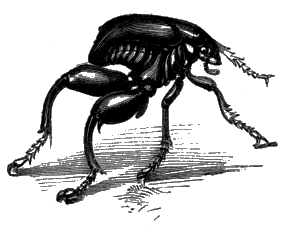 Kangaroo Beetle.
Kangaroo Beetle.
The Abdomen is, then, the only remaining portion of the insect which we have now to notice. It has no legs attached to it, and contains the intestines, and other portions of the insect's internal anatomy. It is formed of a varying number of rings, which are easily distinguishable in the wasp and many other insects, and these rings are connected together by delicate folds of membrane, fitting sometimes into each other like the tubes of a telescope; in other instances fastened together, [394] like so many hoops, by their edges. In consequence of this mode of structure it is often very movable, and may even be bent into a half curve, in various directions, at the pleasure of the insect. The common earwig is particularly gifted with this movableness of its abdomen; and so are many insects which carry weapons of offence or defence in their tails. These organs, or appendages, are deserving of a brief notice, although it is probable that the structure of some of them is already familiar to most readers.
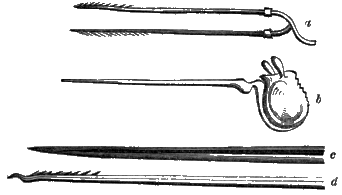 A Bee's Sting magnified.
a, represents the pair of darts; d, a single dart; b, the poison-bag; and c, the sheath.
A Bee's Sting magnified.
a, represents the pair of darts; d, a single dart; b, the poison-bag; and c, the sheath.
The sting of the bee is, perhaps, as formidable a weapon as any of those attached to the abdomen in insects; under the microscope the structure of this apparatus appears in all its beauty. It is found to consist of a sort of sheath, or scabbard, which is composed of two pieces, and is of extreme fineness, as will be readily made visible by placing a fine sewing needle by its side, when the latter will more resemble a bar of iron from the smith's forge, or a kitchen poker, than anything else; while the former will, under the strongest magnifying power, exhibit a smoothness, elegance, and polish, of the most beautiful description. When the bee thrusts forth its sting, it is the sheath which we [395] generally see, and not the more delicate apparatus which is enclosed within it. Inside this scabbard is a pair of most fine darts, which are even more delicate than the human hair, and are therefore invisible to the eye, unassisted by a good lens. These darts are notched like very fine saws at the end, the teeth being so directed as to oppose the retraction of the instrument if it is thrust into the human skin; the sting being therefore left in the wound, and the wounded person having the comfort of knowing—if we should call it a comfort—that the insect will surely die speedily, in consequence of its attack upon him. An exquisite adaptation of fine muscles is attached to this weapon, by which it is forcibly driven home. [396] The venom which produces the pain and inflammation is contained in a small muscular bag in connexion with the sting; and when the latter is thrust out, the poison is also forced out and flows into the wound. The sting of the scorpion is a less complicated, but more dangerous weapon, though not often fatal. The earwig, though unprovided with a sting, carries a most awful-looking forceps in its tail, which it can put in action with great force on occasion of danger; and since it can twist its abdomen about with great facility, it is a contrivance of which a tender finger may well be afraid.
Among the wingless insects of Linnæus, is one which he has called by a name which signifies that it has got a leg in its tail; and this is actually the fact, in so far as that these insects have an organ in their tail, which answers all the purpose of a leg. Some of these little creatures, which are black, may be often found in spring strewed in infinite numbers upon the surface of the water in ditches or pools; and may be seen jumping about on the surface of the water as if bewitched. At their tail is a fork-like organ, which is generally bent under the body; but [397] when they spring up they do so by quickly unbending this fork, the resistance it meets with being sufficient to carry it to a certain distance. Another insect is provided with eight pair of springs in its abdomen; by means of which it can leap to a great distance with most astonishing agility. Here we shall conclude the external anatomy of the insect, in the imago state.
RESPIRATION OF THE IMAGO.
Perfect insects breathe. That this is so, the following experiments[Z] will satisfactorily prove. A spider and a fly were put into a glass jar, the mouth of which was closed all but a hole by which a tube was admitted. The tube was then connected with a pipe by which a supply of common coal-gas was poured into the jar, and when it was considered to be full of gas, and that all the air had been displaced, the tube was closed, and the insects were left shut up in an atmosphere of gas. In a few seconds both became very uneasy, the fly more particularly so; and in a few seconds more the fly began to agitate itself, to buzz against the sides of the glass, and to tumble over in the most extraordinary manner; the spider ran hurriedly about, as if astonished, and not knowing what to make of his new position; but presently he became very quiet, and, turning on his back, looked as if dead. For a [399] minute or two the fly, which was a large, active, flesh-fly, continued its noisy evolutions, dashing itself, as if intoxicated, on every side of its transparent prison. At length, as if exhausted, it lay on its back, its limbs paralyzed, but the wings still moving with extreme rapidity, and causing it to spin round in the most singular manner. Ultimately it, too, became perfectly without motion. After the lapse of about ten minutes, fresh air was gradually let into the jar, and it became most amusing to watch the return of both these insects, which had previously been as it were in the very jaws of death, back to life again; twitchings of their limbs, and slight convulsive movements, were the first indications of returning activity; and in a few minutes more both insects, now placed in a perfectly pure atmosphere, were as lively as before the experiment, and were allowed to make their escape into the open air. With other insects the same effects were produced by saturating a piece of blotting paper with ether, and dropping it into the jar, which was immediately covered over. In several other experiments the newly-discovered powerful fluid chloroform, by means of which the operations of surgery are [400] performed without pain, was employed; and it was remarkable to notice how quickly the insects were overpowered with the vapour of this potent liquid. In no instance was death produced by the gases or vapours employed. Wishing to destroy without pain a beautiful specimen of a goat-moth, it was first stupified with the gas, then transfixed with a pin, and again plunged in an atmosphere of gas all night long; but alas! for the unhappy insect, the morning dawned, and it was yet alive.
In these simple experiments, which were repeated sufficiently often to render the results certain, we have a most interesting proof that insects breathe. The first struggles and apparent intoxication can be compared to nothing more exactly than to the same phenomena when they take place in human beings breathing the vapours of ether, or chloroform. The subsequent state of insensibility was precisely similar to that induced in persons who are put under the influence of these vapours. An amusing instance of the restorative powers of fresh air occurred in the course of these experiments. A blue-bottle, which was purposely selected of as large a species as could be found, was [401] first intoxicated and rendered insensible by coal gas, and was then as quickly as possible put into a net of the geometric spider: instantly the spider flew upon his bulky captive, but the fresh air began to take effect on the fly, and it commenced struggling in the most furious manner. Although the spider cast out a cloud of web, and in the most energetic manner endeavoured to envelope its prey, the fly seemed likely to be the victor; one of its large and powerful wings got free and flapped violently until the meshes of the web gave way, or was, perhaps, broken by the weight of the insect, and fly and spider, being suspended in the air, spun round so swiftly as to be quite indistinguishable. Ultimately, the spider conquered; and, suspending the huge body of its victim by a rope in the air, returned for a short time to its den.
If insects do not breathe, then all these results are quite unintelligible; for it would be immaterial to the insect what atmosphere it might happen to be placed in. A number of illustrious authors have recorded the result of their experiments upon the effects of other gases on insects. Bees, and other insects, have been placed under the exhausted receiver of an air-pump, and death ensued in a short [402] space of time. It has also been found, that when the bodies of insects are covered with oil or grease, so as to stop up their breathing pores, they soon expire. It has been proved by carefully conducted experiments performed by Mr. Ellis, M. Sorg, and other observers, that on placing flies in a measured quantity of atmospheric air, at the end of a day or two almost the whole amount of the oxygen of the air had disappeared, and the same amount of carbonic acid had appeared in the chamber in which the insects were confined. We need not, however, after all that has been said on the subject of the respiration of insects in their various stages, enter into any further proofs that insects breathe not less perfectly in their imago condition than in any of the preceding states; in fact, they perform this function far more prominently in this their last state than in any of the foregoing. It will also be unnecessary to enter into a consideration of the minute particulars connected with this subject, as several of these have been previously glanced at.[AA]
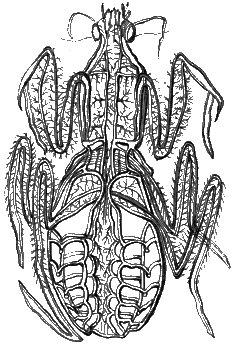 The Air-tubes magnified.
The Air-tubes magnified.
The air enters the body of the insect at the spiracles, or breathing-pores, which are arranged [403] along the abdomen, and situated at the side of the wings, and is received by a large tube on each side of the body, running its whole length, or nearly so, as we before mentioned. This tube, and those which it gives off as branches, are called tracheæ, or air-pipes. The tracheæ are formed in the most wonderful manner, so as to keep them always open, that the air can readily pass through them. Perhaps some of our readers have seen the contrivance adopted by sailors in order to blow air down into the hold and cabins of the ship; for those who have not, we may take the liberty of mentioning, that it is a large tube made of canvass, open at the side near the top, so as to catch the wind, while the bottom of it opens into the cabin. Now, the sailors always place the mouth of this tube towards the wind, which is forced down the tube into the cabin either by its own speed, or by that of the vessel, in the case of a steamer, and so fills the cabin below continually with fresh air. But, it will be asked, how do they contrive so to keep the sides of the bag from flapping together as to prevent them from closing? By imitating a contrivance which exists in the trachea or air-tube of the [404] insect; they place at certain distances inside this canvass tube a series of wooden hoops, which entirely prevent its collapsing, as it otherwise would do. The most minute air-tubes of an insect are furnished, not, indeed, with a series of rings, but with what serves the same purpose, a firm but delicate coil of cartilage like a spiral spring, over which the membranous lining of the tube is stretched. Thus these tubes remain constantly open; and, whatever may be the movements of the insect, they retain this position. The tracheæ branch out in a most wonderful manner inside the insect's body: as thickly as in our bodies and in those of animals the fine blood-vessels divide until they form a mesh so close that we cannot prick ourselves with a pin without piercing some little tubes, and drawing blood; so in those of the insect, the minute air-pipes run in every direction, and divide into countless thousands of branches, which only become visible under the highest powers of a good microscope. The large tubes are seen without difficulty in many insects; and a drawing, which may give some idea of the immense mass of air-tubes existing in the body of an insect, is annexed: all the rest of the body is supposed to be cut away, [405] and the larger tubes only are shown, as it is impossible to represent the smaller ones so as to give a clear view of their arrangement; they would cover the drawing like a cloud of the finest and most delicate lace-work. In short, in insects, there being no separate lungs in a particular place, as in the animal frame, the air is necessarily carried all over the body, so as to be supplied even to the most minute parts; thus the lungs may be said to extend through the whole body.
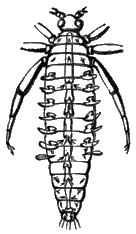 The circulation in an Ephemera.
The arrows represent
the direction of the
blood-current.
The circulation in an Ephemera.
The arrows represent
the direction of the
blood-current.
As the reader has laid his finger on his pulse, or felt his heart beating within him, or seen a drop of blood ooze from his wounded hand, have the questions never occurred to him,—Have insects blood-vessels, and a beating heart? And if so, have they blood like ours? Many a wise man of [406] old, even the great Baron Cuvier himself, has supposed that there was no circulation of the blood in insects. But, with a magnifying glass and a caterpillar before us, we shall soon be satisfied that this is a great mistake, for by carefully looking along the insect's back we shall perceive in that part a very evident pulsation, as though a fluid were pushed at regular intervals towards the head. The cut represents the circulation in the vessels of the larva of an Ephemera. But insects have no heart, like that of man and animals. What, then, can this beating organ be which we behold? Although it is not like our heart, it is nevertheless an organ which serves all the purpose of ours, and pumps on the blood with great regularity. Instead of being a muscular organ of small size, but great thickness, like our heart, it is in reality a long tube, called the dorsal-vessel, running along the abdomen and thorax of the insect, into which the blood is poured by the veins, and out of which it is forced on towards the [407] head by the regular contractions of its side. This causes the beating movement which we saw in the caterpillar. Perhaps there may be some curiosity to know whether an insect's pulse beats faster or slower than ours. John Hunter counted thirty-four beats in a minute in a silk-worm. Another observer counted thirty a minute in a caterpillar of the pine-moth. But in the imago state the pulse appears to move much quicker: and it is easy to make an insect's beat extremely fast, by exciting or provoking it. Mr. Newport having done so to a bee, counted as many as 142 beats a minute. In a middle-aged man the pulse beats about seventy times in a minute; in a child seven years old about eighty-five times; and at the age of fourteen about eighty times. Hence it follows that our pulse beats about twice as fast as that of an insect in the larva state: in the imago state it is probably, as a general rule, at least in winged, active insects, higher than ours.
FOOD AND DEATH OF THE IMAGO.
But we have something to say about the food of insects. Although it has been already laid down as a general rule, that insects in their perfect state, do not eat in any degree with the voracity they exhibit in the larva form, it is nevertheless true that they do both require and devour food in considerable quantities, and of various kinds. Some, for example, are exclusively vegetable feeders. They attack all the parts of plants, not excepting even the root and the bark. Some, with an elegant taste, select the yellow pollen of flowers for their dainty and delicate food. And others, more refined still in their appetites, will have nothing but the fresh distilled honey that lies hid at the bottom of the flowers, pumping it up by the beautiful spirally-coiled tube [409] which forms a part of their mouth. Need we say these are the butterflies? The fly loves a grain of sugar, or a savoury joint of meat: and to other insects, to use a quotation of Mr. Spence's, which prefer the paper of our Atlases, or maps,—
|
----"a river and a sea Are a dish of tea, And a kingdom bread and butter." |
A large number also are carnivorous creatures: need we mention the spider-tribe? a name of terror to myriads of our summer insect-friends. The beautiful cicindelæ, called by Linnæus the "tigers to insects," prey upon the whole insect race, and are endowed with powers of offence and destruction, to a degree sufficient fully to justify this title. In France, we are told, the butchers are very glad to have wasps attend their stalls; since they drive away, and undoubtedly prey upon, the numerous flies which frequent these places. The larger species of ants are equally ferocious, attacking any small soft-bodied insect they may meet with, and when killed dragging it to their nest. The beautiful lady-birds, which we look upon with so much tenderness, remembering the ditty,
|
"Lady-bird, lady-bird, fly away home, Your house is on fire, your children will burn;" |
are in the larva state furious destroyers of other insects, and will gobble up aphides by the score in a very short time. The dragon-fly too stands conspicuous among the insect devourers, not only in its larva but in its perfect condition, and falls upon multitudes of insects, plucking off their wings, and with savage relish devouring their bodies. We are not, however, to suppose that the appetites of carnivorous insects are confined to insect-food. The blow fly lives upon and defiles by depositing its eggs in our butcher's meat. The cockroach will polish a bone as clean as, or cleaner than, any dog will, and, indeed, will consume almost anything that happens to come in its way. Lastly, we may not omit to mention, that some insects have to plunge their armed mouths into our flesh and that of other animals, and to slake their raging thirst in a draught of our life-blood: among which we will only enumerate the musquito, the gnat, and the flea. We need scarcely say, that insects are provided with proper organs of digestion.
Singular to add, some insects in the perfect [411] state do not eat at all. The silk-worm moth, and the Ephemeræ, are amongst this number; they live so short a time, as not to require food. Some insects also possess a most extraordinary power of abstaining from food. There have been at different times wonderful tales related of human beings, who, in a supposed trance, have endured the privation of food for an extremely long time,—weeks, and even months. And more recently we have an account of an Indian who suffered himself to be buried alive, built over with bricks and mortar, and a great seal set upon the only opening to his tomb, a guard being also set; and, after the expiration of a certain time, before agreed upon, the sepulchre was opened, and he was taken out—alive! All this is extremely wonderful, if we could only feel certain that there was no deception in the case. But it is nothing to what can be adduced from the insect world. The ant-lion has been known to endure a fast of six entire months, and to be as lively as possible at their termination. An author quoted by Messrs. Kirby and Spence kept a spider in a sealed glass for ten months, at the end of which time, though shrunk in size, it was as vigorous as [412] ever. And Mr. Baker relates that he once kept a beetle alive for three years without food of any kind whatever!
When we call to memory the intense voracity of the insect while a larva,—how insatiable its appetite, how extensive its ravages,—and contrast it with the perfect insect, we are struck with astonishment. Why is this, we ask, that in all cases insects eat less when they are fully developed, than when in their infancy and youth? It is as if a full-grown healthy man were to eat less than his little child a year or two old. The reason appears to be, that in the imago state no further changes (which consume a great deal of material, as may be imagined when we remember the loss of substance in every cast of the skin) are necessary; the insect only requires food sufficient to preserve its life and activity in the state to which it has come, and needs no laying up of stores of fat for future consumption. Fluttering awhile in glorious apparel, through a world of flowers and sunshine, the period of its life runs out, and its only further change is—to die, and return to its kindred dust.
But, before this takes place, one last duty devolves [413] upon the insect, which, unfulfilled, would leave the world at its death with one link in the chain of creation broken off,—this is, to make provision for the continuance of its species. We have already said, that insects, as a general rule, have been, no doubt in wisdom, destined to deposit their eggs not knowing what is to come forth of them, and never enjoying that happiness which is granted to many other beings,—the happiness of parental love. Some most interesting exceptions to this rule will have also been mentioned, in which a mother's love for her young has been exemplified in a remarkable manner.
Yet, though denied this pleasure and privilege, the mother-insect exercises, as we have before seen, all the care and forethought of the most affectionate parent, in depositing its eggs, and in making such arrangements as will be most conducive to the happiness and well-being of its future progeny. We can scarcely say that in this it shows that it possesses anything like such a feeling as that of a parent towards its child. It takes the wonderful precautions, and performs the singular actions, which have been already in part recorded in our first chapter, in all [414] probability without being aware of the reasons why it should do so. How can it tell that its future progeny will eat this food, or that food? How can the poor blow-fly, when it leaves its eggs on our food, be certain that it is appointing a suitable place for the birth-spot of its progeny? Why does it not select the green surface of the leaf, or the warm corner of the window, or the bare earth, for this purpose? We might say, perhaps, in this instance, that the insect is only choosing the place where it obtains its own food. But what shall we say when we find insects, such as the butterfly, depositing their eggs upon plants which they never frequent at any other time, and from which they never obtained a particle of food themselves? Some, for instance, deposit them on the nettle, although never tasting anything from this plant themselves, while the young which are to proceed forth from the eggs feed voraciously upon it.
We cannot, in any way but one, account for this forethought. The poor insect, left to itself, would undoubtedly deposit its eggs indifferently anywhere; and the result would be, that its young family, if hatched at all, would awake [415] only to find themselves in a desert, without food, or hope of reaching any, and would soon perish. Need we say how it can be easily accounted for? Surely, only, because it is God who has instructed these humble creatures, enduing them, if not actually with the powers of foresight, at any rate with the instinct which impels them to proceed in such a manner as if they were thus endowed. By a most wonderful exercise of wisdom He has taught them to distinguish even between the different species of plants; and rarely, indeed, do we find that the insect commits a mistake, or selects a wrong or fatal birthplace for its young.
Insect history is full of such instances of the great Creators wisdom and love. Although they are not rendered conspicuous to every eye, they are not the less real, nor the less amazing. In our Life of an Insect, many have been the occasions when we have stopped to wonder afresh at continually new and more striking indications of His adorable goodness and power, as the different phenomena of insect-life have been paraded before us. Yet this is but a very minute portion of what really exists of the admirable and beautiful in the [416] insect world. Not one volume, not a hundred volumes, would suffice to relate the interesting facts which connect themselves in various ways with the insect's life. The main features only have been developed, and these imperfectly. Such being the case, what a world of wonders is the great creation, were we to consider it only as peopled with insects! What pen could write their history; what tongue narrate the many marvels of their existence! Ten thousand times ten thousand, and thousand of thousands, surround us on every side, accompany us on our excursions, and visit us in our homes, fill the air with life, and the waters with creeping things.
The history of an insect's life impresses upon us one of the most consoling truths contained in the word of God. We may learn from the tale of God's wonders in the vegetable creation, we may find also in the history of birds, beasts, and fishes, innumerable proofs of His love, and care, and goodness to all. But these are creatures whose size in the main renders them conspicuous; too much so, as we might say, to be overlooked. "Ah! then,"—were there no insects, one might doubtingly exclaim, "God may take thought for [417] these large creatures, while more minute beings would be beneath His notice. And so with me: God may order and arrange the great events in my life; but are not the little ones too small for Him to regard?" The life of an insect answers these doubts. It tells us, that though a being be only of the size of a grain of sand, or not larger than the full stop at the end of this sentence, God has supplied it with the most beautiful organs; has endowed it with life, and with the most wonderful instincts, thus manifesting that, in the words of Scripture, "His care is over all His works." If God, then,
|
"To whom an atom is an ample field," |
has not thought it beneath Him to take care for such diminutive, short-lived creatures as these, how much more will He care for His own people, reconciled to Him through the blood of Jesus, and sanctified by the Holy Spirit of promise! We are not left, however, to learn this blessed truth from the page of creation alone. Our Lord has himself declared to us, that the very hairs of our head are all numbered, and has left on record the [418] promise, that if we "seek first the kingdom of God and His righteousness, all these things," that is, all temporal things, "shall be added unto us."
R. E.
THE END.
R. CLAY, PRINTER, BREAD STREET HILL.
Footnotes
[A] Vide Frontispiece to this Chapter.
[B] Mr. Rennie.
[C] The definition of the words Caterpillar, Grub, Maggot, as popularly understood, is as follows:—
A Caterpillar is the larva of a butterfly, moth, or saw-fly, often hairy, and always provided with a larger or smaller number of legs.
A Grub is the larva of a beetle, having six feet and a smooth body.
A Maggot is the larva of a bee, wasp, or fly, and has no legs.
[D] One of these insects which fell under the writer's notice pierced and sucked dry aphides of several different species quite indifferently.
[E] This scene is represented in the Frontispiece.
[F] To protect the wine from them it is customary to have little silver covers for the wine-glasses, which are put on immediately that the glass is taken from the lips.
[G] Vide "The Life of a Tree."
[H] The insect in the act of squirting is shown in the Frontispiece to this Part.
[I] Mr. Blackwall has discovered that by carefully examining the feet of spiders, this mistake may be avoided.
[J] M. Bonnet writes of the pupa of a moth, that it can climb up and down inside its cocoon like a chimney-sweep in a chimney! Some twirl about inside their cocoons; and it is said that a great entomologist was once so terrified by the curious noise thus made, that he nearly threw down the box in which it was, in his alarm.
[K] From a Latin word, signifying "covered," or "disguised."
[L] From a Latin word, signifying "compressed into a small compass."
[M] All pupæ cannot be thus hastened or retarded by influence of external heat or cold. The pupæ of a moth, very common in our fields, if all exposed to the same temperature will some of them develop this year, some the next, and some the year following. This singular fact cannot be explained.
[N] This scene is depicted in the Frontispiece to the last Part.
[O] Now-a-days the chemist might also answer, Gutta Percha; for it is a singular fact that strong acids have no action upon that curious substance.
[P] That is, the twelfth part of an inch.
[Q] This scene is represented in the Frontispiece to Part III.
[R] See page 241.
[S] See p. 316.
[T] Several other explanations of red-rain are given, which account for it by the presence of animalcules, fungi, &c.
[U] Vide the admirable Address of W. Spence, Esq. F.R.S. President of the Entomological Society for 1849; p. 5.
[V] The proboscis of the carpenter-bee differs from that of the honey-bee, possessing a curious notched sheath, as represented in the lower cut.
[W] If we refuse to adopt Dr. Erichson's view of the use of the antennæ.
[X] This plant is a native of South Africa, and a fine specimen of it exists in the conservatories at Kew. Its botanical name is Stapelia.
[Y] The writer has repeated these experiments in a number of cases, and finds their accuracy confirmed. By cutting off one of the poisers, the fly is partly crippled, and has a disposition to spin round in flying; by cutting off both, it is quite unable to fly at all, and becomes instantly sensible of the loss of apparently a most important pair of organs, by being so tame as not to try to escape from a touch. A "Father Long-legs" thus treated had a tendency to fall head foremost, and also to lie on its back.
[Z] The writer is responsible for these experiments.
[AA] See p. 160.
Transcriber's NOte
All paragraphs split by illustrations were rejoined. All obvious typographical and formatting errors were corrected. The cover image was adapted from an image made available on The Internet Archive and is placed in the Public Domain.
End of the Project Gutenberg EBook of The Life of an Insect, by Anonymous
*** END OF THIS PROJECT GUTENBERG EBOOK THE LIFE OF AN INSECT ***
***** This file should be named 45369-h.htm or 45369-h.zip *****
This and all associated files of various formats will be found in:
http://www.gutenberg.org/4/5/3/6/45369/
Produced by Chris Curnow, Tom Cosmas and the Online
Distributed Proofreading Team at http://www.pgdp.net (This
file was produced from images generously made available
by The Internet Archive)
Updated editions will replace the previous one--the old editions
will be renamed.
Creating the works from public domain print editions means that no
one owns a United States copyright in these works, so the Foundation
(and you!) can copy and distribute it in the United States without
permission and without paying copyright royalties. Special rules,
set forth in the General Terms of Use part of this license, apply to
copying and distributing Project Gutenberg-tm electronic works to
protect the PROJECT GUTENBERG-tm concept and trademark. Project
Gutenberg is a registered trademark, and may not be used if you
charge for the eBooks, unless you receive specific permission. If you
do not charge anything for copies of this eBook, complying with the
rules is very easy. You may use this eBook for nearly any purpose
such as creation of derivative works, reports, performances and
research. They may be modified and printed and given away--you may do
practically ANYTHING with public domain eBooks. Redistribution is
subject to the trademark license, especially commercial
redistribution.
*** START: FULL LICENSE ***
THE FULL PROJECT GUTENBERG LICENSE
PLEASE READ THIS BEFORE YOU DISTRIBUTE OR USE THIS WORK
To protect the Project Gutenberg-tm mission of promoting the free
distribution of electronic works, by using or distributing this work
(or any other work associated in any way with the phrase "Project
Gutenberg"), you agree to comply with all the terms of the Full Project
Gutenberg-tm License available with this file or online at
www.gutenberg.org/license.
Section 1. General Terms of Use and Redistributing Project Gutenberg-tm
electronic works
1.A. By reading or using any part of this Project Gutenberg-tm
electronic work, you indicate that you have read, understand, agree to
and accept all the terms of this license and intellectual property
(trademark/copyright) agreement. If you do not agree to abide by all
the terms of this agreement, you must cease using and return or destroy
all copies of Project Gutenberg-tm electronic works in your possession.
If you paid a fee for obtaining a copy of or access to a Project
Gutenberg-tm electronic work and you do not agree to be bound by the
terms of this agreement, you may obtain a refund from the person or
entity to whom you paid the fee as set forth in paragraph 1.E.8.
1.B. "Project Gutenberg" is a registered trademark. It may only be
used on or associated in any way with an electronic work by people who
agree to be bound by the terms of this agreement. There are a few
things that you can do with most Project Gutenberg-tm electronic works
even without complying with the full terms of this agreement. See
paragraph 1.C below. There are a lot of things you can do with Project
Gutenberg-tm electronic works if you follow the terms of this agreement
and help preserve free future access to Project Gutenberg-tm electronic
works. See paragraph 1.E below.
1.C. The Project Gutenberg Literary Archive Foundation ("the Foundation"
or PGLAF), owns a compilation copyright in the collection of Project
Gutenberg-tm electronic works. Nearly all the individual works in the
collection are in the public domain in the United States. If an
individual work is in the public domain in the United States and you are
located in the United States, we do not claim a right to prevent you from
copying, distributing, performing, displaying or creating derivative
works based on the work as long as all references to Project Gutenberg
are removed. Of course, we hope that you will support the Project
Gutenberg-tm mission of promoting free access to electronic works by
freely sharing Project Gutenberg-tm works in compliance with the terms of
this agreement for keeping the Project Gutenberg-tm name associated with
the work. You can easily comply with the terms of this agreement by
keeping this work in the same format with its attached full Project
Gutenberg-tm License when you share it without charge with others.
1.D. The copyright laws of the place where you are located also govern
what you can do with this work. Copyright laws in most countries are in
a constant state of change. If you are outside the United States, check
the laws of your country in addition to the terms of this agreement
before downloading, copying, displaying, performing, distributing or
creating derivative works based on this work or any other Project
Gutenberg-tm work. The Foundation makes no representations concerning
the copyright status of any work in any country outside the United
States.
1.E. Unless you have removed all references to Project Gutenberg:
1.E.1. The following sentence, with active links to, or other immediate
access to, the full Project Gutenberg-tm License must appear prominently
whenever any copy of a Project Gutenberg-tm work (any work on which the
phrase "Project Gutenberg" appears, or with which the phrase "Project
Gutenberg" is associated) is accessed, displayed, performed, viewed,
copied or distributed:
This eBook is for the use of anyone anywhere at no cost and with
almost no restrictions whatsoever. You may copy it, give it away or
re-use it under the terms of the Project Gutenberg License included
with this eBook or online at www.gutenberg.org
1.E.2. If an individual Project Gutenberg-tm electronic work is derived
from the public domain (does not contain a notice indicating that it is
posted with permission of the copyright holder), the work can be copied
and distributed to anyone in the United States without paying any fees
or charges. If you are redistributing or providing access to a work
with the phrase "Project Gutenberg" associated with or appearing on the
work, you must comply either with the requirements of paragraphs 1.E.1
through 1.E.7 or obtain permission for the use of the work and the
Project Gutenberg-tm trademark as set forth in paragraphs 1.E.8 or
1.E.9.
1.E.3. If an individual Project Gutenberg-tm electronic work is posted
with the permission of the copyright holder, your use and distribution
must comply with both paragraphs 1.E.1 through 1.E.7 and any additional
terms imposed by the copyright holder. Additional terms will be linked
to the Project Gutenberg-tm License for all works posted with the
permission of the copyright holder found at the beginning of this work.
1.E.4. Do not unlink or detach or remove the full Project Gutenberg-tm
License terms from this work, or any files containing a part of this
work or any other work associated with Project Gutenberg-tm.
1.E.5. Do not copy, display, perform, distribute or redistribute this
electronic work, or any part of this electronic work, without
prominently displaying the sentence set forth in paragraph 1.E.1 with
active links or immediate access to the full terms of the Project
Gutenberg-tm License.
1.E.6. You may convert to and distribute this work in any binary,
compressed, marked up, nonproprietary or proprietary form, including any
word processing or hypertext form. However, if you provide access to or
distribute copies of a Project Gutenberg-tm work in a format other than
"Plain Vanilla ASCII" or other format used in the official version
posted on the official Project Gutenberg-tm web site (www.gutenberg.org),
you must, at no additional cost, fee or expense to the user, provide a
copy, a means of exporting a copy, or a means of obtaining a copy upon
request, of the work in its original "Plain Vanilla ASCII" or other
form. Any alternate format must include the full Project Gutenberg-tm
License as specified in paragraph 1.E.1.
1.E.7. Do not charge a fee for access to, viewing, displaying,
performing, copying or distributing any Project Gutenberg-tm works
unless you comply with paragraph 1.E.8 or 1.E.9.
1.E.8. You may charge a reasonable fee for copies of or providing
access to or distributing Project Gutenberg-tm electronic works provided
that
- You pay a royalty fee of 20% of the gross profits you derive from
the use of Project Gutenberg-tm works calculated using the method
you already use to calculate your applicable taxes. The fee is
owed to the owner of the Project Gutenberg-tm trademark, but he
has agreed to donate royalties under this paragraph to the
Project Gutenberg Literary Archive Foundation. Royalty payments
must be paid within 60 days following each date on which you
prepare (or are legally required to prepare) your periodic tax
returns. Royalty payments should be clearly marked as such and
sent to the Project Gutenberg Literary Archive Foundation at the
address specified in Section 4, "Information about donations to
the Project Gutenberg Literary Archive Foundation."
- You provide a full refund of any money paid by a user who notifies
you in writing (or by e-mail) within 30 days of receipt that s/he
does not agree to the terms of the full Project Gutenberg-tm
License. You must require such a user to return or
destroy all copies of the works possessed in a physical medium
and discontinue all use of and all access to other copies of
Project Gutenberg-tm works.
- You provide, in accordance with paragraph 1.F.3, a full refund of any
money paid for a work or a replacement copy, if a defect in the
electronic work is discovered and reported to you within 90 days
of receipt of the work.
- You comply with all other terms of this agreement for free
distribution of Project Gutenberg-tm works.
1.E.9. If you wish to charge a fee or distribute a Project Gutenberg-tm
electronic work or group of works on different terms than are set
forth in this agreement, you must obtain permission in writing from
both the Project Gutenberg Literary Archive Foundation and Michael
Hart, the owner of the Project Gutenberg-tm trademark. Contact the
Foundation as set forth in Section 3 below.
1.F.
1.F.1. Project Gutenberg volunteers and employees expend considerable
effort to identify, do copyright research on, transcribe and proofread
public domain works in creating the Project Gutenberg-tm
collection. Despite these efforts, Project Gutenberg-tm electronic
works, and the medium on which they may be stored, may contain
"Defects," such as, but not limited to, incomplete, inaccurate or
corrupt data, transcription errors, a copyright or other intellectual
property infringement, a defective or damaged disk or other medium, a
computer virus, or computer codes that damage or cannot be read by
your equipment.
1.F.2. LIMITED WARRANTY, DISCLAIMER OF DAMAGES - Except for the "Right
of Replacement or Refund" described in paragraph 1.F.3, the Project
Gutenberg Literary Archive Foundation, the owner of the Project
Gutenberg-tm trademark, and any other party distributing a Project
Gutenberg-tm electronic work under this agreement, disclaim all
liability to you for damages, costs and expenses, including legal
fees. YOU AGREE THAT YOU HAVE NO REMEDIES FOR NEGLIGENCE, STRICT
LIABILITY, BREACH OF WARRANTY OR BREACH OF CONTRACT EXCEPT THOSE
PROVIDED IN PARAGRAPH 1.F.3. YOU AGREE THAT THE FOUNDATION, THE
TRADEMARK OWNER, AND ANY DISTRIBUTOR UNDER THIS AGREEMENT WILL NOT BE
LIABLE TO YOU FOR ACTUAL, DIRECT, INDIRECT, CONSEQUENTIAL, PUNITIVE OR
INCIDENTAL DAMAGES EVEN IF YOU GIVE NOTICE OF THE POSSIBILITY OF SUCH
DAMAGE.
1.F.3. LIMITED RIGHT OF REPLACEMENT OR REFUND - If you discover a
defect in this electronic work within 90 days of receiving it, you can
receive a refund of the money (if any) you paid for it by sending a
written explanation to the person you received the work from. If you
received the work on a physical medium, you must return the medium with
your written explanation. The person or entity that provided you with
the defective work may elect to provide a replacement copy in lieu of a
refund. If you received the work electronically, the person or entity
providing it to you may choose to give you a second opportunity to
receive the work electronically in lieu of a refund. If the second copy
is also defective, you may demand a refund in writing without further
opportunities to fix the problem.
1.F.4. Except for the limited right of replacement or refund set forth
in paragraph 1.F.3, this work is provided to you 'AS-IS', WITH NO OTHER
WARRANTIES OF ANY KIND, EXPRESS OR IMPLIED, INCLUDING BUT NOT LIMITED TO
WARRANTIES OF MERCHANTABILITY OR FITNESS FOR ANY PURPOSE.
1.F.5. Some states do not allow disclaimers of certain implied
warranties or the exclusion or limitation of certain types of damages.
If any disclaimer or limitation set forth in this agreement violates the
law of the state applicable to this agreement, the agreement shall be
interpreted to make the maximum disclaimer or limitation permitted by
the applicable state law. The invalidity or unenforceability of any
provision of this agreement shall not void the remaining provisions.
1.F.6. INDEMNITY - You agree to indemnify and hold the Foundation, the
trademark owner, any agent or employee of the Foundation, anyone
providing copies of Project Gutenberg-tm electronic works in accordance
with this agreement, and any volunteers associated with the production,
promotion and distribution of Project Gutenberg-tm electronic works,
harmless from all liability, costs and expenses, including legal fees,
that arise directly or indirectly from any of the following which you do
or cause to occur: (a) distribution of this or any Project Gutenberg-tm
work, (b) alteration, modification, or additions or deletions to any
Project Gutenberg-tm work, and (c) any Defect you cause.
Section 2. Information about the Mission of Project Gutenberg-tm
Project Gutenberg-tm is synonymous with the free distribution of
electronic works in formats readable by the widest variety of computers
including obsolete, old, middle-aged and new computers. It exists
because of the efforts of hundreds of volunteers and donations from
people in all walks of life.
Volunteers and financial support to provide volunteers with the
assistance they need are critical to reaching Project Gutenberg-tm's
goals and ensuring that the Project Gutenberg-tm collection will
remain freely available for generations to come. In 2001, the Project
Gutenberg Literary Archive Foundation was created to provide a secure
and permanent future for Project Gutenberg-tm and future generations.
To learn more about the Project Gutenberg Literary Archive Foundation
and how your efforts and donations can help, see Sections 3 and 4
and the Foundation information page at www.gutenberg.org
Section 3. Information about the Project Gutenberg Literary Archive
Foundation
The Project Gutenberg Literary Archive Foundation is a non profit
501(c)(3) educational corporation organized under the laws of the
state of Mississippi and granted tax exempt status by the Internal
Revenue Service. The Foundation's EIN or federal tax identification
number is 64-6221541. Contributions to the Project Gutenberg
Literary Archive Foundation are tax deductible to the full extent
permitted by U.S. federal laws and your state's laws.
The Foundation's principal office is located at 4557 Melan Dr. S.
Fairbanks, AK, 99712., but its volunteers and employees are scattered
throughout numerous locations. Its business office is located at 809
North 1500 West, Salt Lake City, UT 84116, (801) 596-1887. Email
contact links and up to date contact information can be found at the
Foundation's web site and official page at www.gutenberg.org/contact
For additional contact information:
Dr. Gregory B. Newby
Chief Executive and Director
gbnewby@pglaf.org
Section 4. Information about Donations to the Project Gutenberg
Literary Archive Foundation
Project Gutenberg-tm depends upon and cannot survive without wide
spread public support and donations to carry out its mission of
increasing the number of public domain and licensed works that can be
freely distributed in machine readable form accessible by the widest
array of equipment including outdated equipment. Many small donations
($1 to $5,000) are particularly important to maintaining tax exempt
status with the IRS.
The Foundation is committed to complying with the laws regulating
charities and charitable donations in all 50 states of the United
States. Compliance requirements are not uniform and it takes a
considerable effort, much paperwork and many fees to meet and keep up
with these requirements. We do not solicit donations in locations
where we have not received written confirmation of compliance. To
SEND DONATIONS or determine the status of compliance for any
particular state visit www.gutenberg.org/donate
While we cannot and do not solicit contributions from states where we
have not met the solicitation requirements, we know of no prohibition
against accepting unsolicited donations from donors in such states who
approach us with offers to donate.
International donations are gratefully accepted, but we cannot make
any statements concerning tax treatment of donations received from
outside the United States. U.S. laws alone swamp our small staff.
Please check the Project Gutenberg Web pages for current donation
methods and addresses. Donations are accepted in a number of other
ways including checks, online payments and credit card donations.
To donate, please visit: www.gutenberg.org/donate
Section 5. General Information About Project Gutenberg-tm electronic
works.
Professor Michael S. Hart was the originator of the Project Gutenberg-tm
concept of a library of electronic works that could be freely shared
with anyone. For forty years, he produced and distributed Project
Gutenberg-tm eBooks with only a loose network of volunteer support.
Project Gutenberg-tm eBooks are often created from several printed
editions, all of which are confirmed as Public Domain in the U.S.
unless a copyright notice is included. Thus, we do not necessarily
keep eBooks in compliance with any particular paper edition.
Most people start at our Web site which has the main PG search facility:
www.gutenberg.org
This Web site includes information about Project Gutenberg-tm,
including how to make donations to the Project Gutenberg Literary
Archive Foundation, how to help produce our new eBooks, and how to
subscribe to our email newsletter to hear about new eBooks.